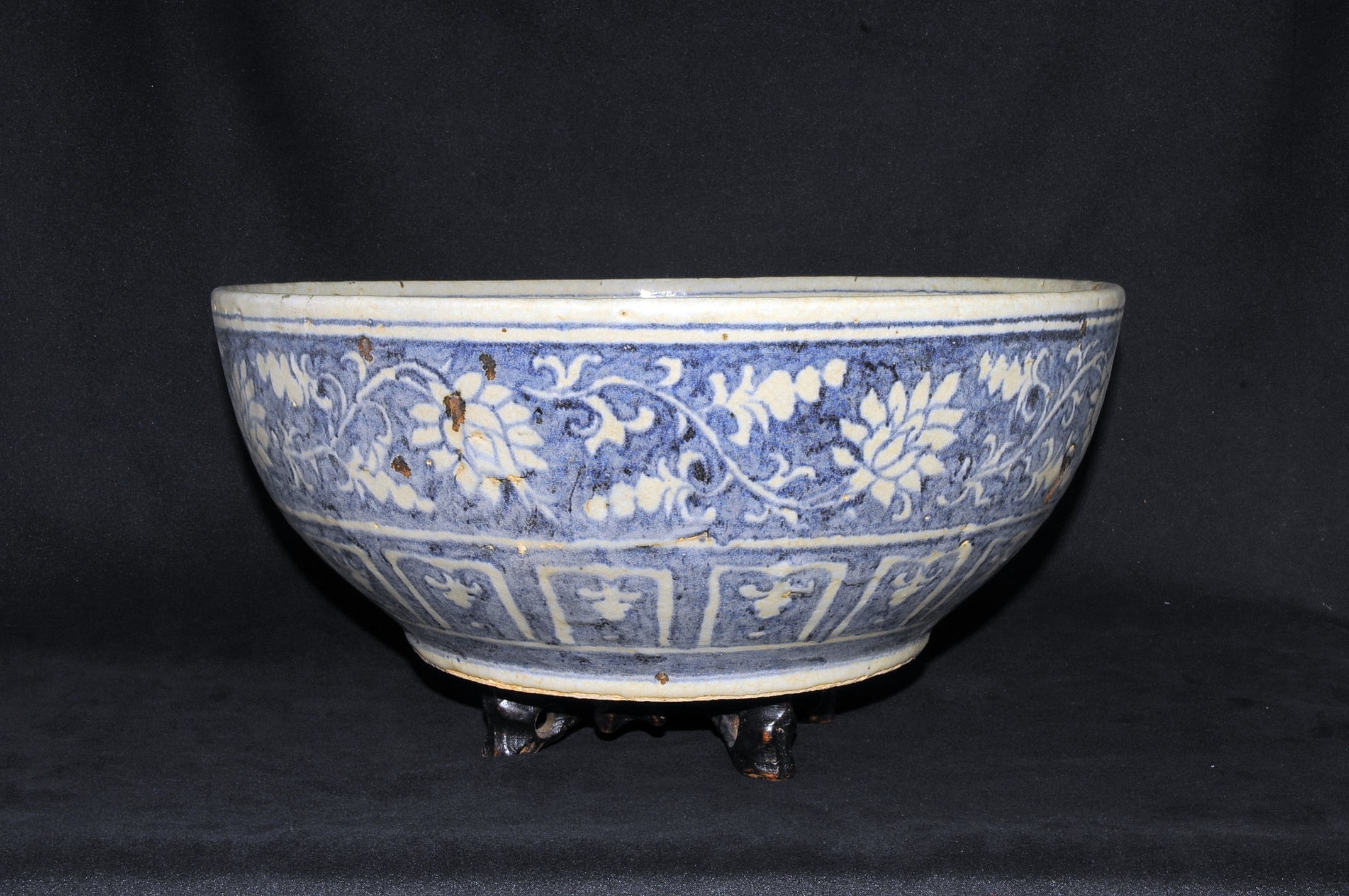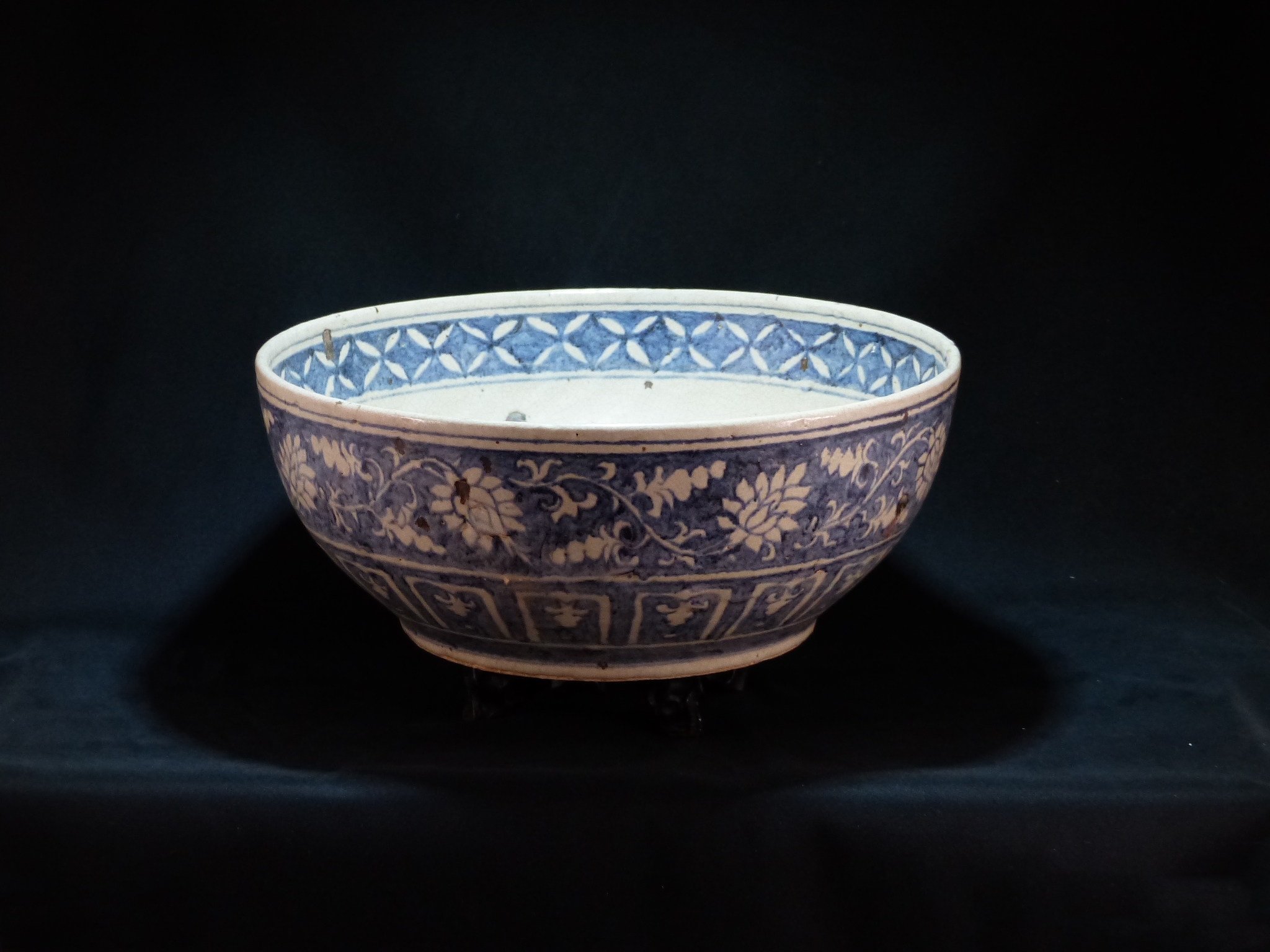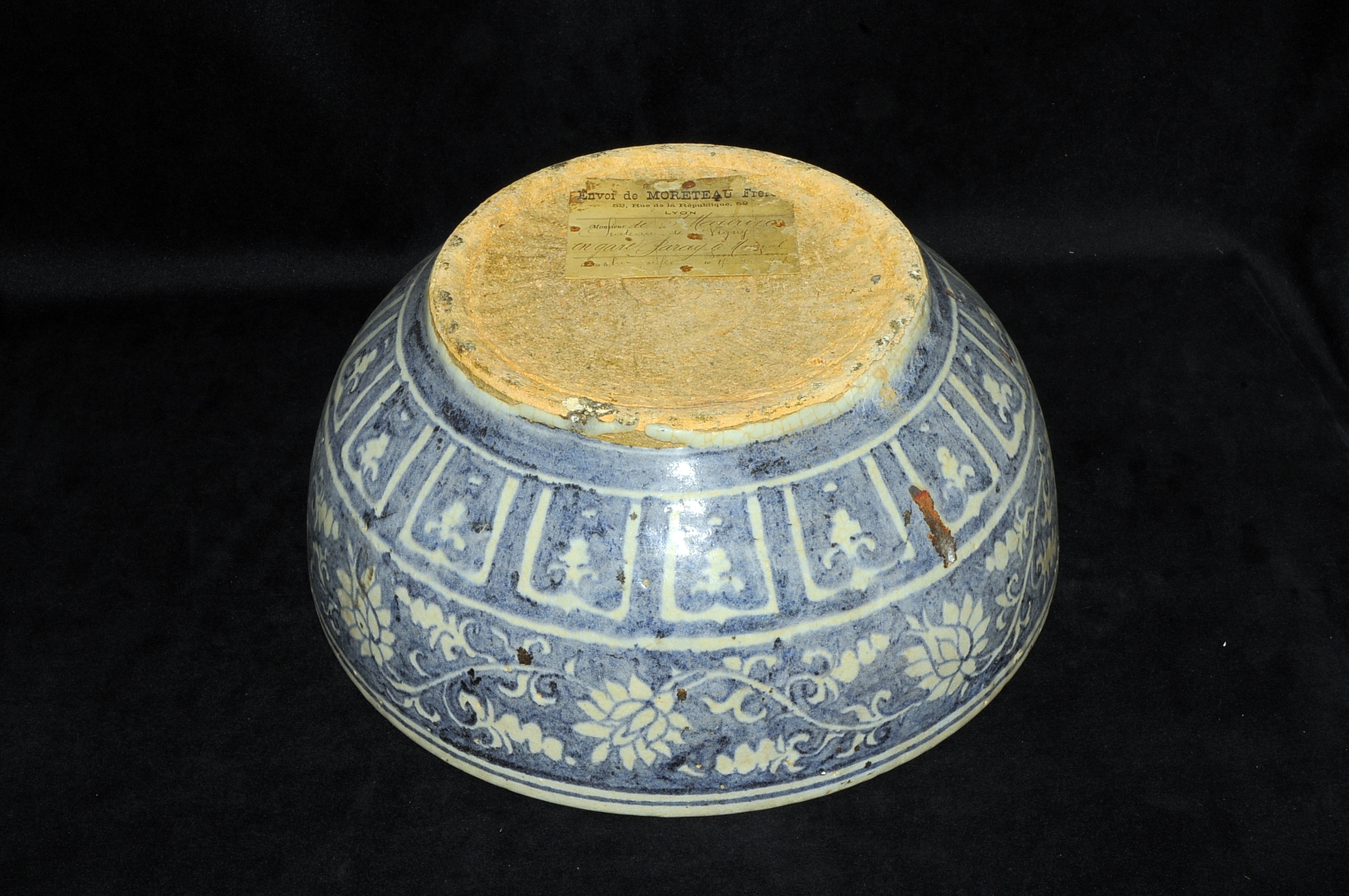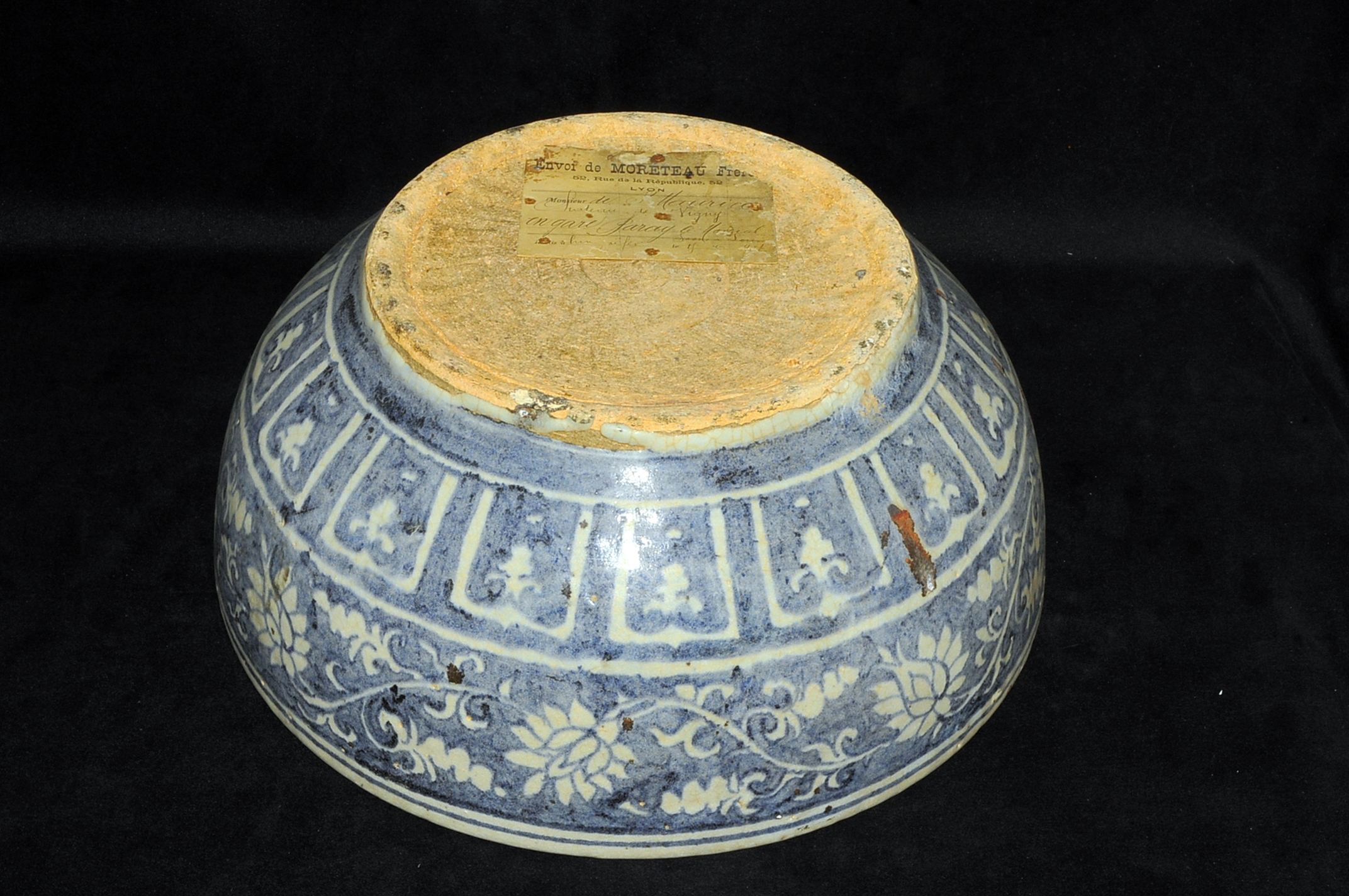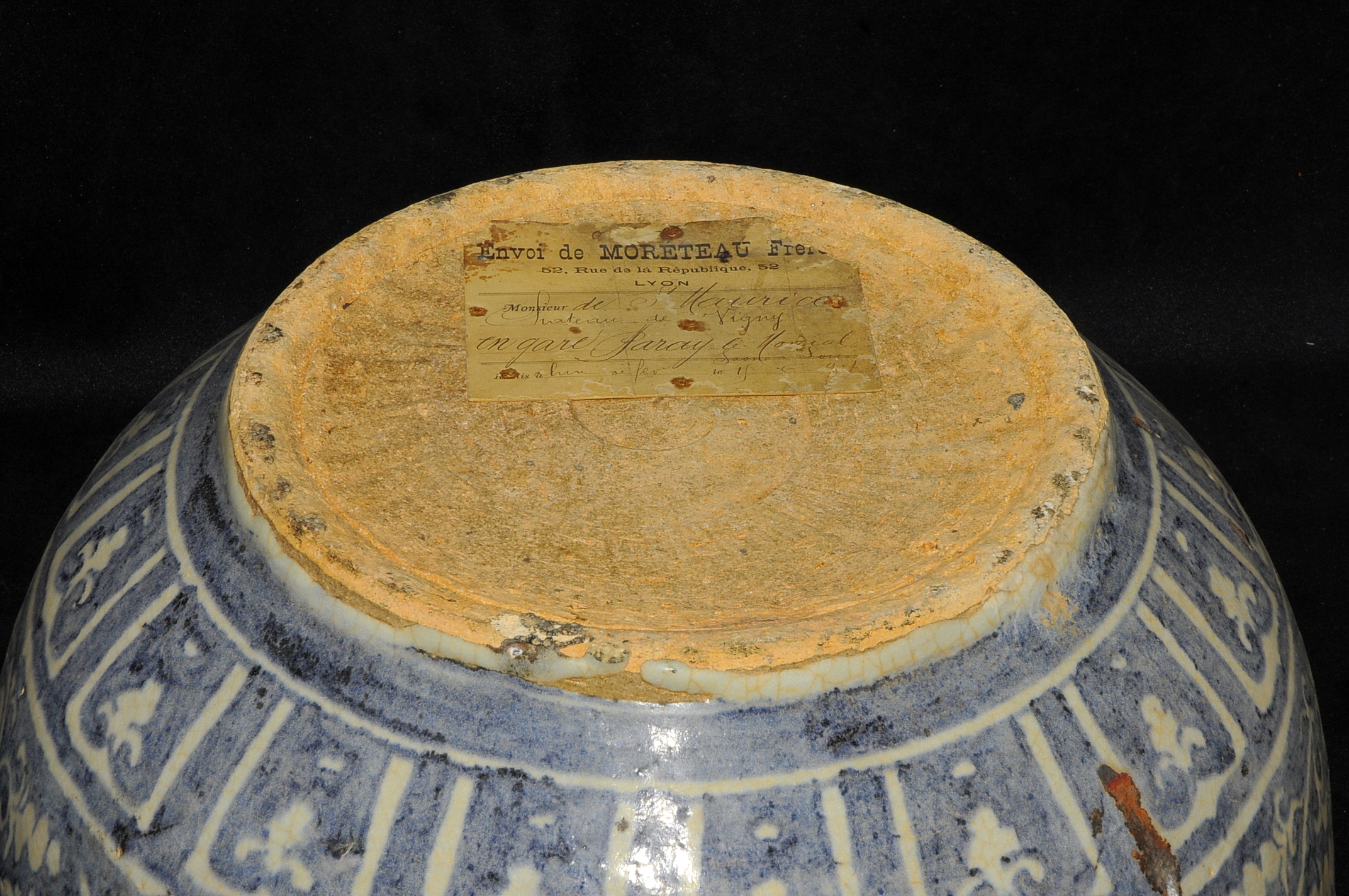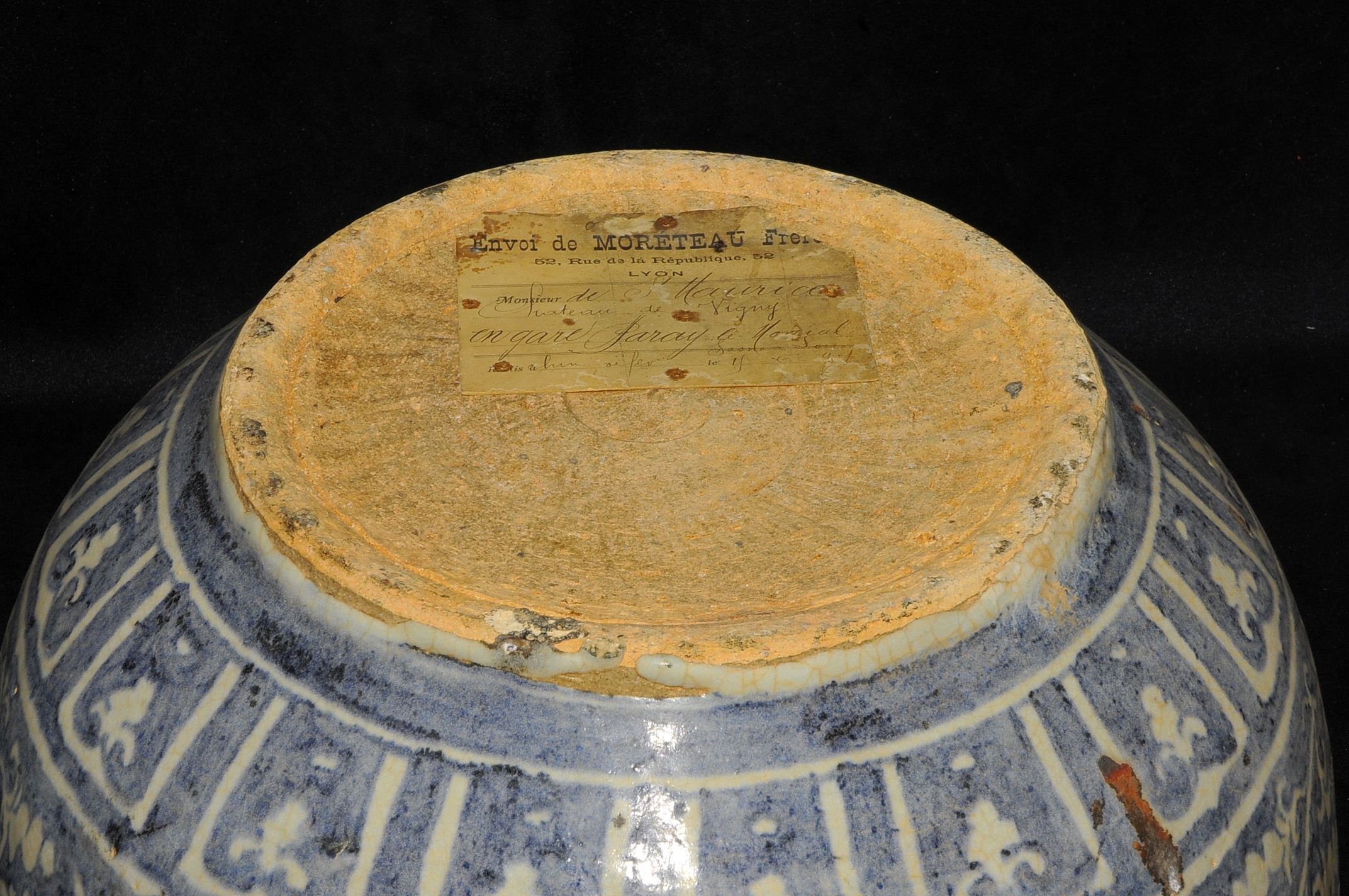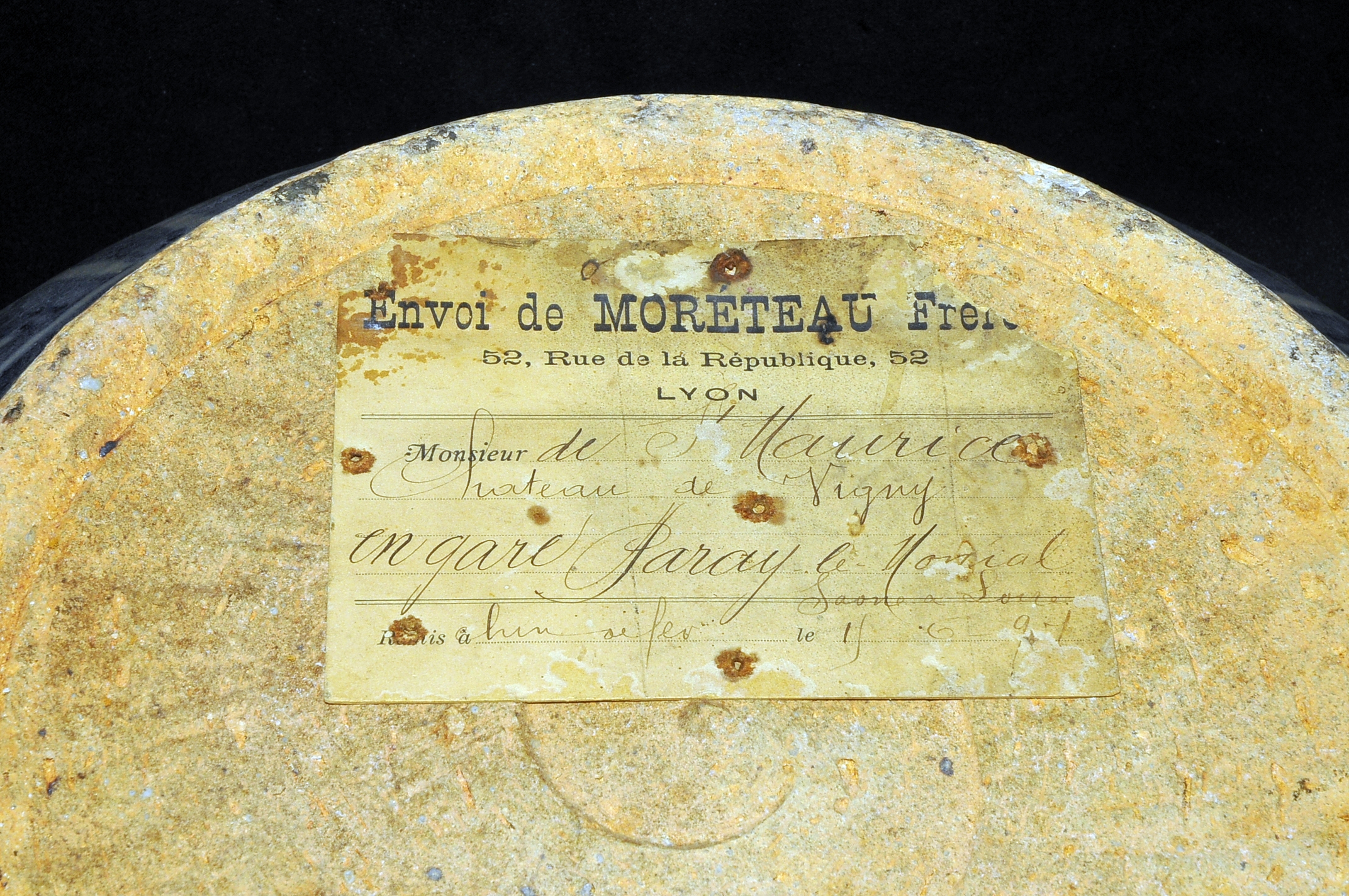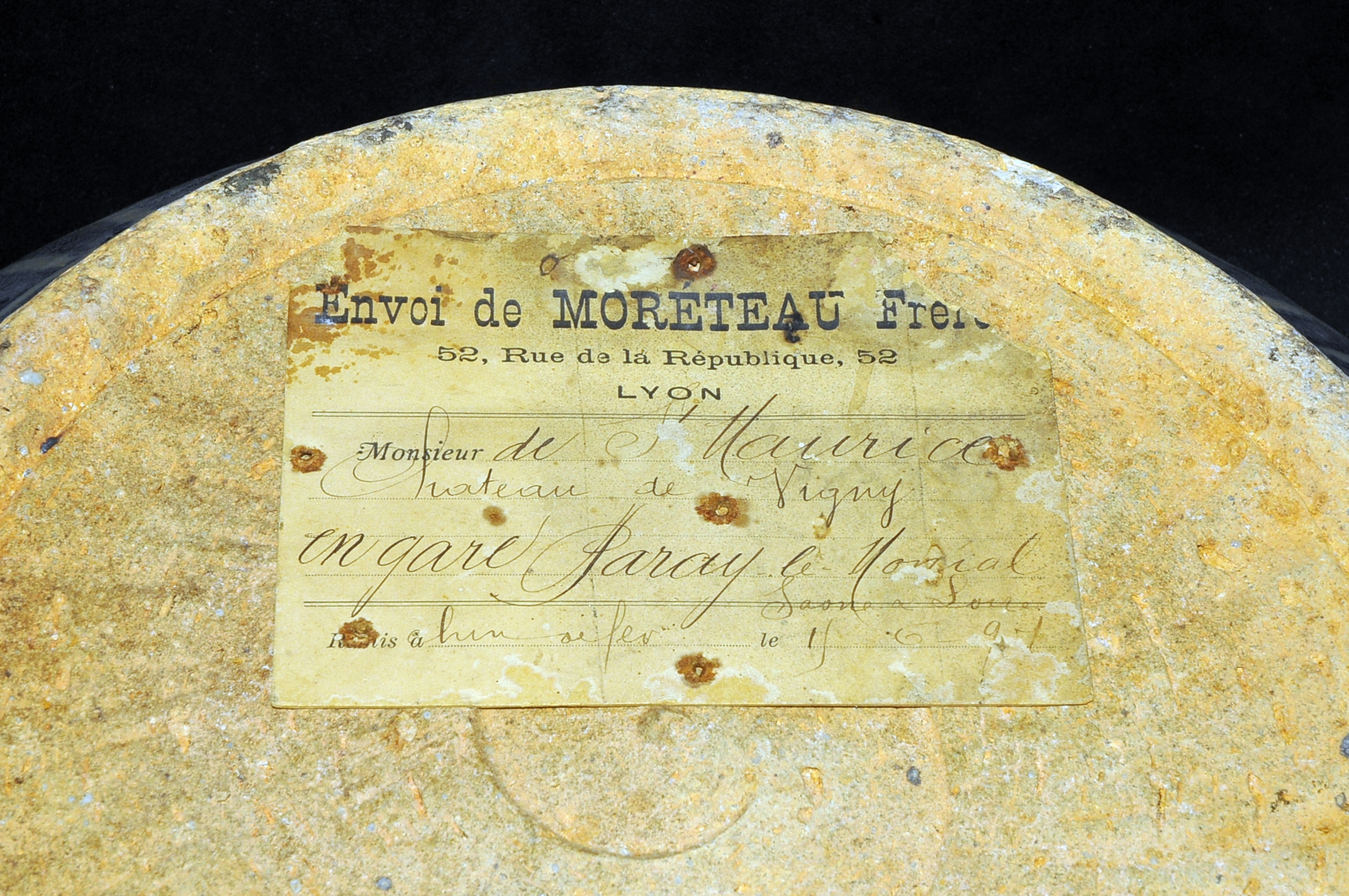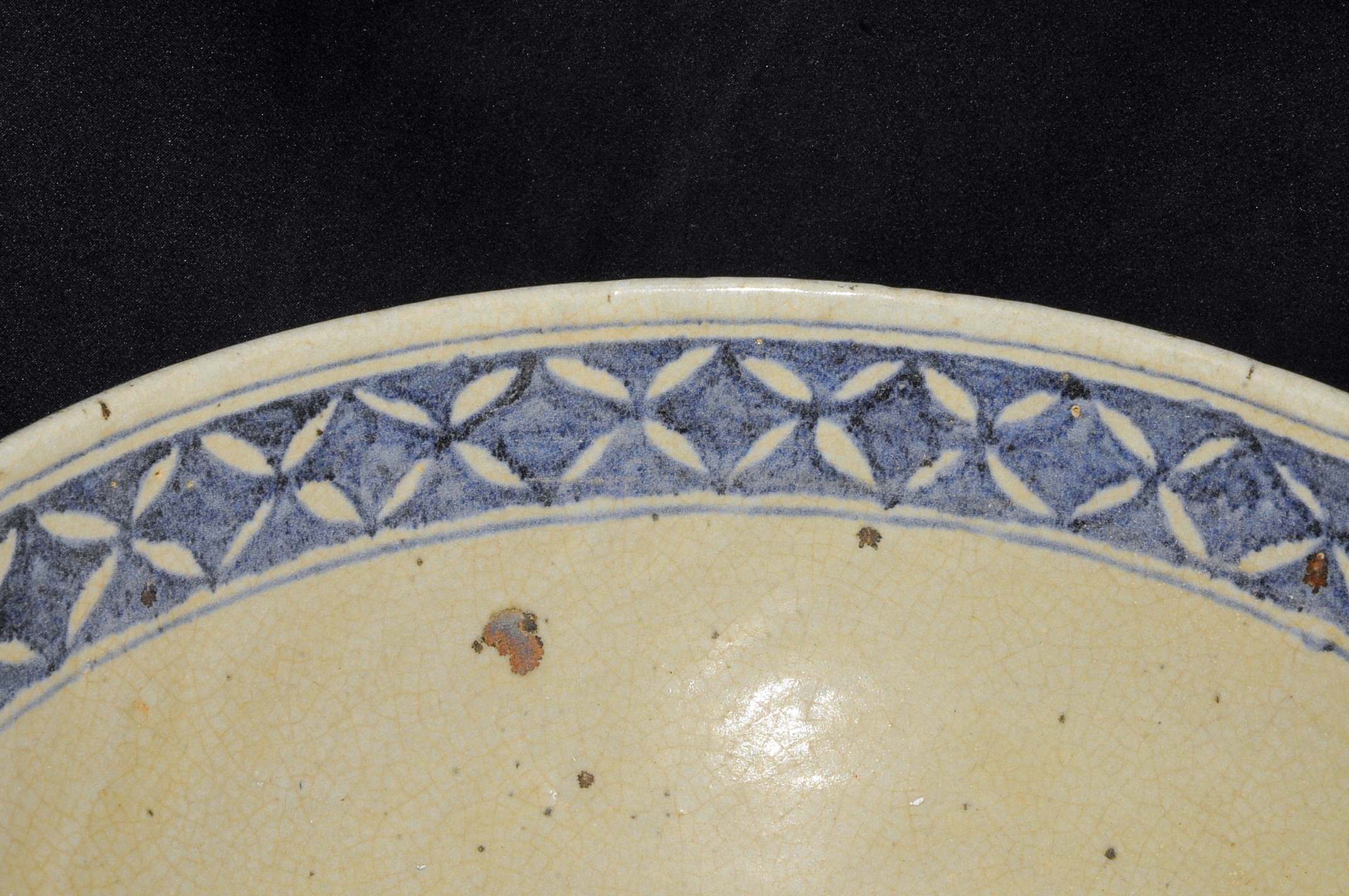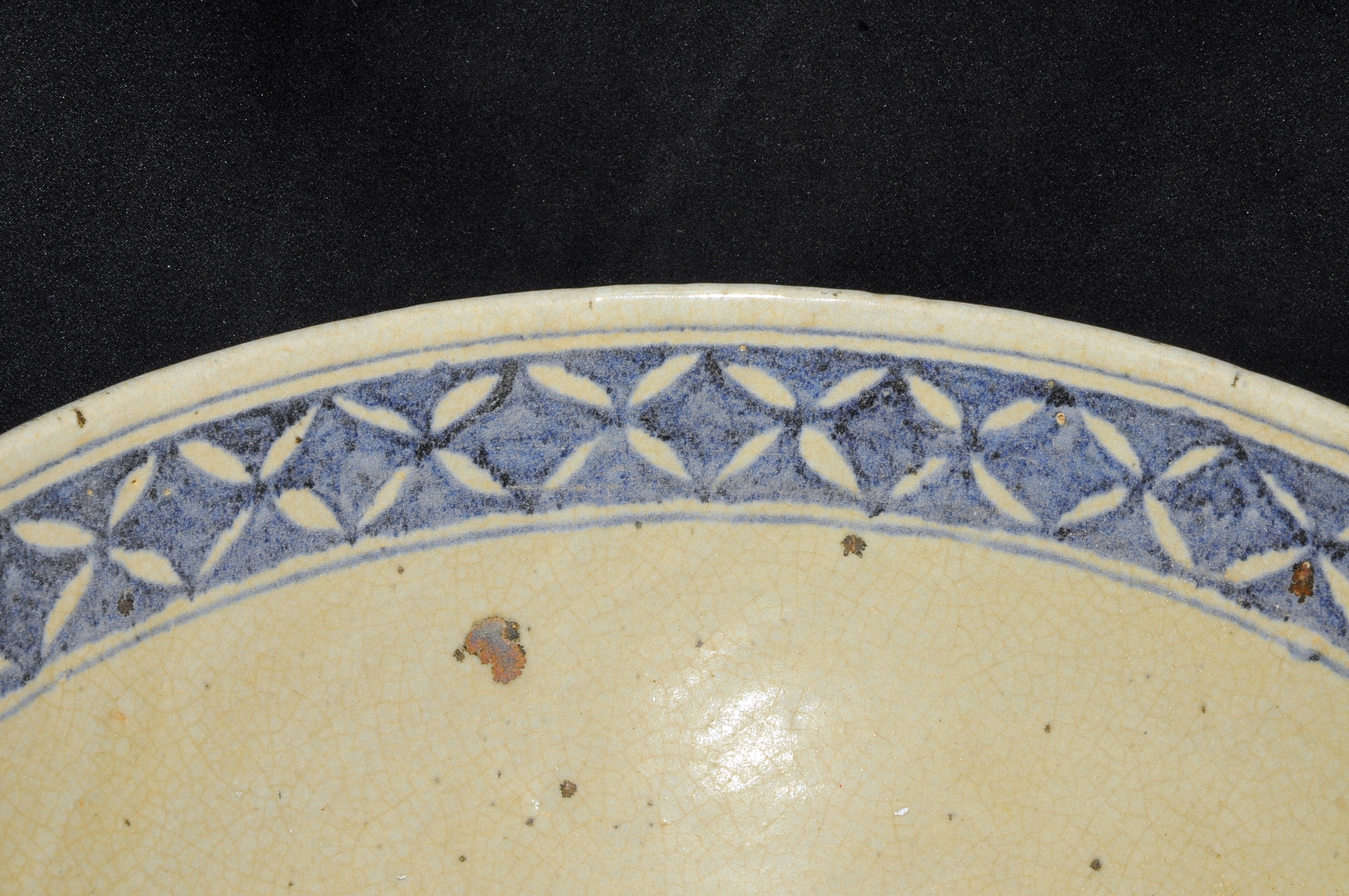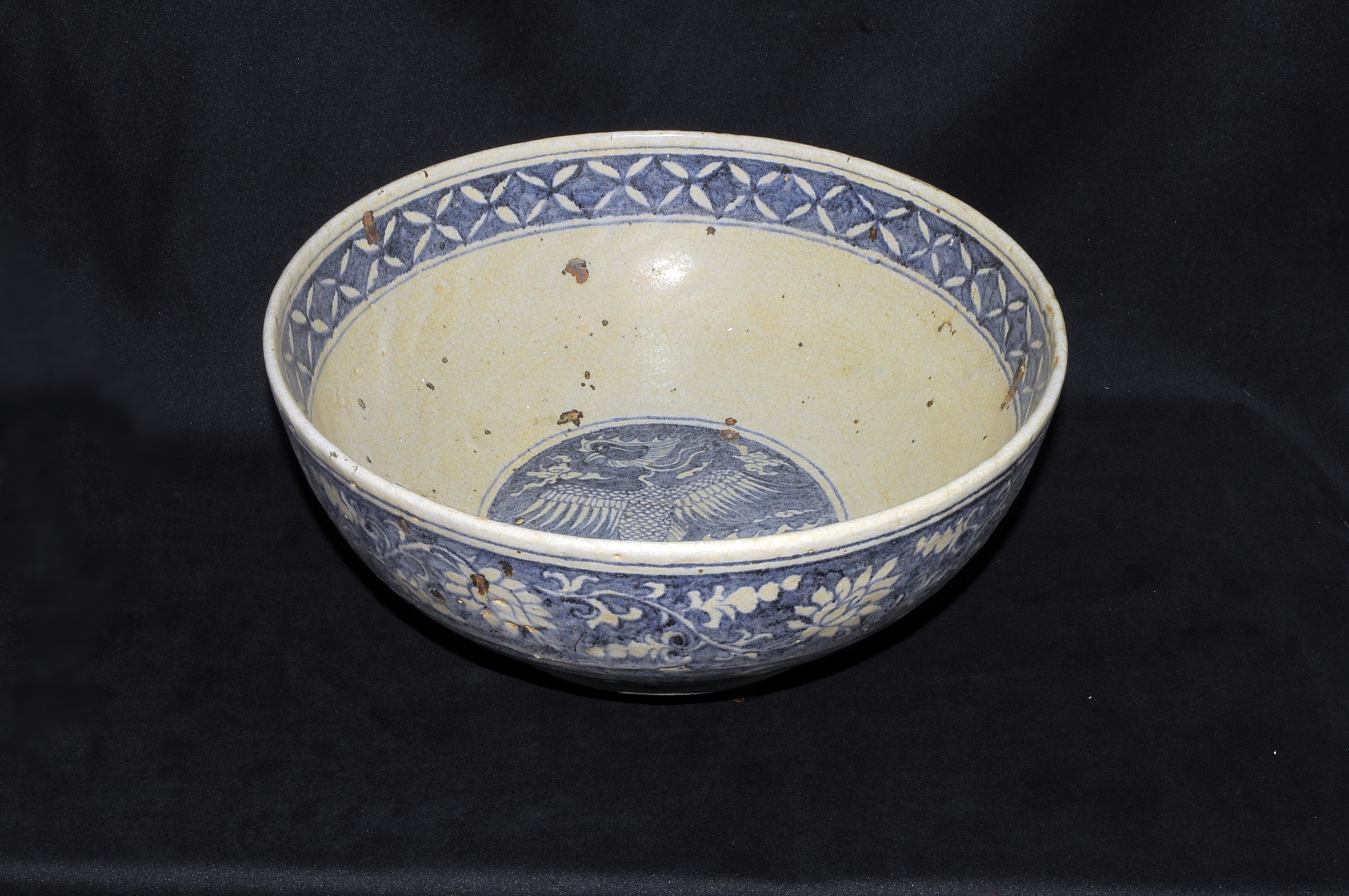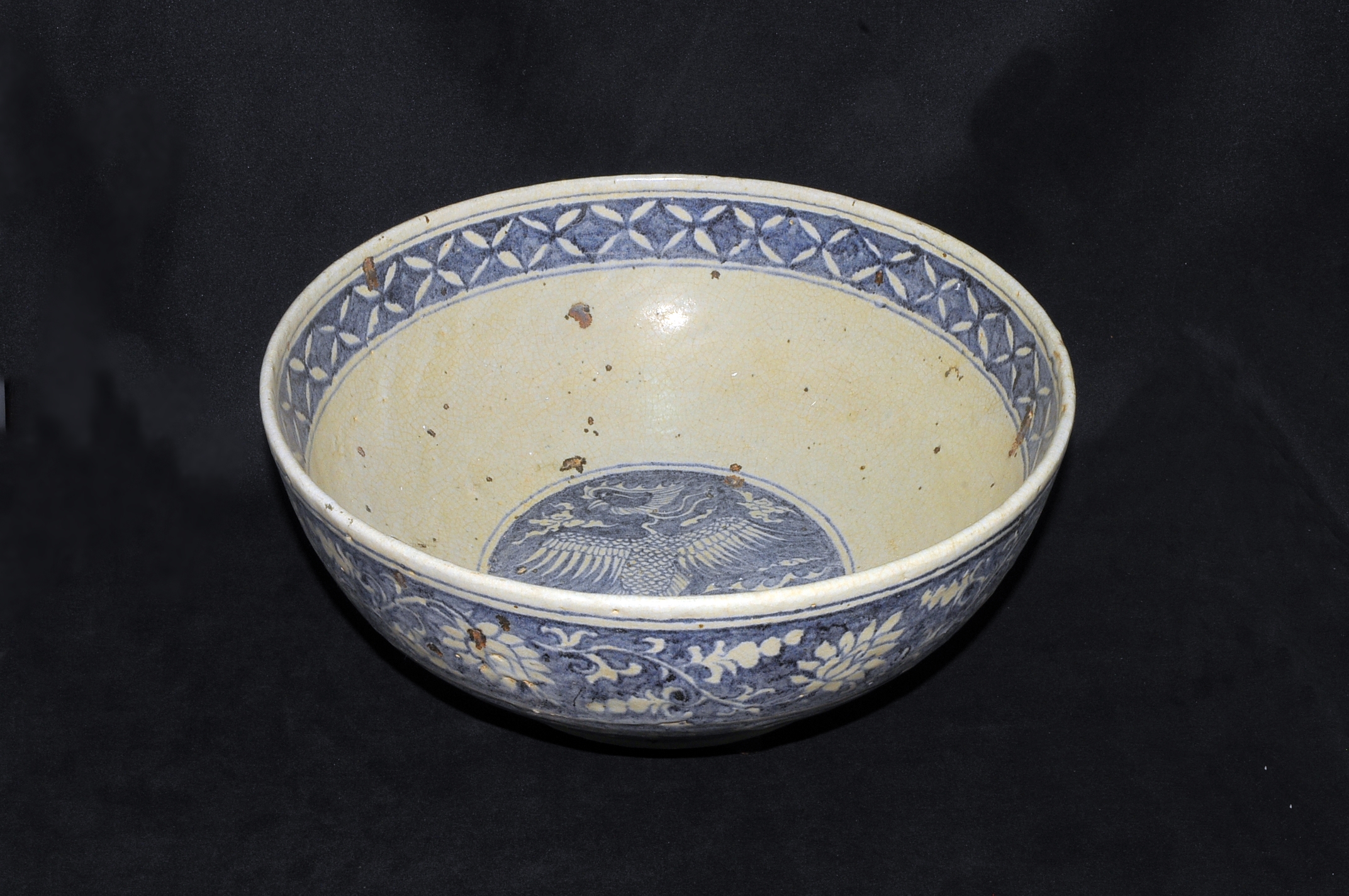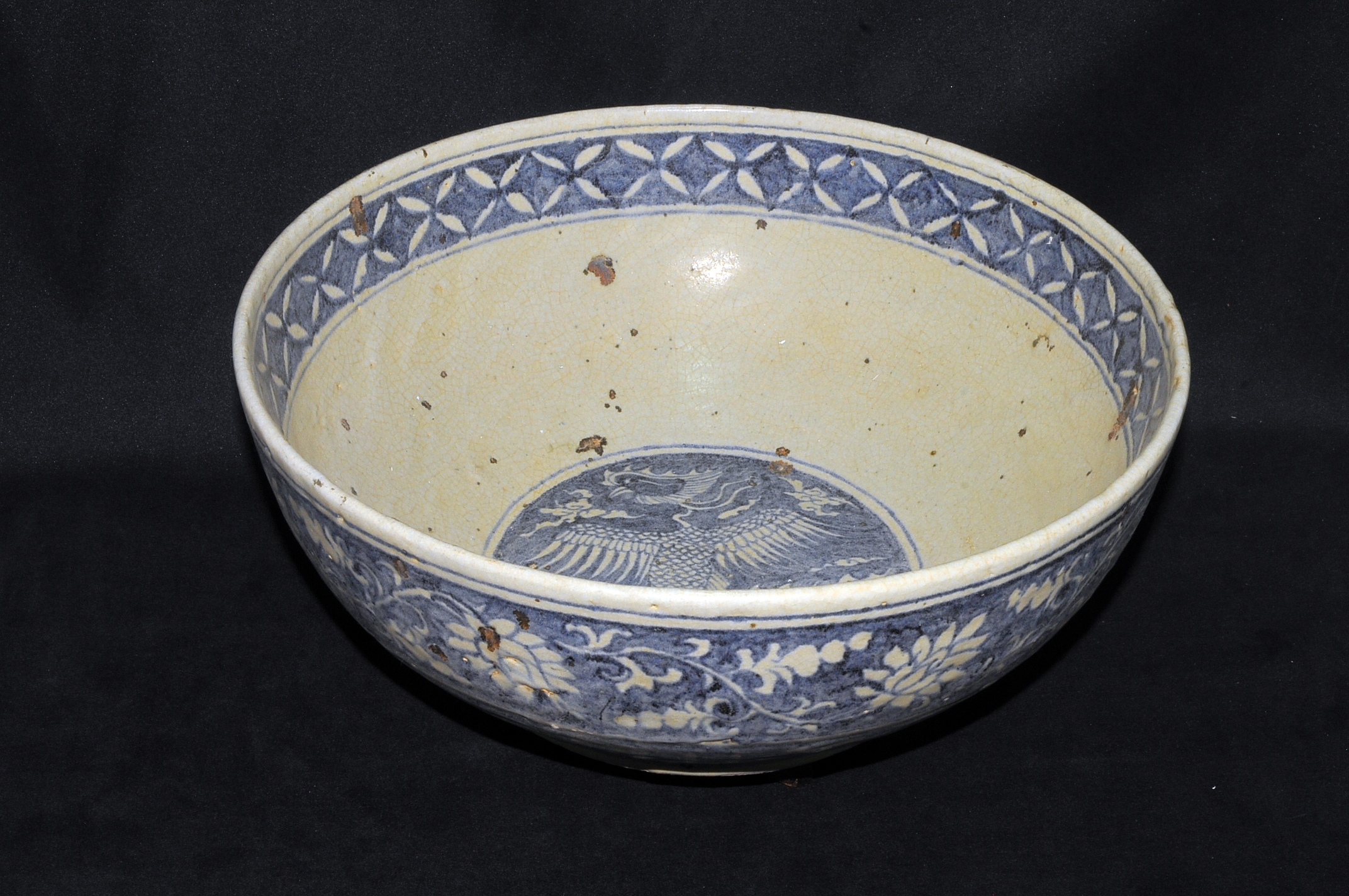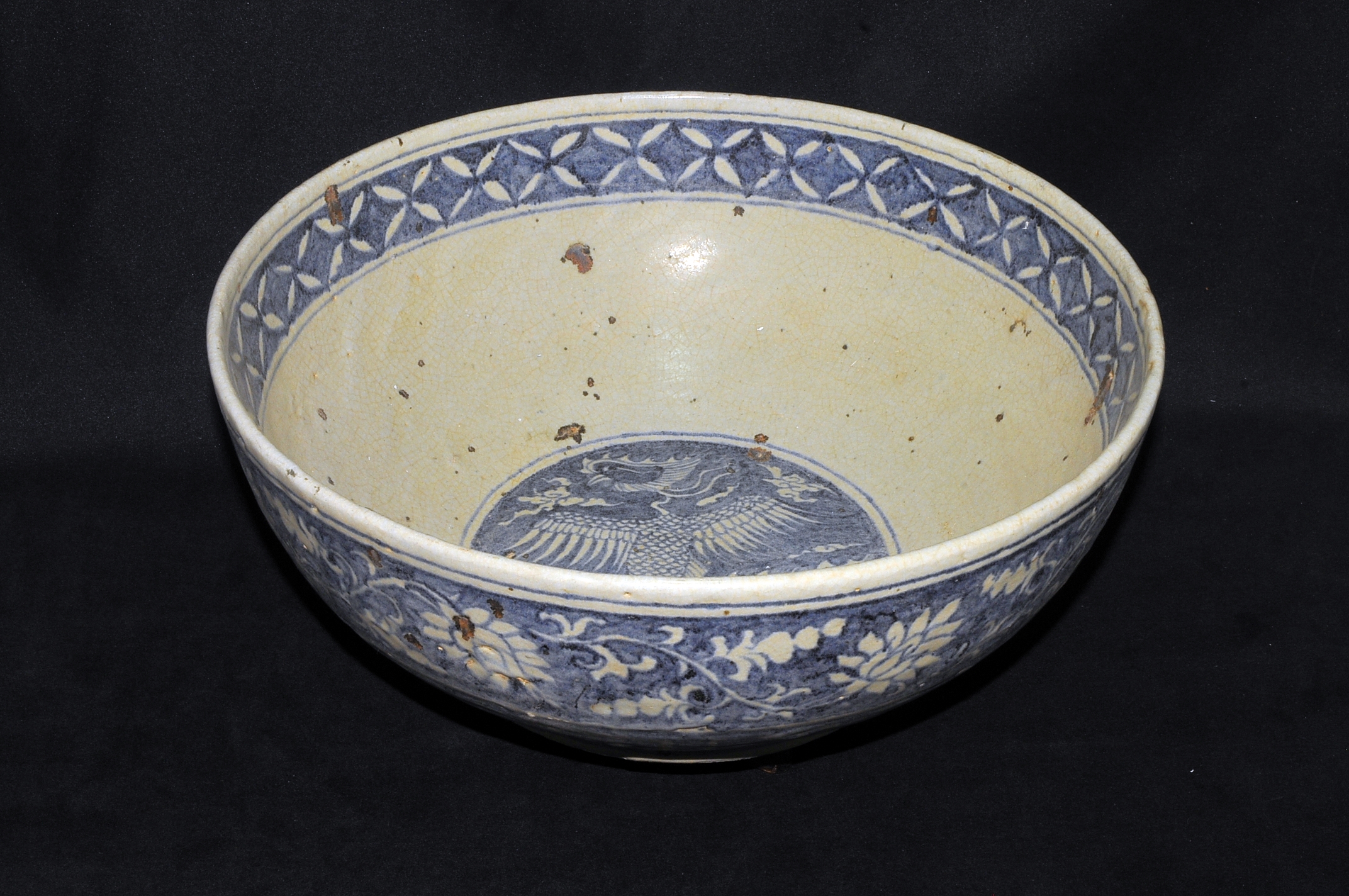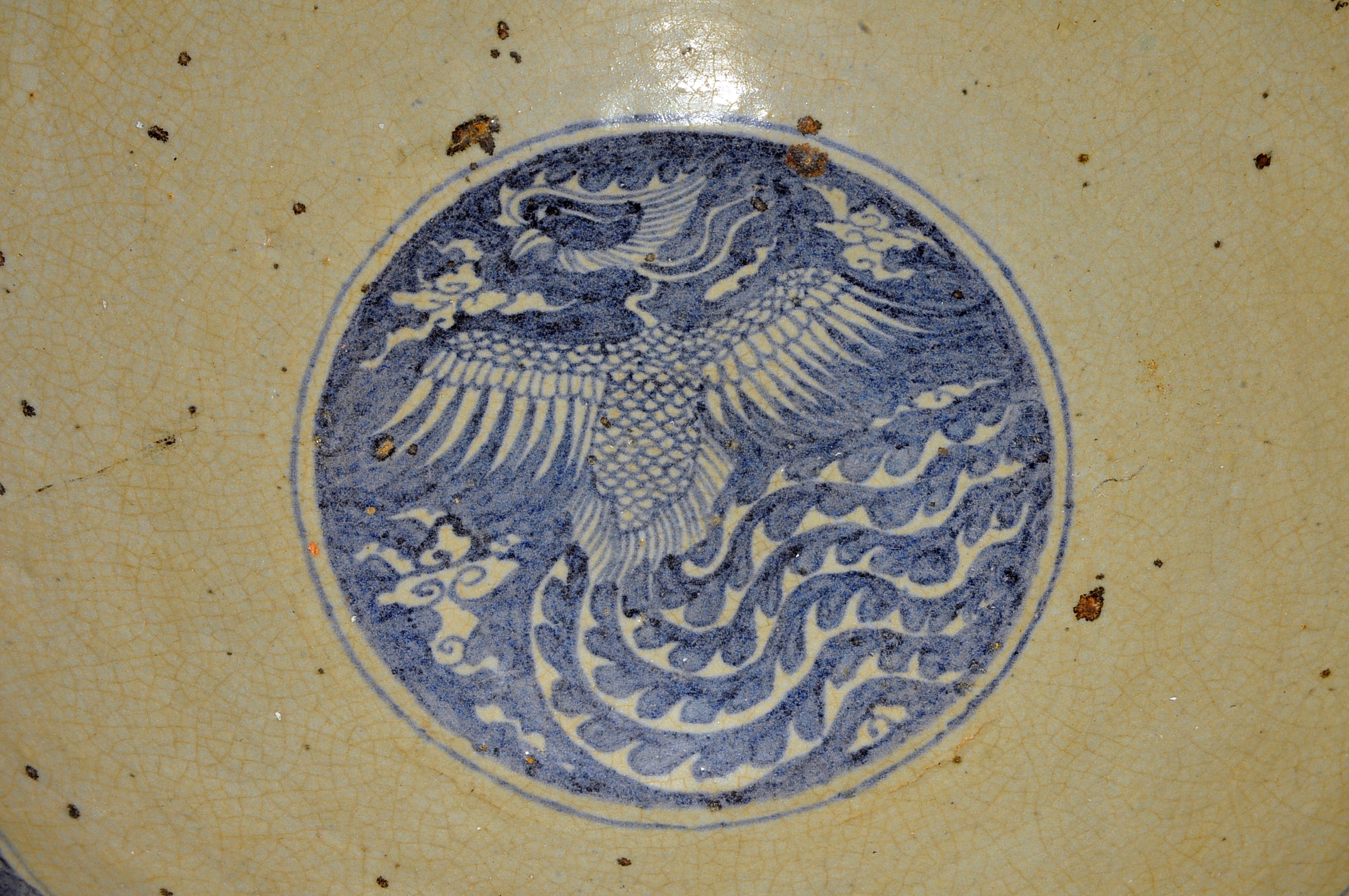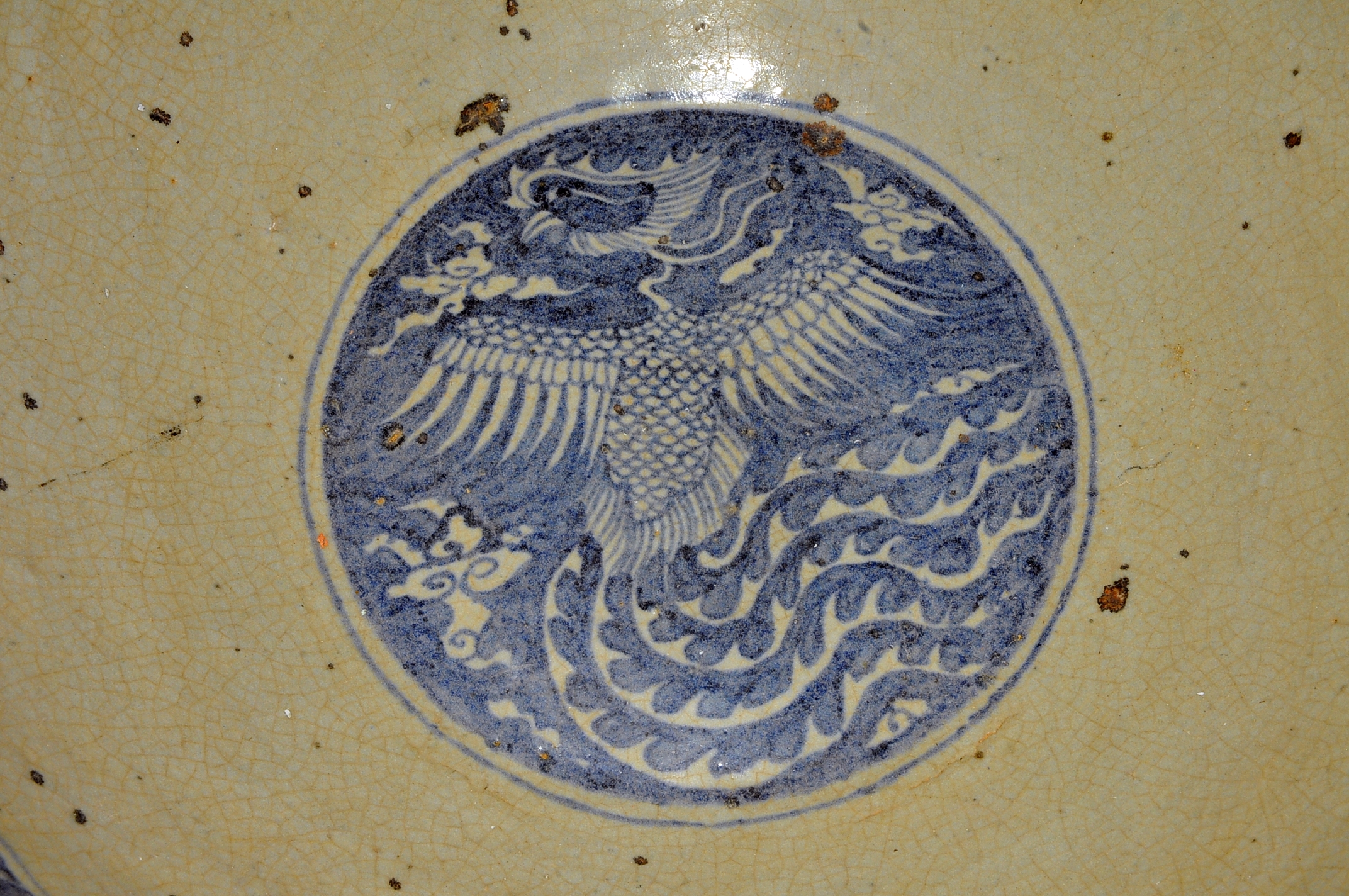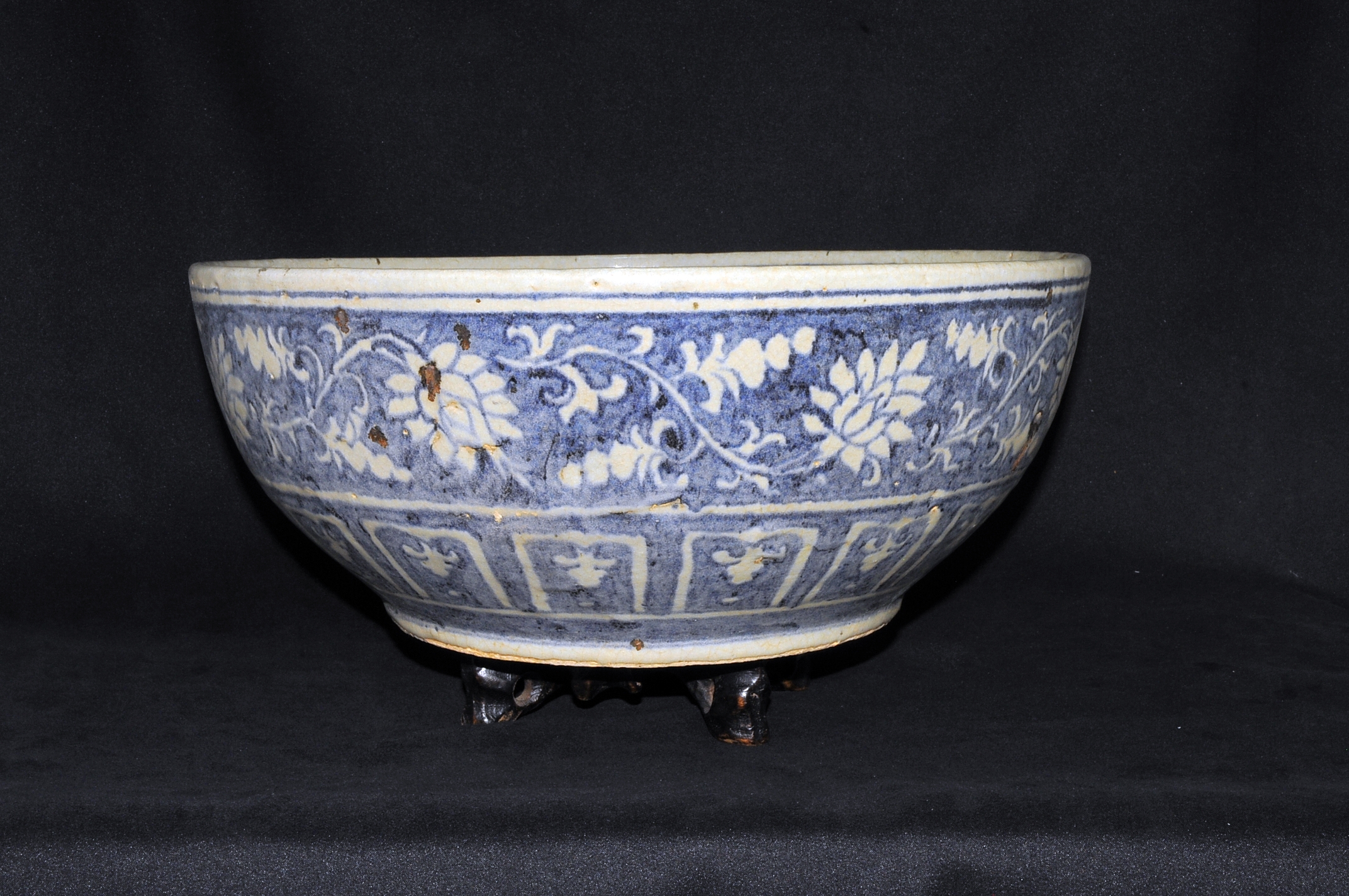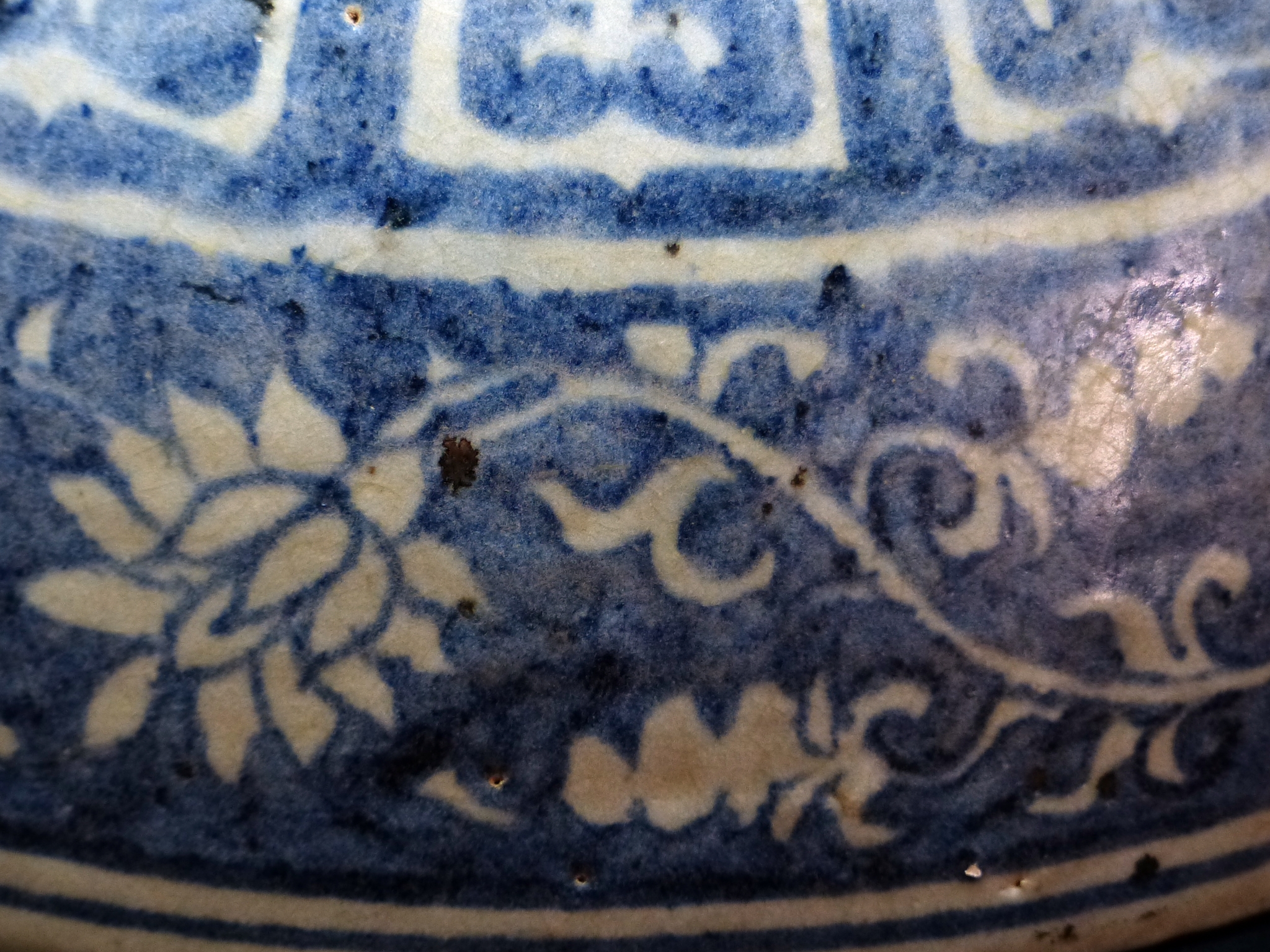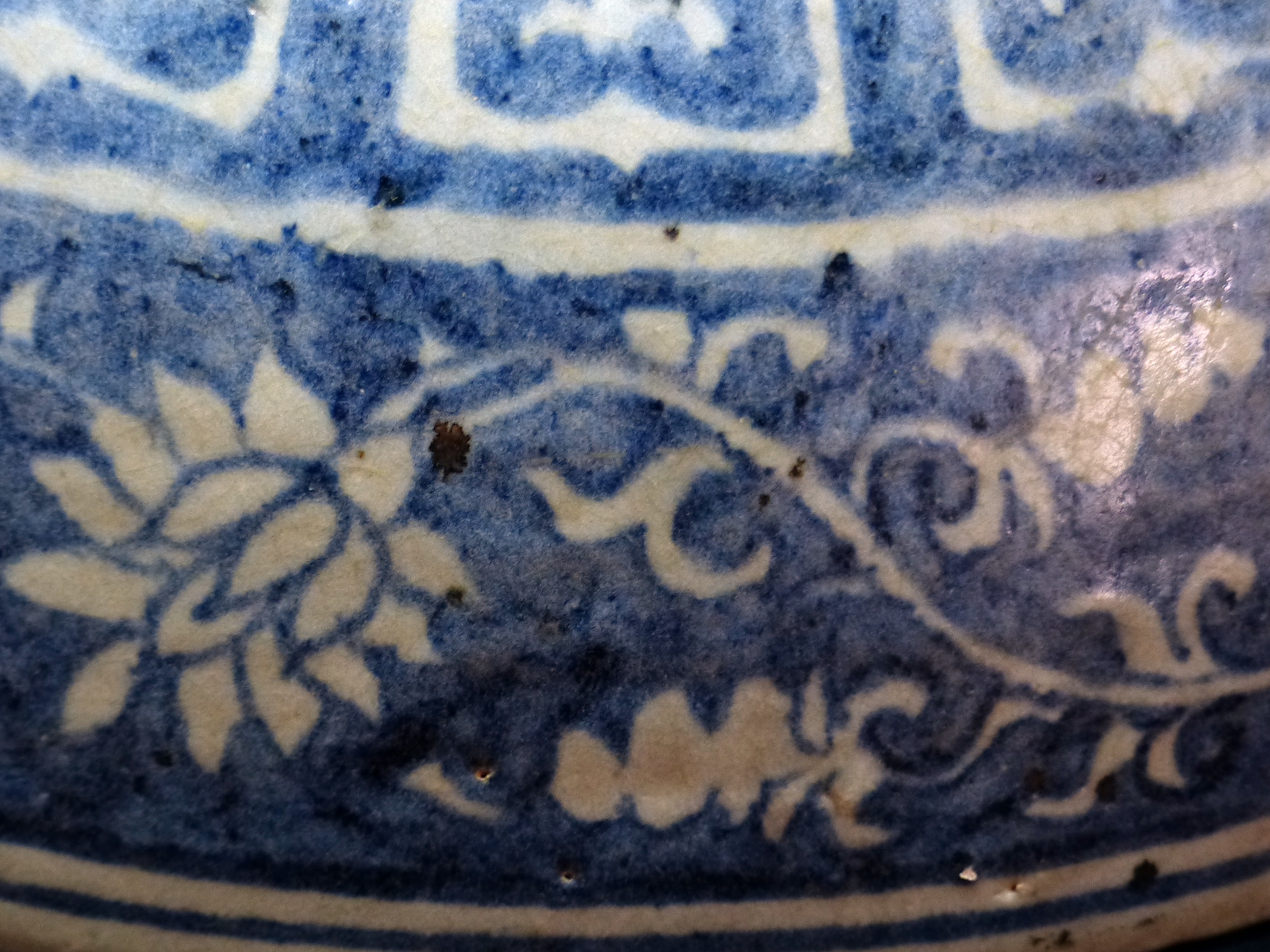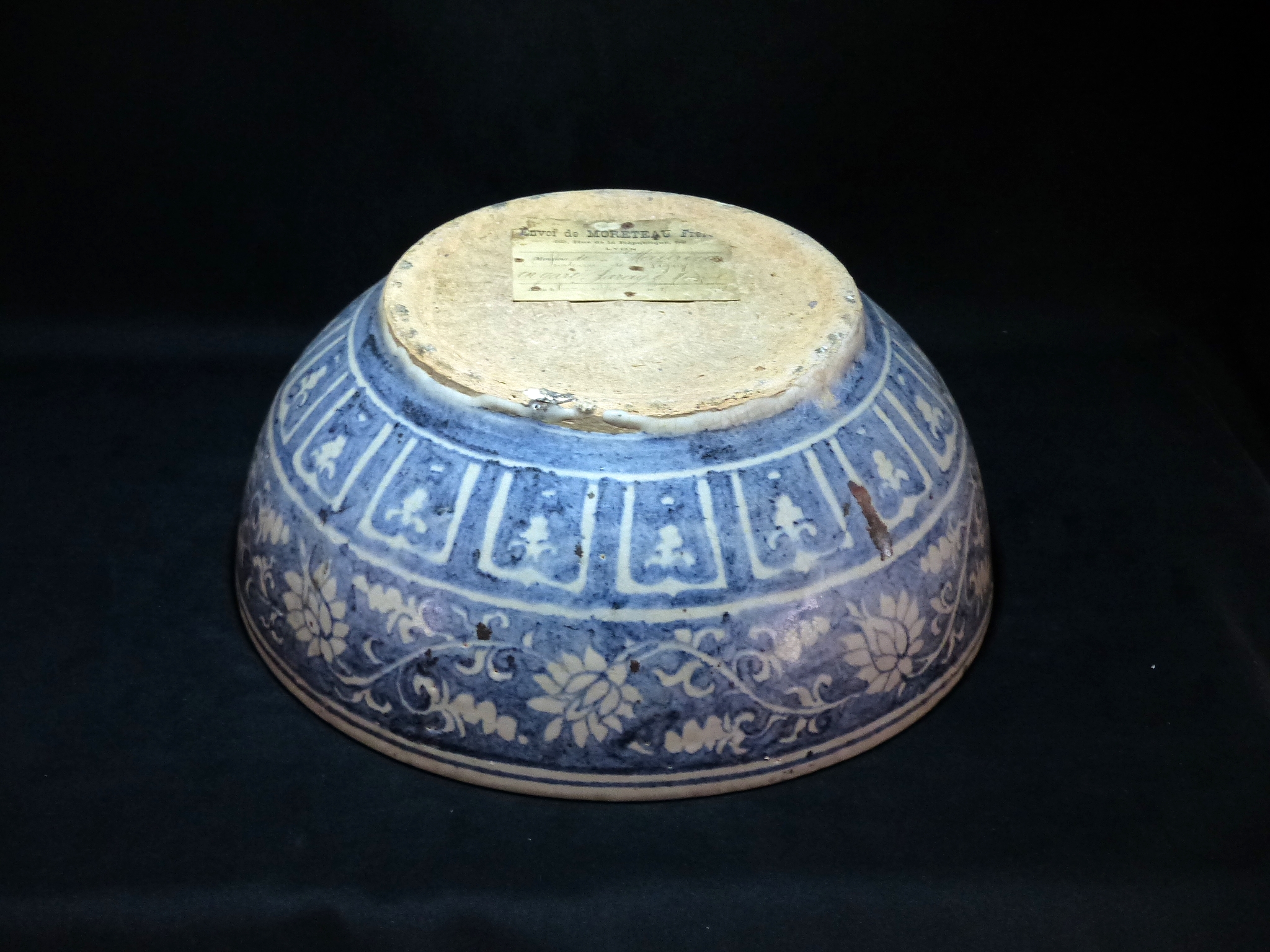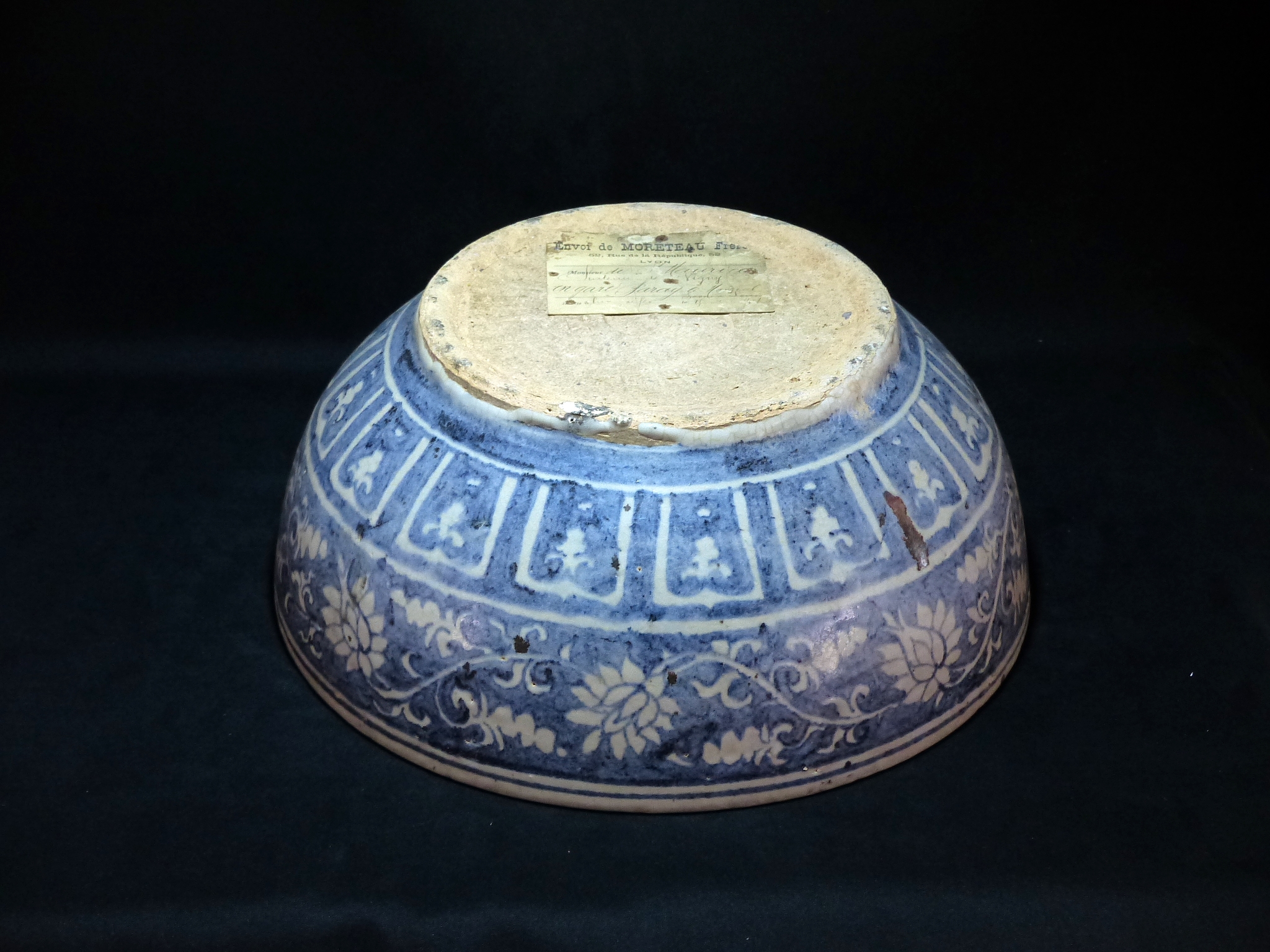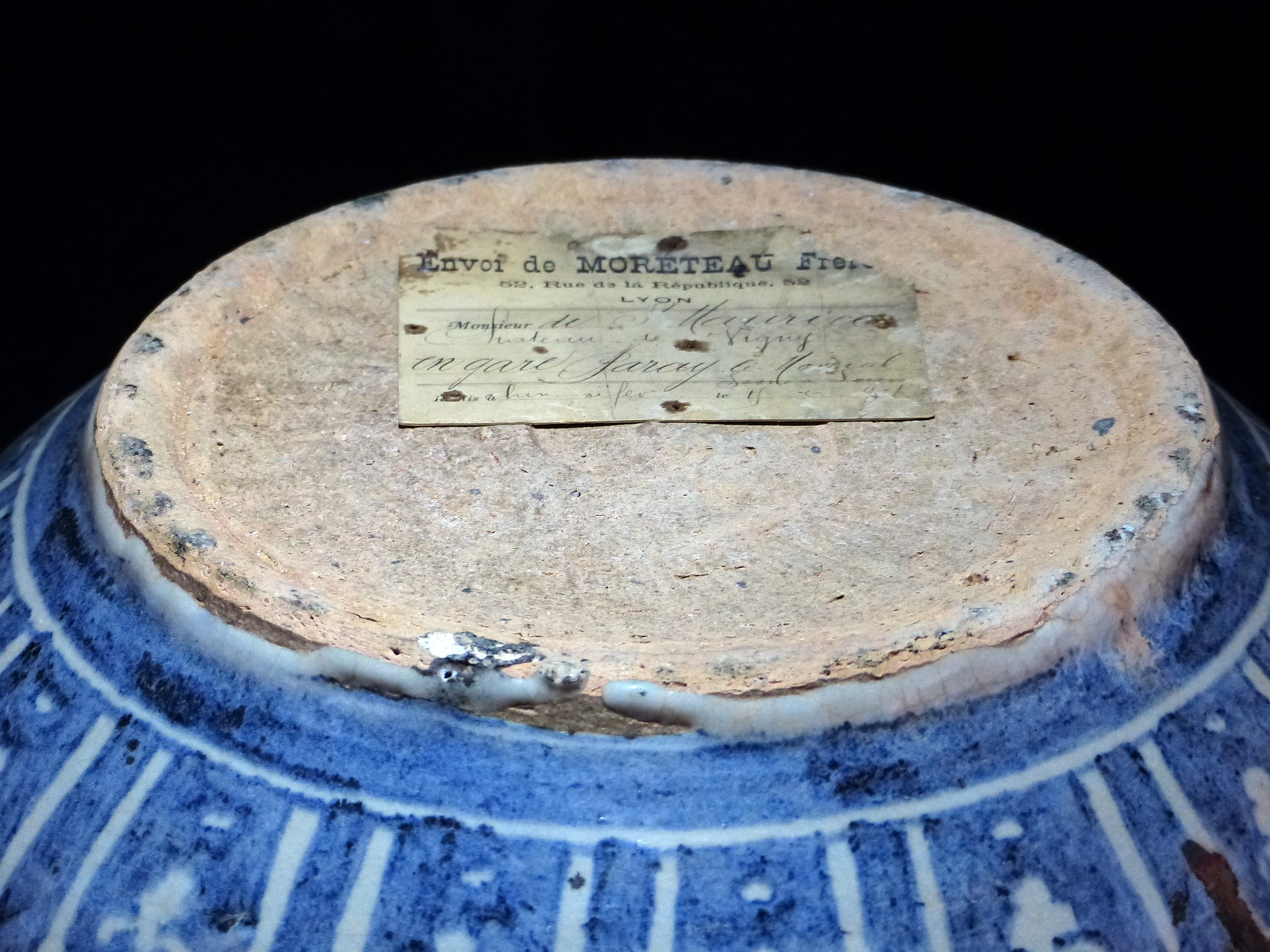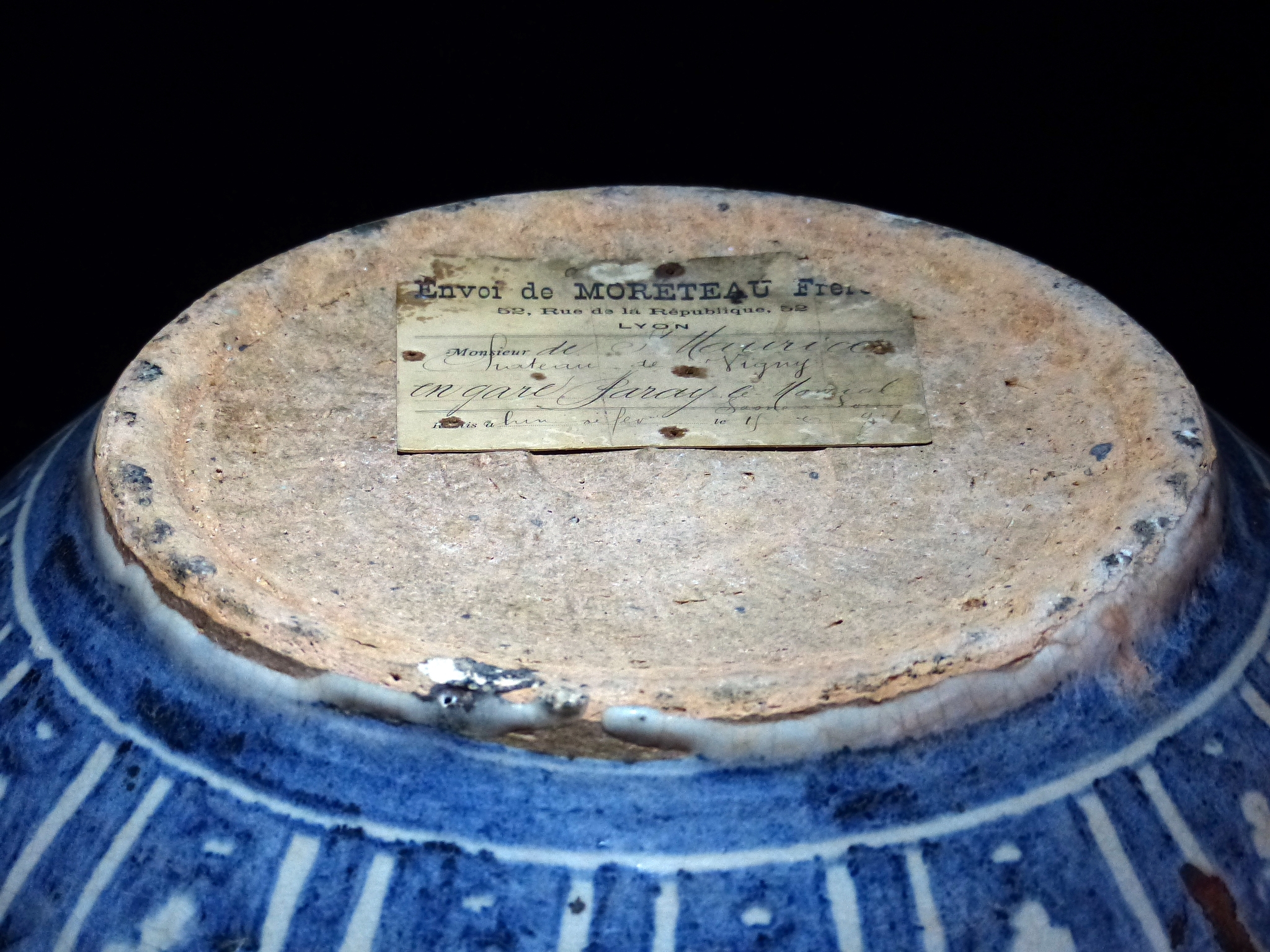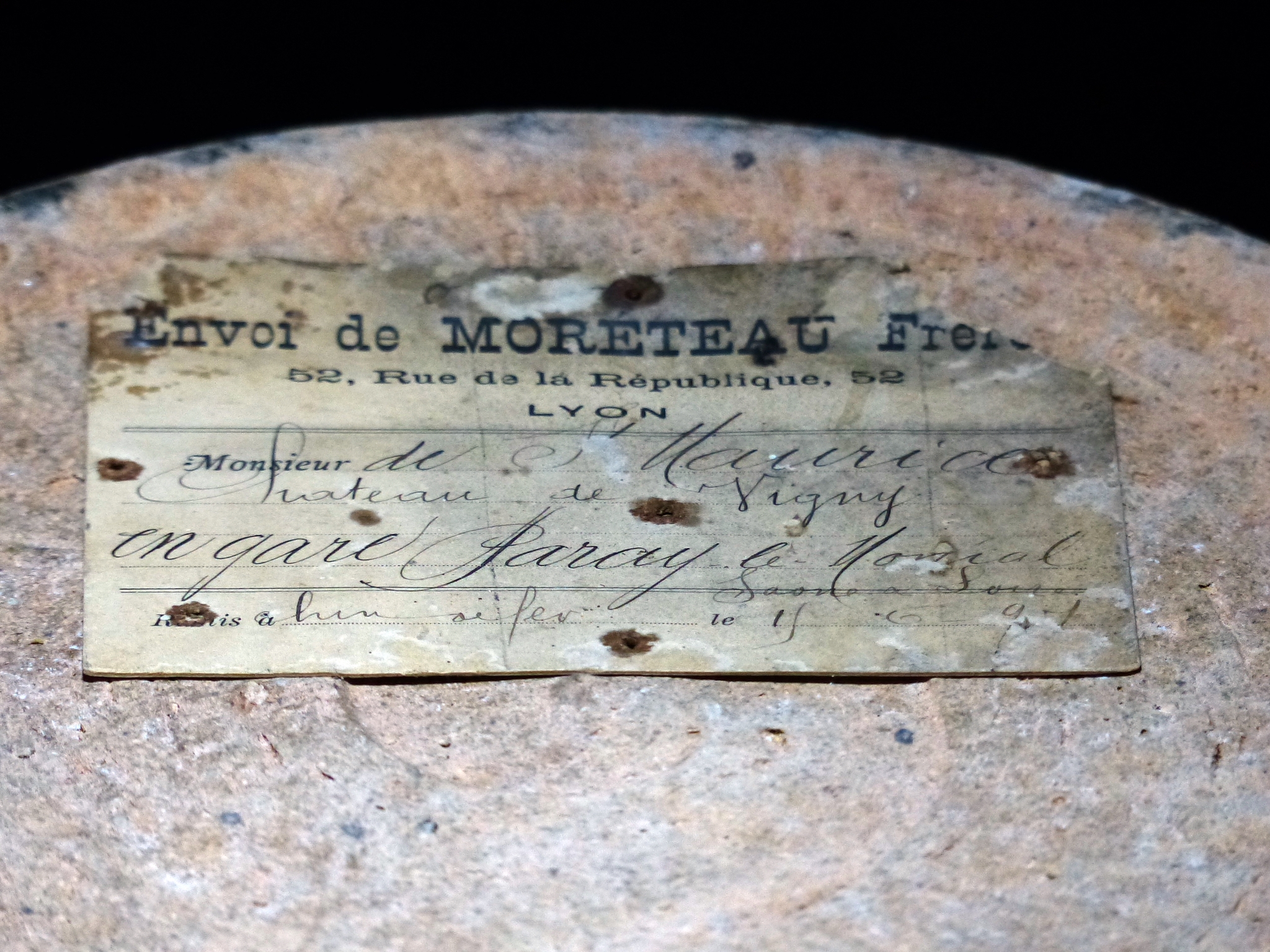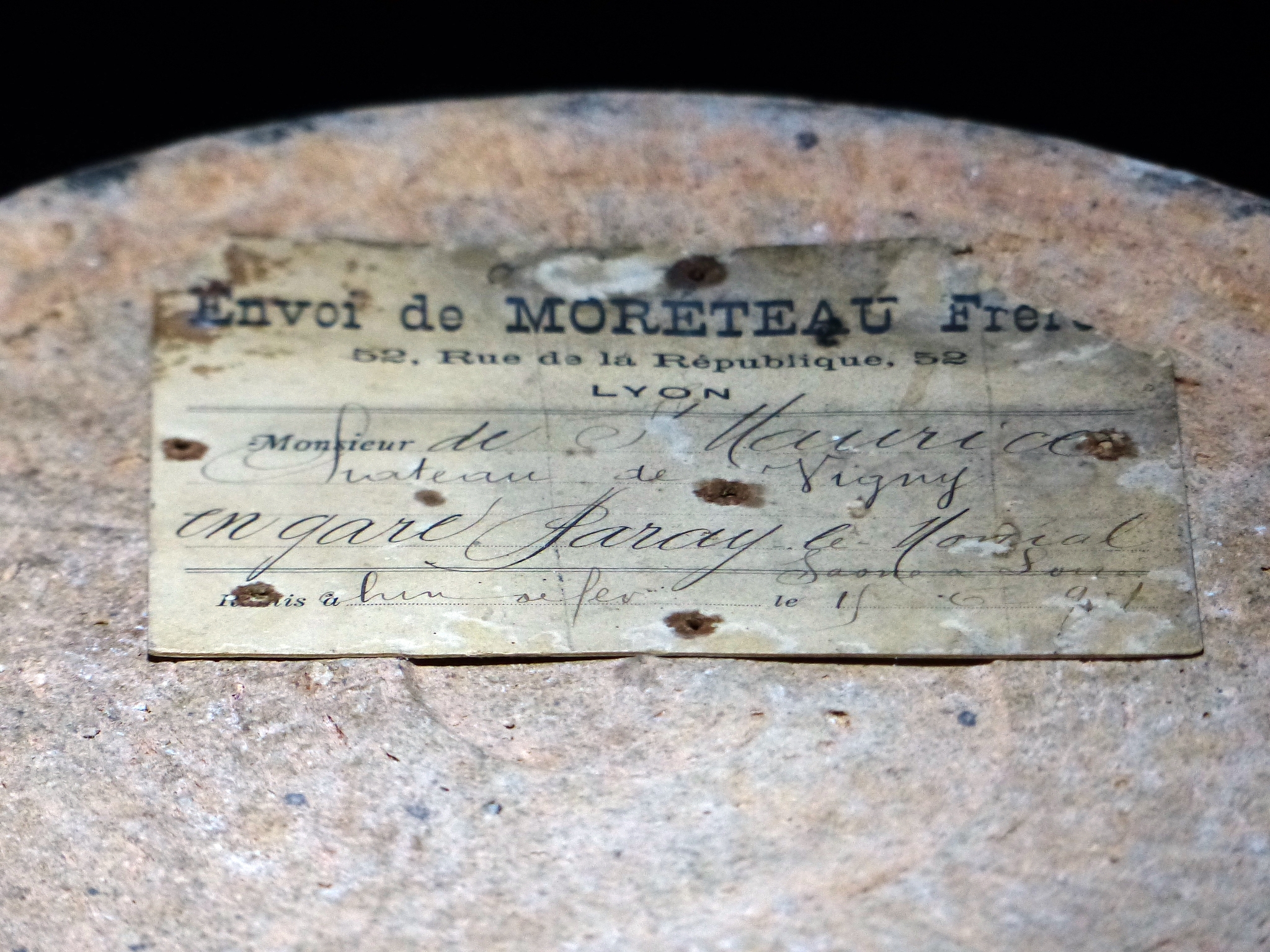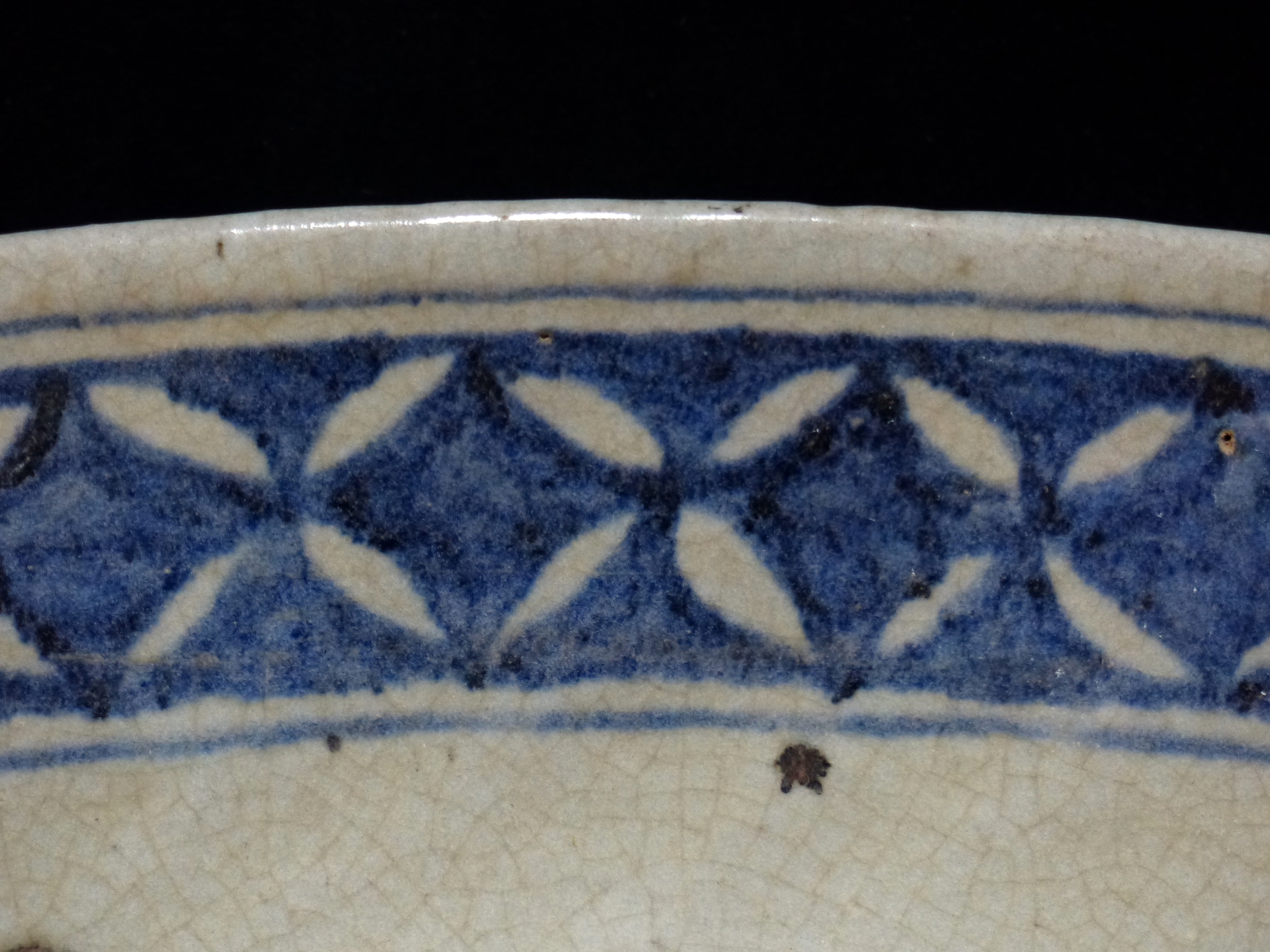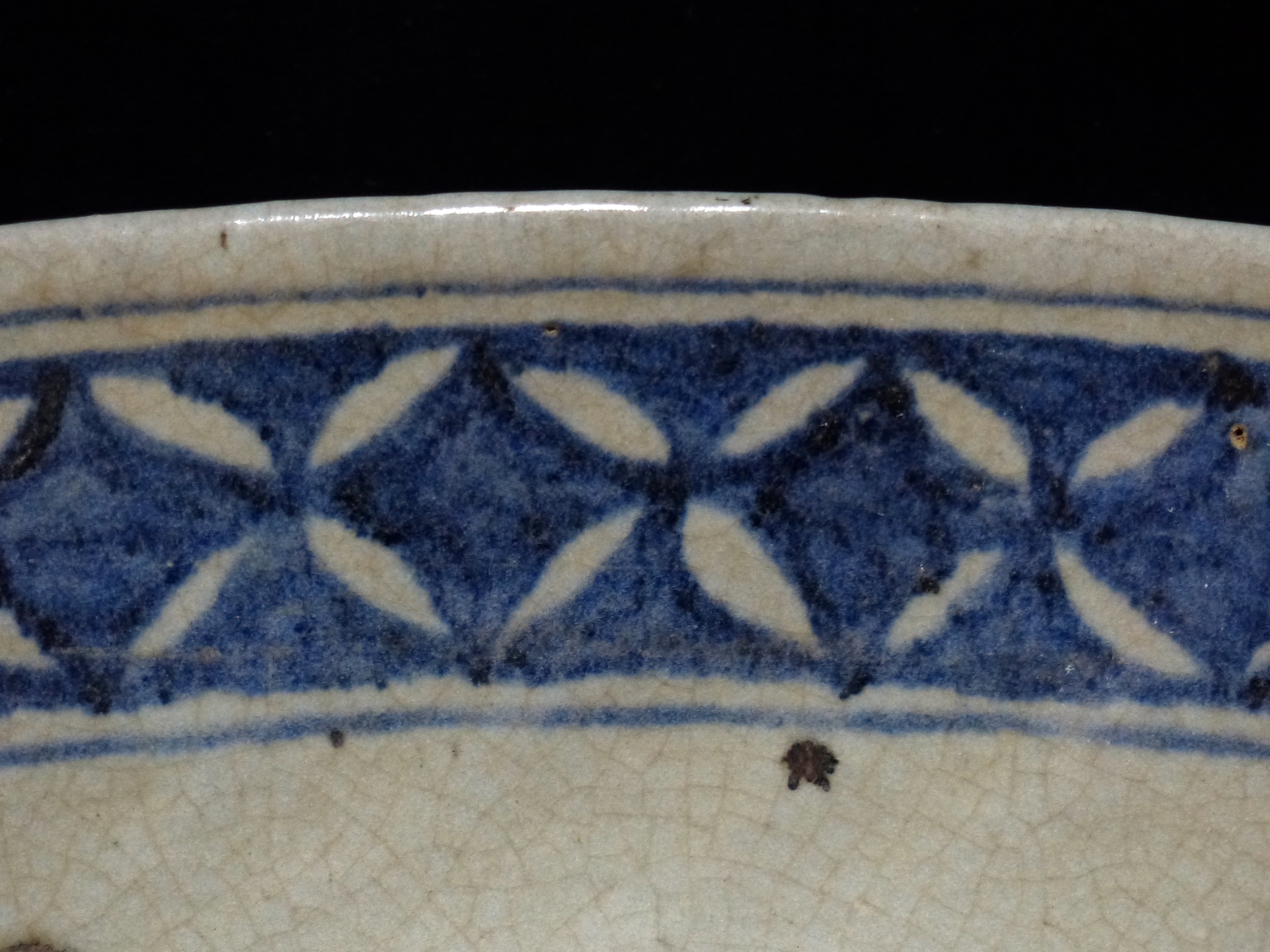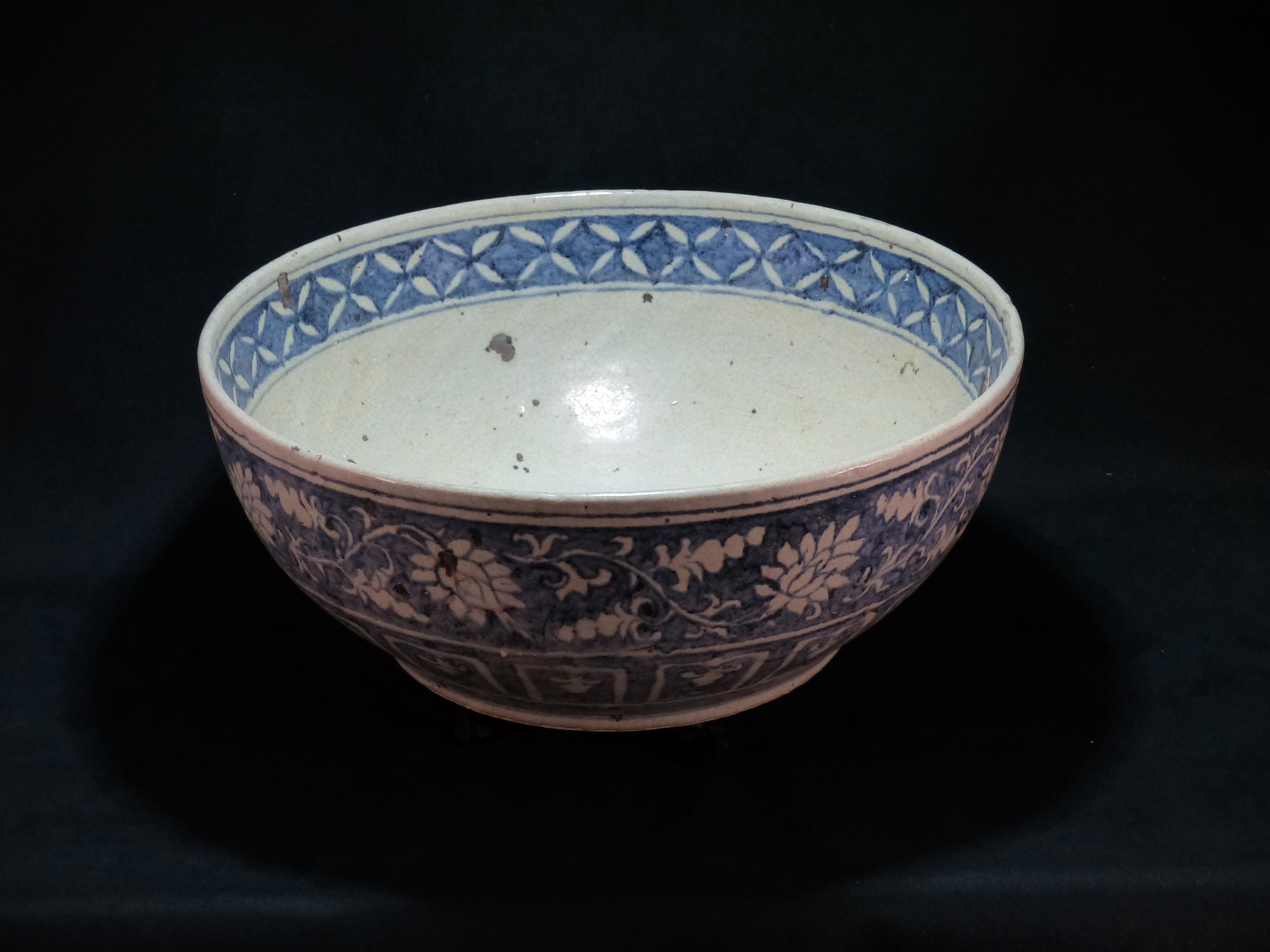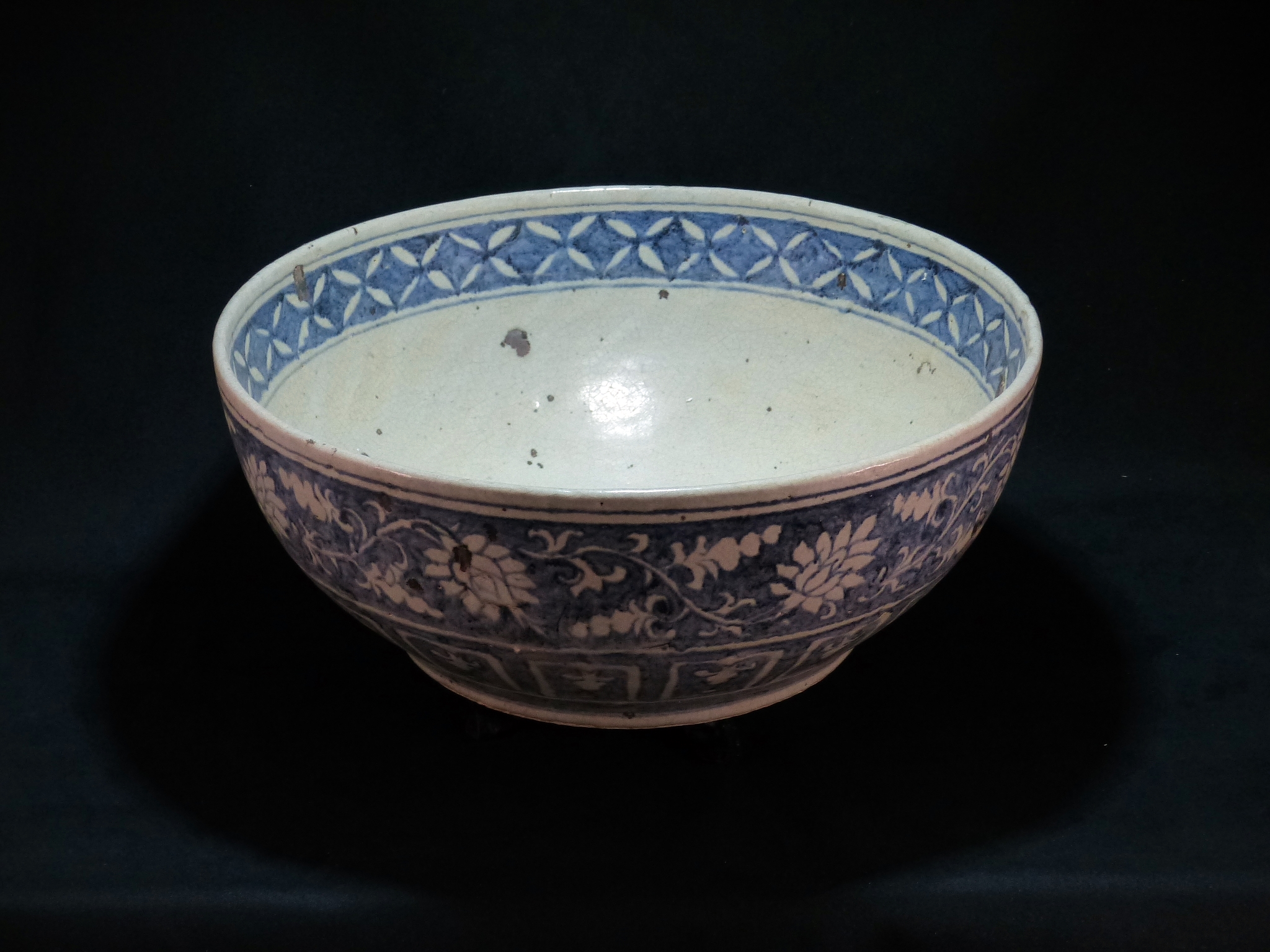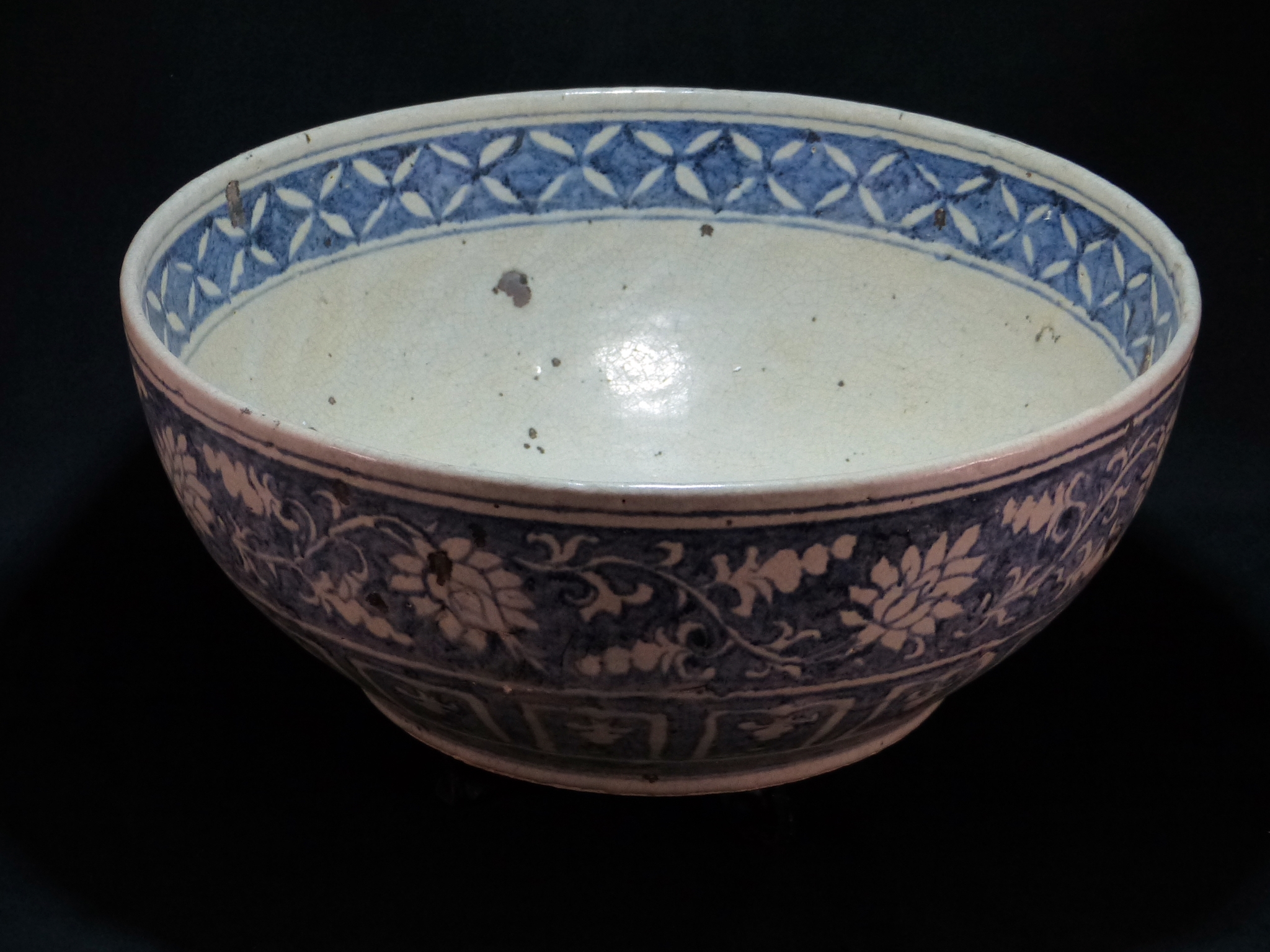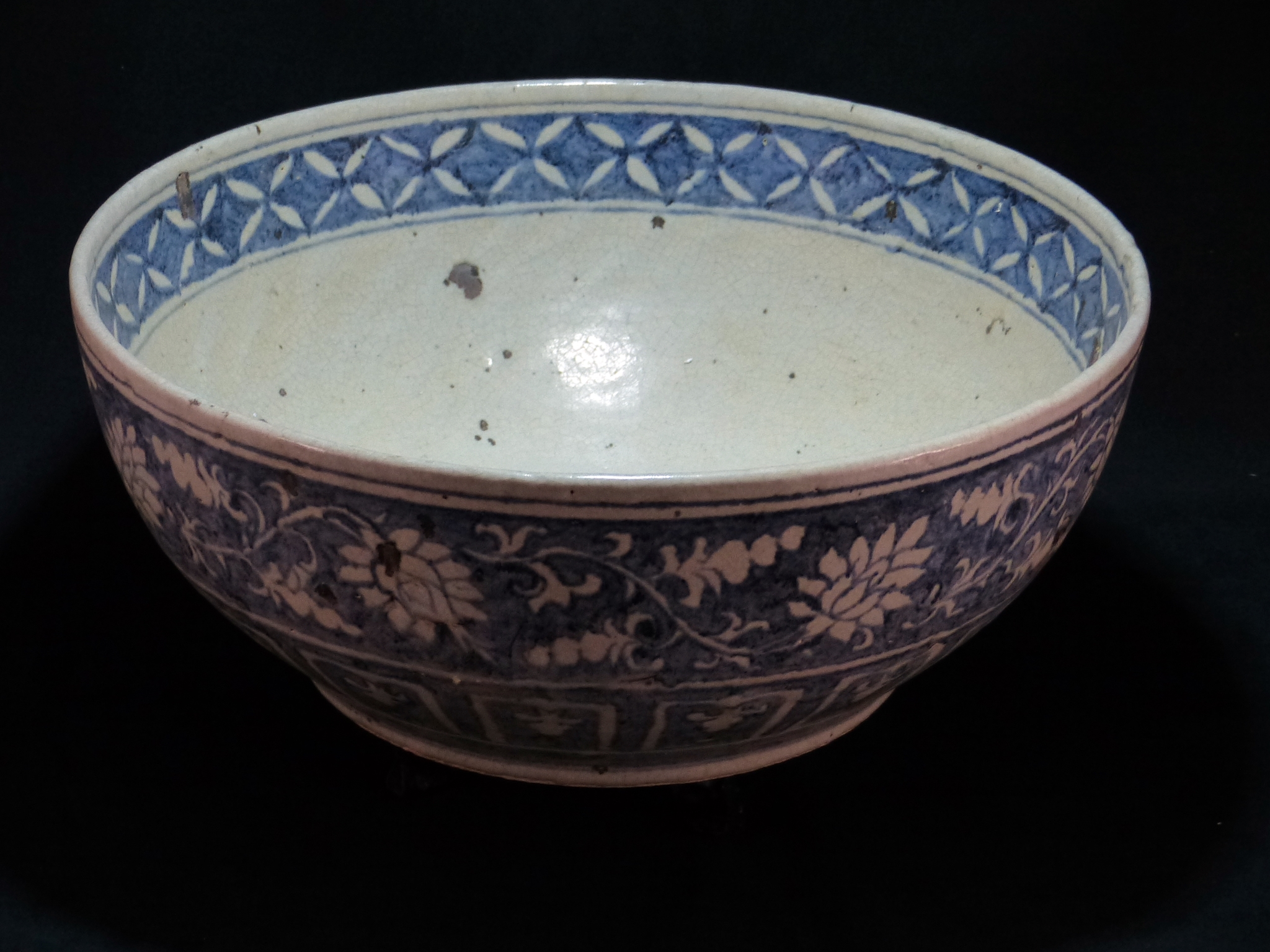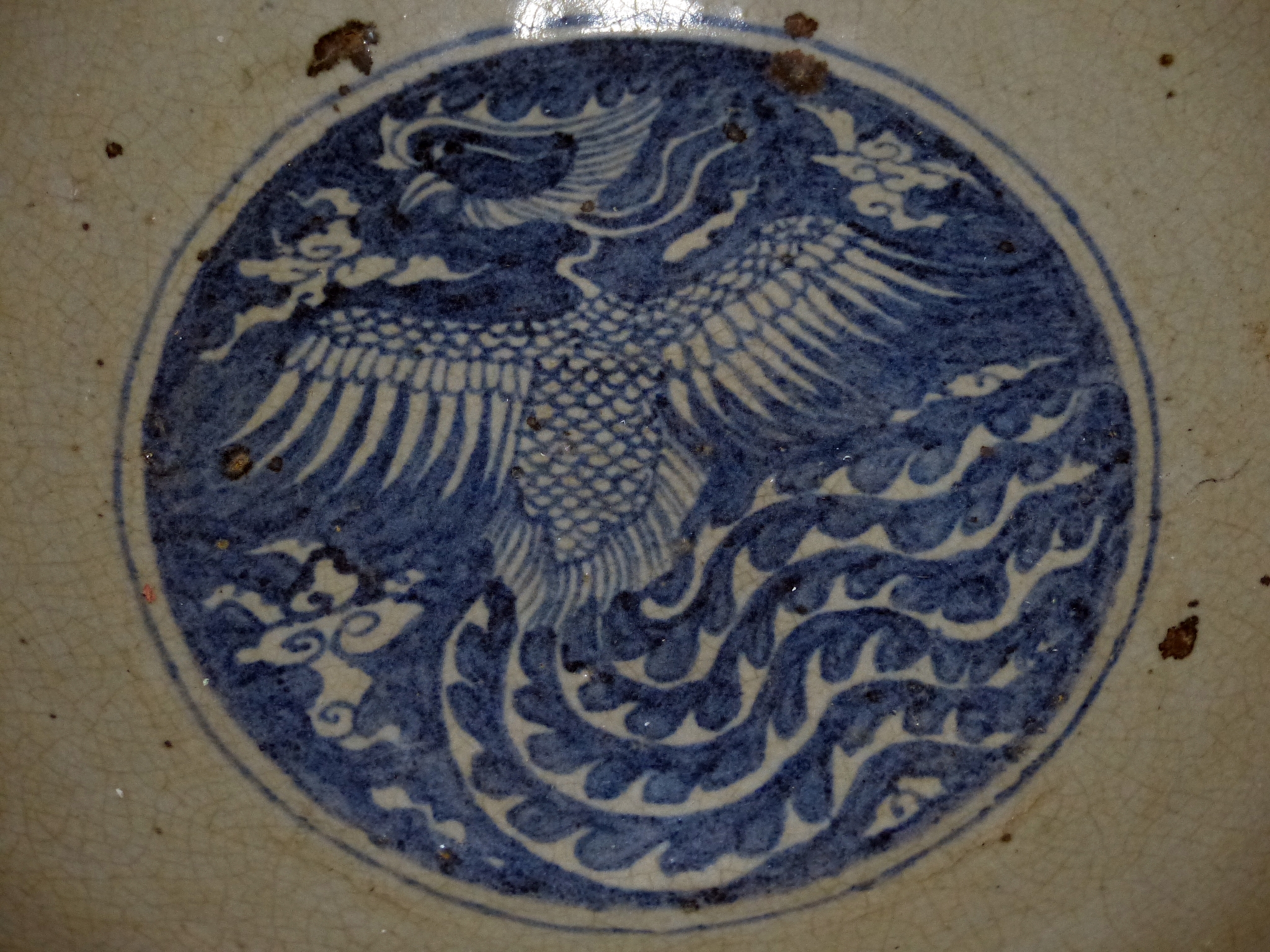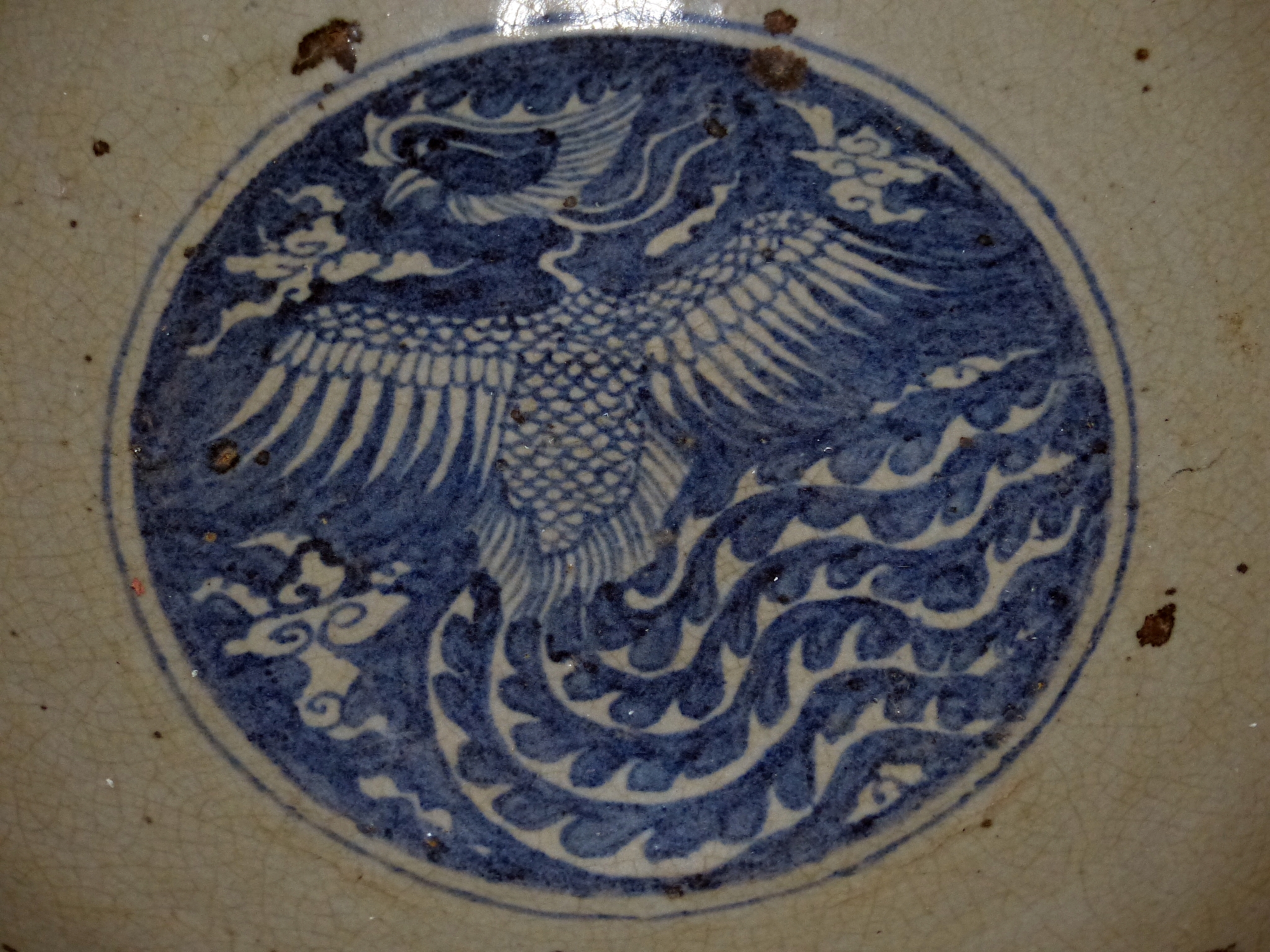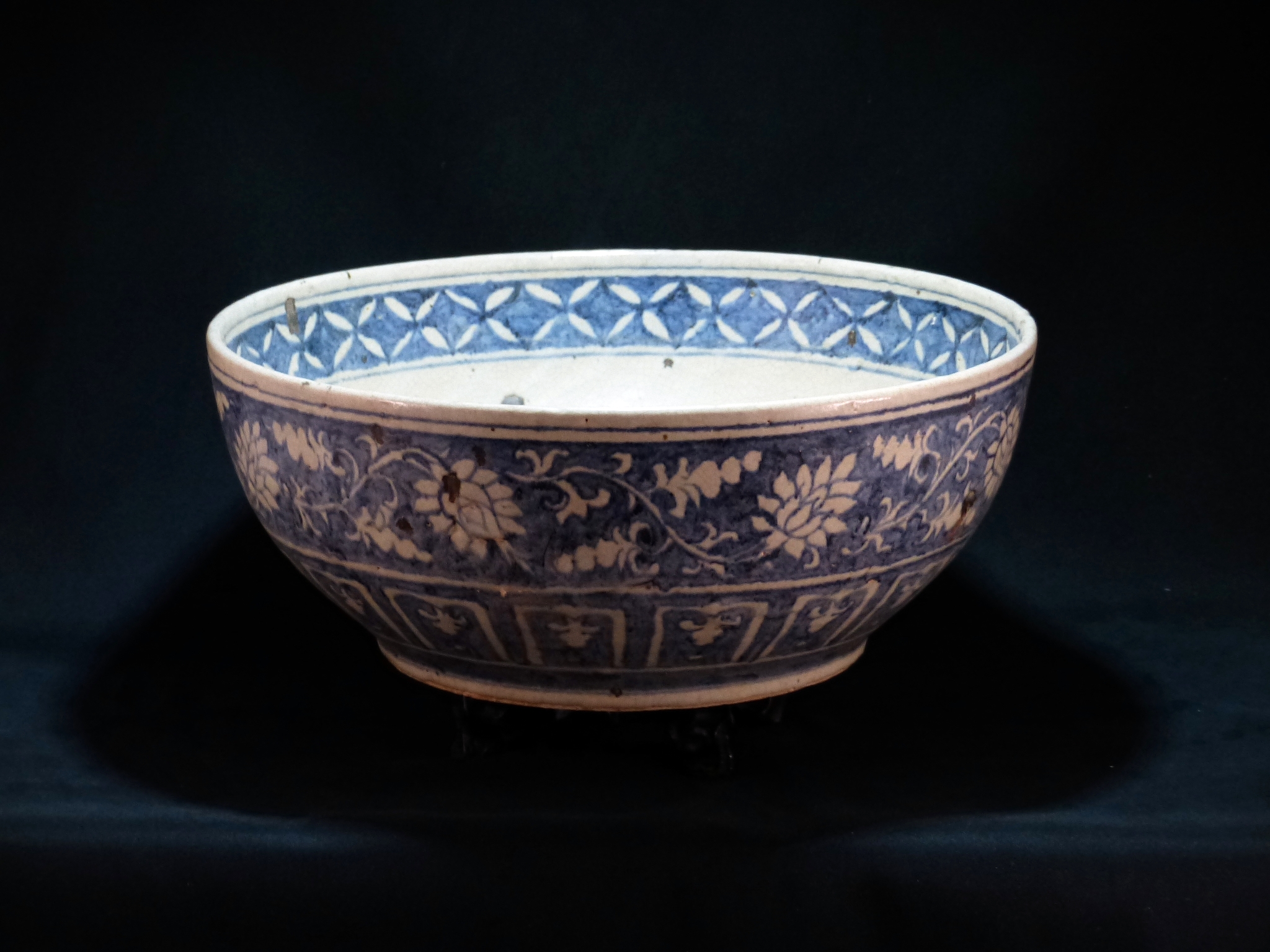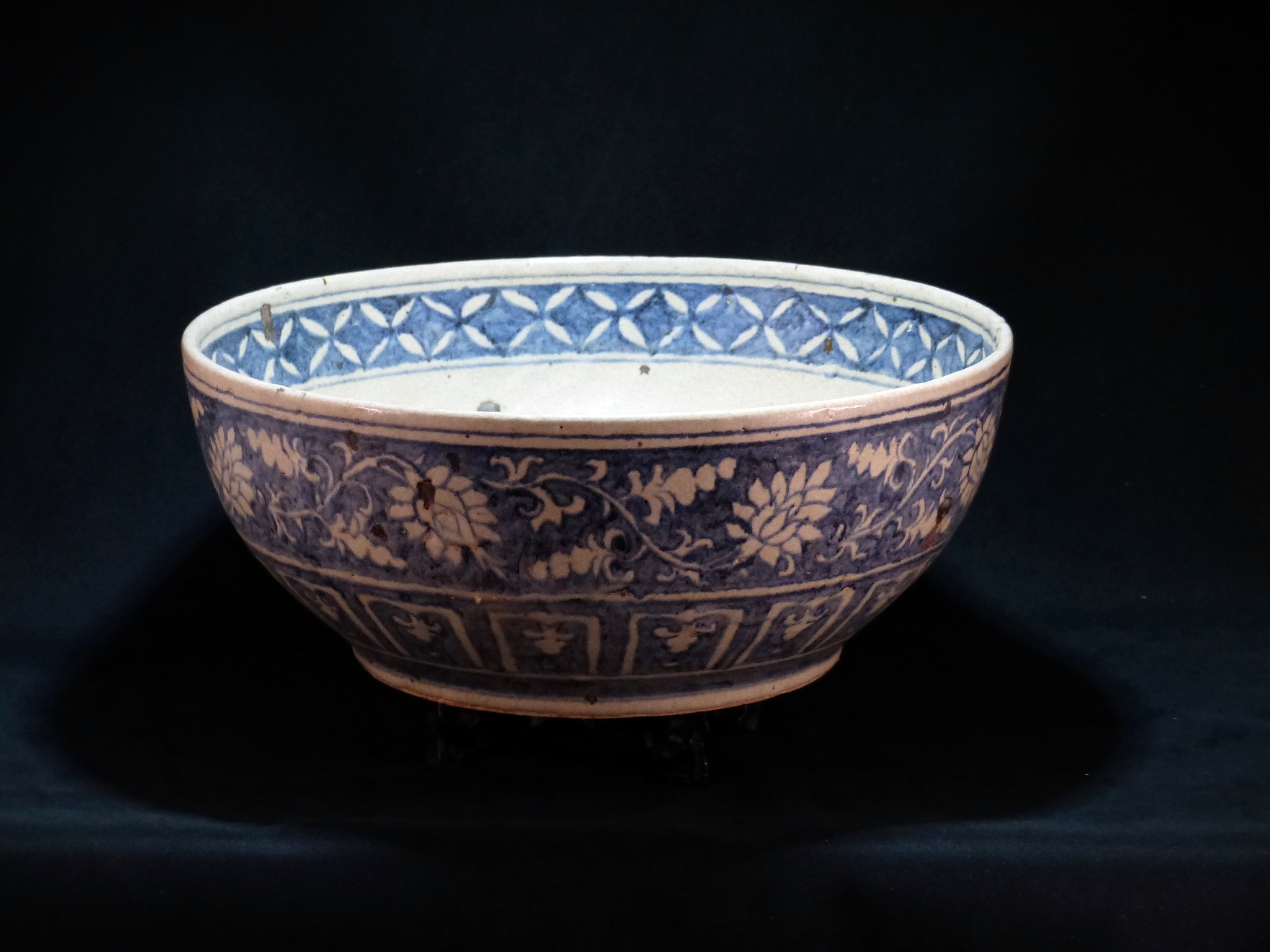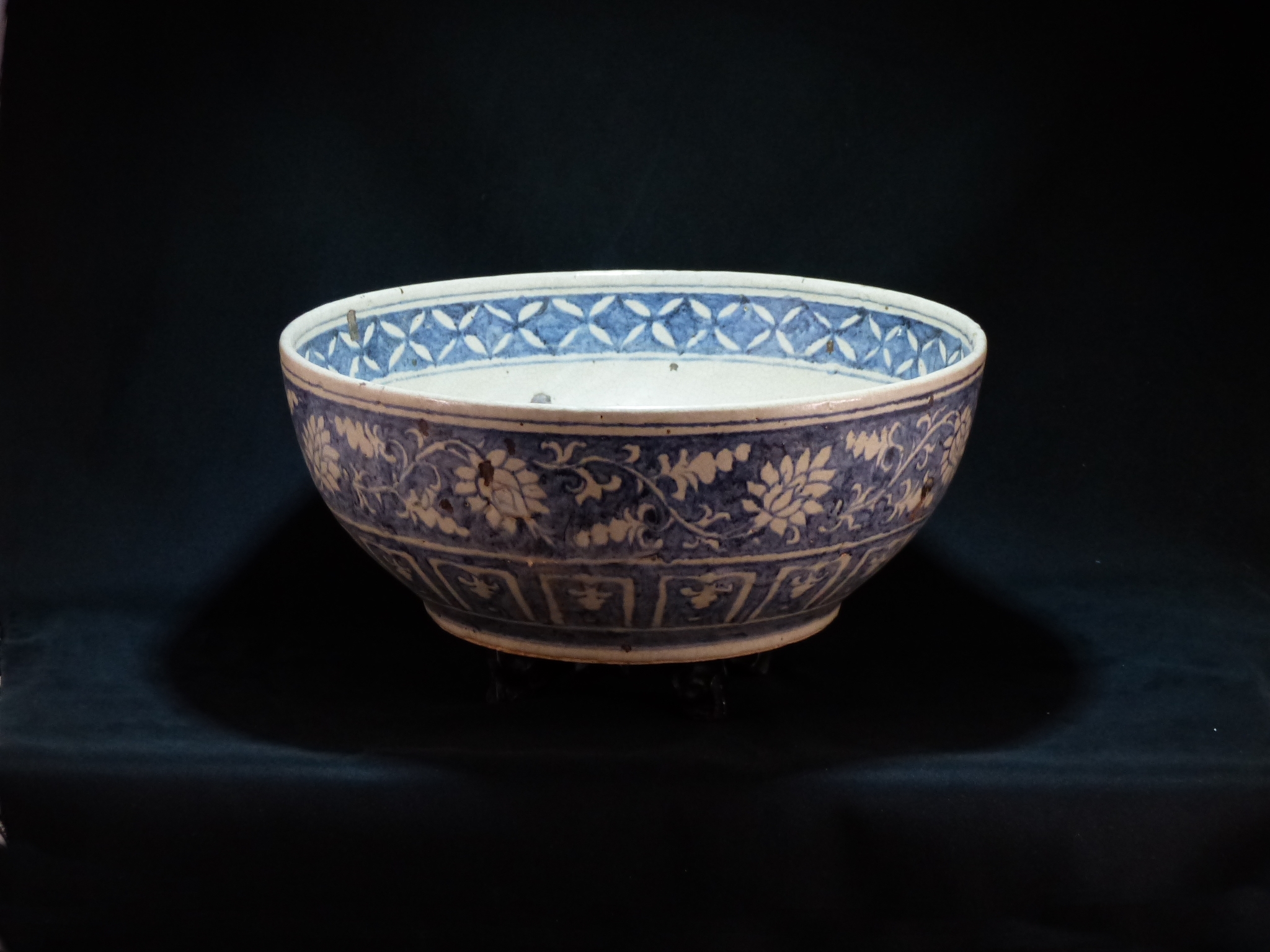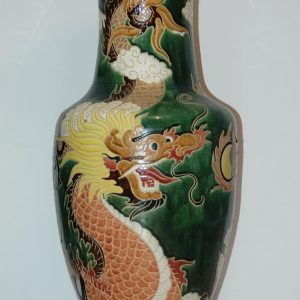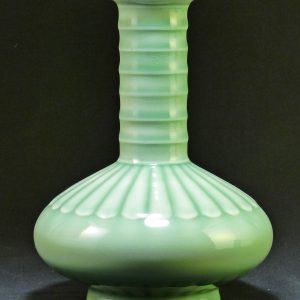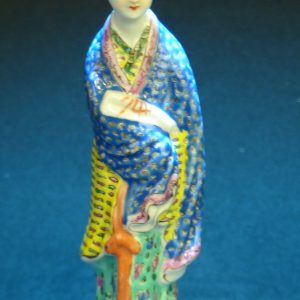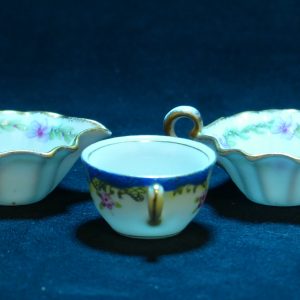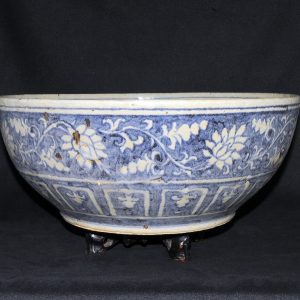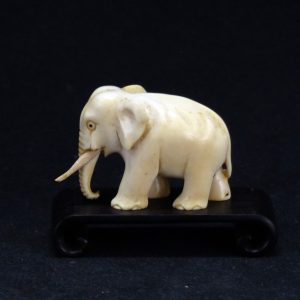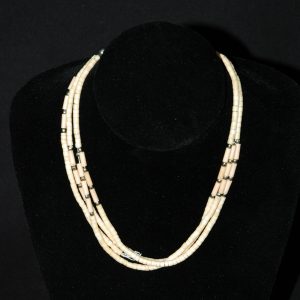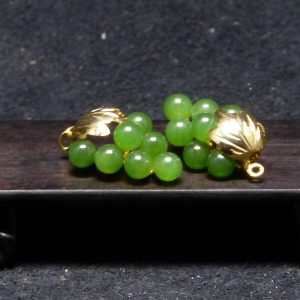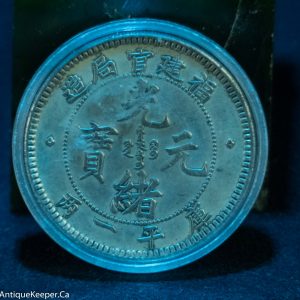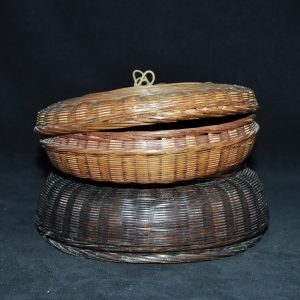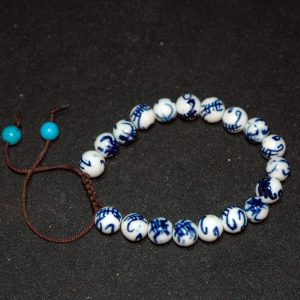Description
元末/明早 青花拔白 碗底中心繪祥云团鳳纹 上周繪几何形钱纹(内)腹部繪缠枝牡丹花卉纹 足底繪下仰莲瓣纹 (外)墩式大碗
仰莲内饰云头,云尖头向下,云尾外卷,云头下部饰宝珠纹
穿花凤、穿云凤、祥云、几何形图案、墩碗、 兰釉青花、反青花、青花拔白、青花瓷、進口鈷青料、缠枝牡丹纹、穿花凤
“兰釉青花”其工艺是把花纹勾好后,将青料涂在花纹之外的空地上,露出白色的纹饰,再罩透明釉,在高温中烧成。形成兰地白花的效果。
参考:元青花纹饰 – 周边几何形图案/铜钱纹图案 凤纹图案
几何形图案:主要是菱形和双重菱形图案,这和唐代巩县窑绞胎陶枕和三彩陶罐上的图案非常近似。唐代青花纹饰采用单线描绘布局疏密相间写意、写实兼具。

参考:苏富比
Important Chinese Art /
06 四月 2016 • 香港
拍品 3647
明洪武 釉裏紅纏枝花卉紋墩盌
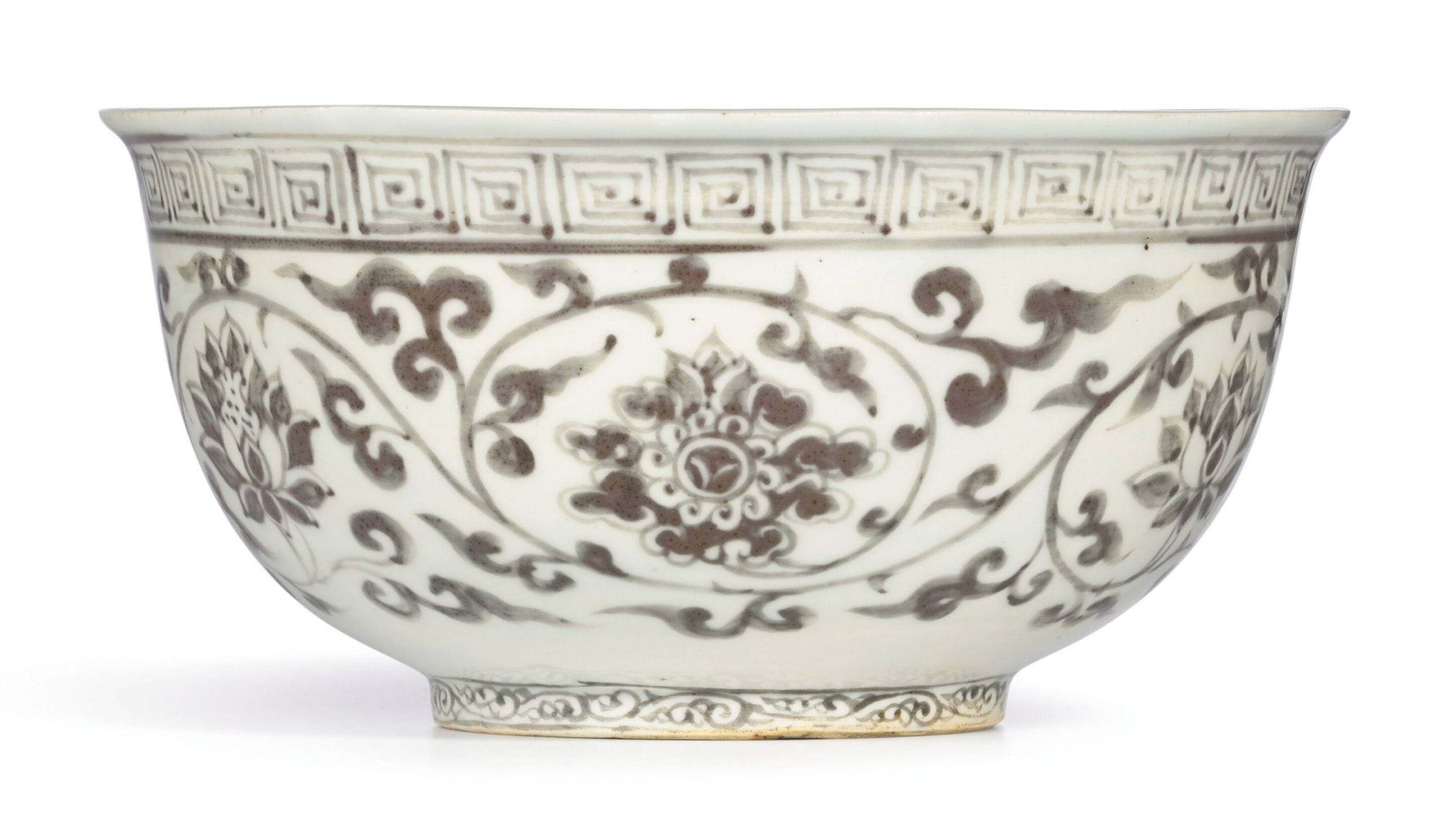
估價 3,000,000 – 4,000,000 HKD
已售出 6,080,000 HKD
描述
porcelain
20 公分,7 7/8 英寸
finely and solidly potted with deep rounded sides rising from a short straight foot to a flared mouth, painted on the interior with a central medallion enclosing a leafy peony spray and an attendant bud within a double-line border, the cavetto boldly painted with further peony, pomegranate, chrysanthemum and camellia flowers below key-fret border at the rim, the exterior painted with a leafy scroll of alternating lotus blooms between a key-fret border above and ‘classic’ scrolls around the foot, the red varying in shades from a pale maroon tone to a pale reddish-grey, the base glazed
來源
繭山龍泉堂
出版
《龍泉集芳:創業七十周年記念》,卷1,繭山龍泉堂,東京,1976年,編號730
拍品資料及來源
洪武釉裏紅,相較明初各類瓷器,罕存於世。繼元朝粗放雄壯、蒼勁有力之製瓷風格,明初,瓷器器形及紋飾則顯恭造之式,有制可循。本盌乃洪武釉裏紅典型,呈墩式,內繪四季折枝花卉,外繪纏枝花卉,內外口沿飾回紋,規整精妙。器形規整、樣式精緻,皆證其為洪武朝佳例。因明初限制對外貿易,進口鈷青料愈發難得,遂國產銅紅料作為其替代品得以更廣應用,此亦為明初瓷器一特徵。依劉新園言,洪武一朝,依先例,取其精華,加以更形,紅釉或釉裏紅瓷器於本朝多有燒製,蔚成體系,見《景德鎮出土明初官窰瓷器》,鴻禧美術館,台北,1996年,頁52。然銅料嬌火,正色之品存世甚罕。清宮藏釉裏紅例,飾紋仍多見不平整及色斑,又或因窰溫不當,發色泛黑,如清宮舊藏大盤,錄於王光堯及江建新編,《明代洪武永樂御窰瓷器:景德鎮御窰遺址出土與故宮博物院藏傳世瓷器對比》,故宮博物院,北京,2015年,編號17。如此種種,皆赫然證明銅料於窰燒時呈色之艱難。
此例所繪紋飾甚是少見,尤為悅目,其內壁分別繪折枝菊花、牡丹、茶花及石榴花,他例則多繪單種纏枝花卉,如菊花或牡丹。與此盌相類之罕例,可見一器,售於香港蘇富比1981年11月24日,編號132。另一相似盌例,器心繪折枝菊花,屬 Trevelyan 勳爵雅藏,出版於 John Addis,〈A Group of Underglaze Red〉,《Transactions of the Oriental Ceramic Society》,卷31,1957-59年,圖版1a。
相類之洪武盌例,可參考北京故宮博物院藏品,盌內壁繪纏枝菊花紋,內外口沿及圈足均繪回紋,或景德鎮御窰廠遺址出土青花盌例,兩器均載於王光堯及江建新編,前述出處,編號7-8。蘇富比曾拍出相類釉裏紅盌三例,如倫敦蘇富比1973年3月13日,編號232,此例後又兩度售於香港蘇富比,分別為1977年11月29日,編號27,以及1991年4月30日,編號9A;第二例為 J.F. Bloxham 及 Stephen Winkworth 舊藏,兩度售於倫敦蘇富比,分別為1933年4月26日,編號363,以及1974年12月2/3日,編號264,且於1974年之前,借展於維多利亞與艾伯特博物館;第三例售於香港蘇富比1999年11月1日,編號308,並錄於三上次男編,《世界陶磁全集》,卷13:遼、金、元,東京,1981年,彩圖82。還有一例,外口沿以卷草紋替代回紋,為坂本五郎舊藏,售於香港蘇富比2014年10月8日,編號3505。
参考:故宫博物院【青花缠枝花卉纹碗】

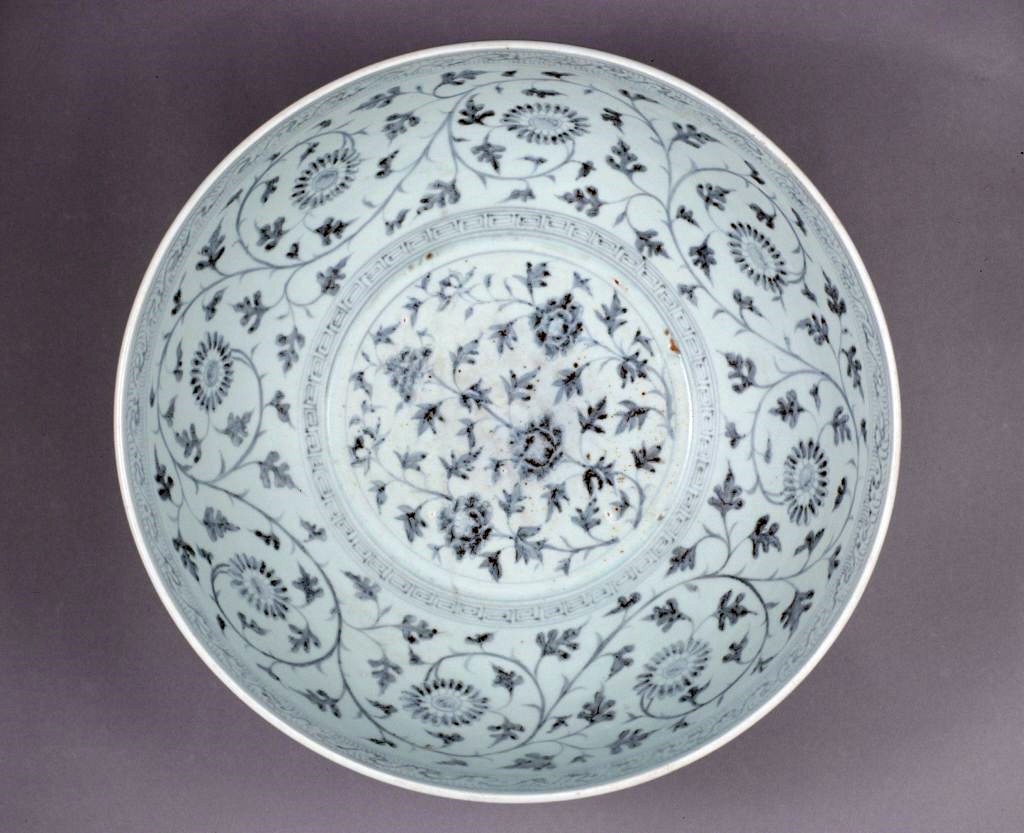

青花缠枝花卉纹碗,明洪武,高16.5厘米,口径40.5厘米,足径23厘米。
碗直口,深弧壁,圈足。内外青花装饰,内底一周回纹内绘折枝牡丹纹,内壁绘缠枝菊纹,口沿内外分别描绘浪花纹和缠枝灵芝纹,外壁绘缠枝牡丹纹,近足处绘变形莲瓣纹,莲瓣内绘朵花纹,圈足外墙绘回纹。圈足内施白釉。无款识。
明初洪武时的青花瓷器器型大都延续元代风貌,此器就与元代枢府釉碗造型接近,但又有向后来以秀美取胜的永乐碗形演变的趋势。此碗造型硕大规整,线条比元代碗形更显圆润,所绘纹饰笔法娴熟,线条流畅。
撰稿人:黄卫文
关键词: 青花 缠枝 花卉 回纹 折枝 灵芝 莲瓣纹 花瓷
参考:苏富比 433
中國藝術品 包括趙從衍家族收藏藝術珍品
亞洲私人舊藏
明十六世紀 青花穿花鳳紋玉壺春瓶

20,000 — 30,000港幣
拍品已售 52,500 港幣 成交價 (含買家佣金)
拍品詳情
明十六世紀 青花穿花鳳紋玉壺春瓶
22.8 公分,9 英寸
中國藝術品 包括趙從衍家族收藏藝術珍品
2017年11月30日 – 2017年12月1日 | 下午 2:00 HKT
香港
参考:苏富比
Important Chinese Art
Live Auction: 17 March 2021 • 10:00 EDT • New York
明永樂 青花花卉紋蓮子盌
An exceptional and rare blue and white ‘floral’ bowl,
Ming dynasty, Yongle period











Estimate:300,000 – 500,000 USD
Description
An exceptional and rare blue and white ‘floral’ bowl
Ming dynasty, Yongle period
明永樂 青花花卉紋蓮子盌
delicately potted in the shape of a lotus bud (lianzi) or chicken heart (jixin), with deep rounded sides and a pointed base resting on a short, narrow foot, finely painted in rich tones of cobalt blue accented with characteristic ‘heaping and piling’, the interior decorated with a central medallion enclosing a formalized quatrefoil motif encircled by a narrow band of alternating stylized florets formed of dots and leaves, and further wreathed by elaborate interlocking strapwork forming heart-shaped petals enclosing trefoils, the cavetto with eight dianthus blossoms borne on undulating leafy foliate scrolls, all below a row of pendent trefoils and a band of zigzag lines and clusters of circles around the rim, the exterior painted with four blossoms of lotus, peony, chrysanthemum, and pomegranate flower, alternating with four emblems of zabao (miscellaneous treasures) including the ingot, double horns, coral branch, and yinyang castanets, between interlinked pendent trefoils and upright slender petals surmounted by trefoils, all bordered by a band of lotus scrolls around the rim and classic scrolls encircling the foot
Diameter 6 ¼ in., 16 cm
Condition Report
In overall very good condition, except for a minute shallow 0.3 cm chip to the outer rim and minor characteristic warping to rim. Some expected light wear and minor firing imperfections, including a few faint glaze lines encircling the base, all consistent with age and type.
Provenance
American Private Collection, acquired in Connecticut.
來源
美國私人收藏,購於康州
Catalogue note
Imperial Porcelain with an Exotic Touch
Regina Krahl
The Yongle court (1403 – 1424) brought a very distinctive new style to the porcelain kilns of Jingdezhen in Jiangxi, a style immediately recognizable, never surpassed, and defining the craft still in the eighteenth century. In every respect, this delicate bowl is a quintessential Yongle product, made for the court, showing the striking combination of superb material and painting with a slightly exotic design that characterizes imperial porcelain of this period.
Yongle was the period when the Ming (1368-1644) came into its own. The Emperor was ambitious, reaching out to foreign countries, determined to use the country’s assets not only for his own delectation but also to showcase China’s superiority abroad. He had court officials take over not only the production of porcelains at Jingdezhen and of celadons at Longquan, but also of Buddhist bronze sculptures, carved lacquerware, probably textile weaving, book printing and other crafts. In all these media, fine products had been created since the Yuan dynasty (1279 – 1368) or longer; patronage and pilotage by the Yongle court lifted them to completely new levels.
The exact date of the official establishment of an Imperial Porcelain Factory in Jingdezhen is a matter of debate, but in the Hongwu period (1368 – 1398) already, the court had commissioned porcelains and sent officials to Jingdezhen to supervise the firing. For the Yongle reign, there are records of a successfully completed imperial order of 300,000 pieces. While from the Xuande reign (1426 – 1435) onwards, eunuchs were often sent to the Jingdezhen kilns from far-away Beijing to control an industry they did not understand – positions prone to abuse – the earlier supervisors were officials directed from one local post to another, and some seem to have been well suited to the task; in the Yongle period, one of them even got a shrine erected in his memory (see Peter Y.K. Lam, Dawentang cang ci/Chinese Ceramics from the Dawentang Collection, Hong Kong, 2019, pp. 16-31, Chinese, and 35-59, English).
The excellence of Yongle porcelain was unquestionably boosted through this direct imperial involvement. The court patronized the production through large orders, employed specialists to do the designs, and selected supervisors to oversee the whole organization. The manufacture of imperial wares was now approached with a new professionalism. After the often disappointing appearance of blue-and-white porcelain in the Hongwu period, the potters did active research rather than relying on trial and error to achieve a satisfactory outcome. The waste heaps of the Jingdezhen kilns have brought to light a sample dish painted with flower sprays in different cobalt solutions, identified by different numbers, that indeed yielded very different results; although that dish was discovered in the Xuande stratum, such pointed experiments were undoubtedly undertaken since the Yongle period, as the cobalt recipe used from that period onwards was of reliable quality. Even the many pieces rejected by Yongle quality control, discarded, broken and buried, which have now been recovered from the kiln sites, are overwhelmingly of a beautiful bright blue.
Besides this improvement of the materials, the imperial organization of the designs resulted in much greater variety and refinement of shapes and decorative motifs. The shape of our bowl, called a ‘lotus bowl’ because it is shaped like a lotus bud, would seem to be purely Chinese in origin. It is elegantly tapering to a pointed bottom, that is clearly visible not only in the center inside but also on the underside, where the ring-shaped foot provides a support. This shape, which in China is known as jixin, ‘chicken heart’ shape, is only known from the early Ming and does not seem to have been exported. Smaller bowls of this form are ‘lotus bowls’ also in decoration, being painted with slender lotus petals, which on the present piece have been alienated by being capped with small trefoil motifs, that give them a very different appeal.
These trefoil, or fleur-de-lys motifs, here also used topping lambrequin borders around the center and on either side of the rim, seem to have been inspired by metalwork. Related borders are characteristic of somewhat earlier Khorasan vessels of bronze, brass and other metals; they appear, for example, on the inside of a bowl in the Victoria and Albert Museum, London, and on dishes and trays in various collections, illustrated in Assadullah Souren Melikian-Chirvani, Islamic Metalwork from the Iranian World. 8th – 18th Centuries, London, 1982, pls 26B, 26a (fig. 1) , 27b, 27c, or 36. It is not only the basic form of the design, but particularly one detail in the representation that appears regularly on the Khorasan metal vessels and is repeated inside our bowl: the careful enlacement of loops to pass alternately under and over each other, when crossing.
A border not unlike that seen here on the inside rim can also be found on Khorasan metalwork, e.g. on two brass bucklers illustrated ibid., pls 57 and 57a, described by the author (p. 129), as “lotus-buds, their lateral petals joining together to form pointed arches over pyramids of three pierced beads”. While the petal arches and beads are also seen here, the buds themselves have been lost.
Direct Chinese exchanges with Khorasan happened at least six times during the Yongle reign. The Chinese official Chen Cheng (1365-1457), who acted as imperial envoy for the Yongle Emperor to undertake diplomatic voyages overland – like Zheng He (1371-1433) did by sea – travelled to Central Asia and Western Iran in 1414, 1417 and 1420, each time visiting important Khorasan cities such as Herat, one of the centers of metalwork production. All three voyages were undertaken in direct response to prior embassies received from envoys of various Central Asian and Iranian regions, also including Herat, which had submitted tribute gifts to the court.
We do not know how the design office worked, but a whole new repertory of motifs had to be developed for blue-and-white and it is likely that designers charged with inventing large numbers of patterns sought inspiration wherever they could find it, including from foreign goods. A prohibition to depict living beings in Muslim societies, however loosely enforced, made Middle Eastern artists extremely inventive in coming up with formal, non-representational motifs. That no exact prototypes can be identified for the exotic motifs on our bowl and other Yongle porcelains is most likely due to the fact that exact copying was never the intention.
This bowl shows a distinct Middle Eastern touch even in its floral designs, which seem formalized rather than fitting in with the rules of depiction Chinese artists usually observed. In the composite flower scrolls so characteristic of the Yongle period, the species generally are clearly identifiable since every bloom, or pair of blooms, is distinctive and shown with matching buds, fruits and leaves. The small blossoms of the flower scroll inside the present bowl are here depicted as distinctly seven-petalled, but on companion bowls, like one in the National Palace Museum, Taipei, they can have eight petals. They are not shown in various stages, but only fully opened and in frontal view, without buds or fruits, and their foliage represents a combination of undulating grass-like stems and occasional trefoil leaves. Just like the small dotted flower-heads around the center, this seem like an idealistic representation of flowers, as it is common in the Middle East. Only the four flowering sprigs on the outside, which are all different, are clearly intended to represent seasonal flowers, but even they have been stylized. The delicacy of the frilly brushwork may have been dictated by the tendency of the blue to ‘heap and pile’.
In the Yongle reign, the imperial court controlled not only the design and production of the wares from the imperial kilns, but also their distribution. Yongle porcelain was not available through the usual trading channels, which had brought Yuan porcelains to the lands of the Near and Middle East and to East Africa. They were made and distributed under strict court supervision, with seconds being destroyed and buried so that they could not be copied, which clearly increased value and demand. While pieces of larger size were much exported, fine porcelains in small sizes such as this bowl were mostly sent to the court and can be found in the palace collections of Beijing and Taipei, and are rarely found abroad.
Only very few companion bowls appear to be recorded: two in the National Palace Museum, Taipei, one illustrated in Ming ci mingpin tulu. Hongwu yao Yongle yao Xuande Yao [Illustrated catalogue of important pieces of Ming porcelain, Hongwu ware, Yongle ware, Xuande ware], Tokyo, 1977, pl. 21; the other included in the exhibition Mingdai chunian ciqi tezhan mulu/Catalogue of a Special Exhibition of Early Ming Period Porcelain, National Palace Museum, Taipei, 1982, no. 24 (fig. 2); one from the Ardabil Shrine, now in the National Museum of Iran, Tehran, illustrated in Takatoshi Misugi, Chinese Porcelain Collections in the Near East. Topkapi and Ardebil, Hong Kong, 1981, vol. 3, no. A.53; one, from the collections of George Eumorfopoulos and Mrs. Walter Sedgwick, sold in our London rooms, 29th May 1940, lot 220, and now in the British Museum, in Jessica Harrison-Hall, Ming Ceramics in the British Museum, London, 2001, no. 3: 28 (fig. 3); one from the collection of A.D. Brankston and Mrs W. Roberts, now in the Victoria & Albert Museum, London, illustrated in John Ayers, Far Eastern Ceramics in the Victoria and Albert Museum, London, 1980, pl. 46; and another sold at Christie’s Hong Kong, 29th May 2007, lot 1452.
The National Palace Museum also owns a version of Xuande mark and period, included in the exhibition Mingdai Xuande guanyao jinghua tezhan tulu/Catalogue of the Special Exhibition of Selected Hsüan-te Imperial Porcelains of the Ming Dynasty, National Palace Museum, Taipei, 1998, no. 158; and Brankston illustrated his Yongle bowl together with a Xuande version also in his and later the Riesco Collection, in A. D. Brankston, Early Ming Wares of Chingtechen, Beijing, 1938, pls 5 and 6. The design of both versions is remarkably similar, but the Yongle version shows the stronger painting.
In the Yongle period, four related designs are known from smaller bowls: two of shallow mantouxin shape with quatrefoil and lambrequin motifs and only a narrow floral border on the inside, and two of lotus-bud shape, with formal designs only and no floral motifs at all; examples of all four designs are in the Palace Museum, Beijing, illustrated in Mingdai Hongwu Yongle yuyao ciqi/Imperial Porcelains from the Reigns of the Hongwu and Yongle in the Ming Dynasty, Beijing, 2015, pls 64-67.
A lambrequin design topped by trefoil motifs, “ultimately a stylization of lotus-buds” according to Melikian-Chirvani (op. cit., p. 96), appears, together with precious emblems, also on the damascene decoration of an early Ming iron helmet in the Metropolitan Museum of Art, New York, see Craig Clunas and Jessica Harrison-Hall, eds, Ming. Fifty Years that Changed China, The British Museum, London, 2014, p. 151.

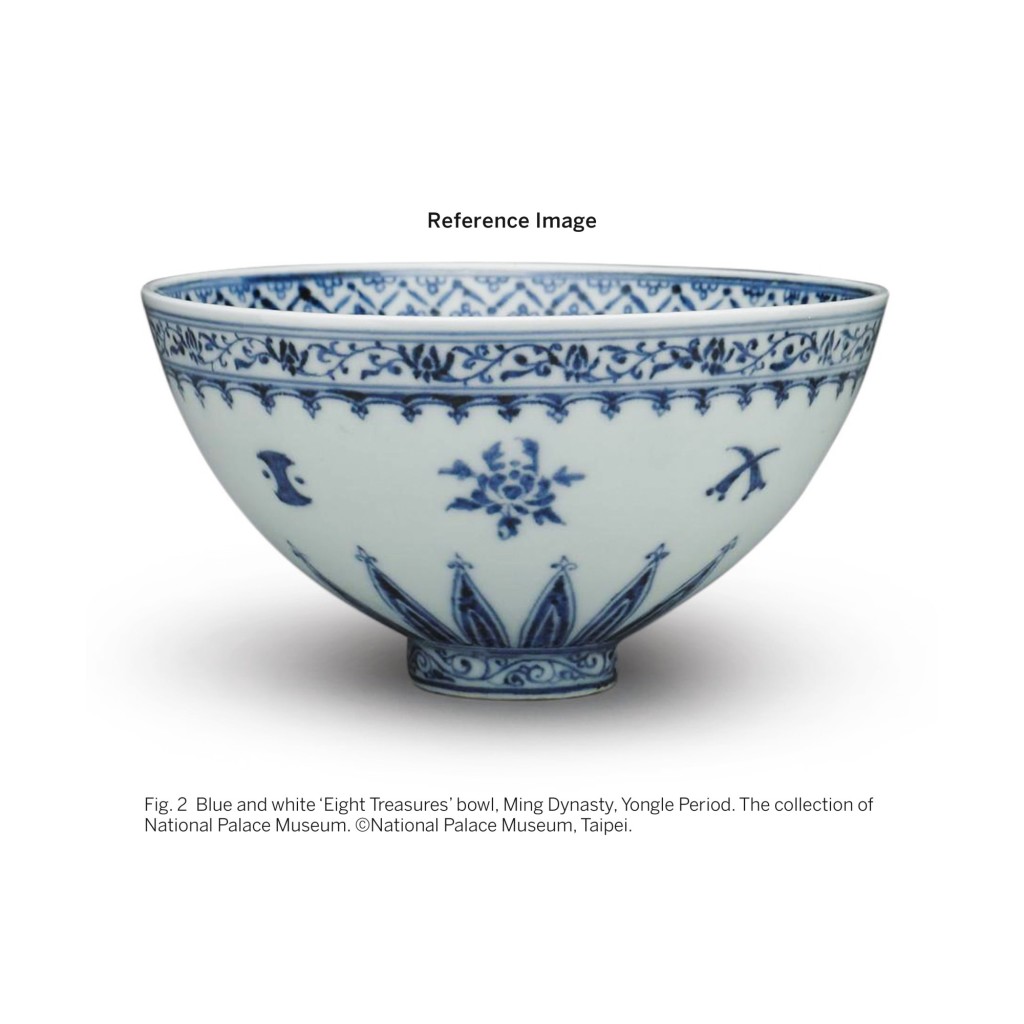
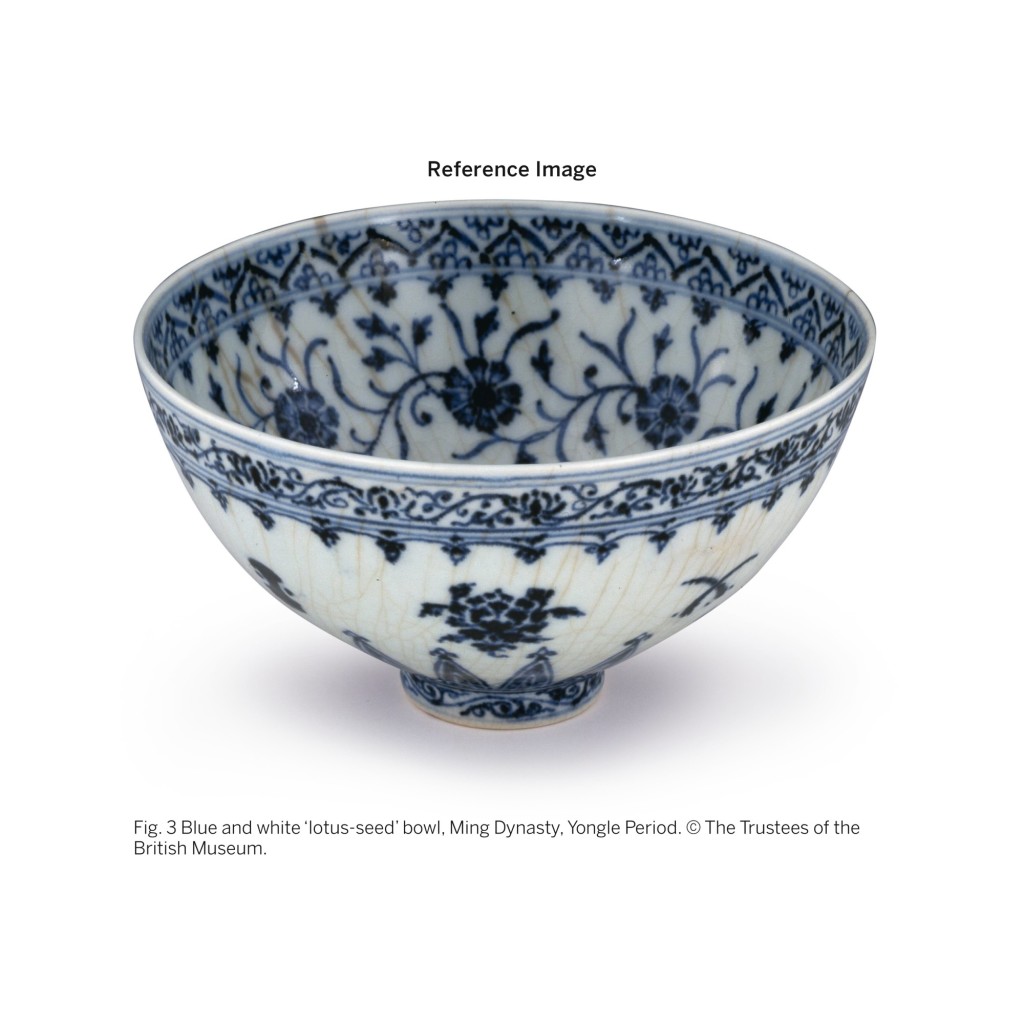
御瓷中的異域風情
康蕊君
大明永樂一朝,江西景德鎮御窰開創新穎瓷風,所成珍瓷特征鮮明獨特,成就卓絕,直至十八世紀仍屬製瓷典範。本盌無論從器形、紋飾等各方面,皆屬永樂之經典、宮廷御製之上乘,一抹異域之風,極具特色,尤為稀珍。
永樂一朝,大明之盛世。永樂帝雄心壯志,遠交外邦,振興藝事。永樂朝不僅朝廷任命專員督燒景德鎮以及龍泉官瓷,同時還包括佛教造像及漆器等製作,甚至可能連紡織、印刷及其它工藝成作亦均接管。各門藝術自元代起已珍品層出,永樂宮廷接管後則更臻新高。
景德鎮御器廠何時設立,確切日期現時尚未有定論,但洪武年間,朝廷曾委派官員前往景德鎮監督瓷器燒製。文獻記載永樂年間宮廷命景德鎮製瓷,一批共三十萬件成品。自宣德朝起,朝廷委派宦官自京城遠赴景德鎮監造,有些宦官對製瓷無甚了解,亦時有舞弊情況出現,但其中也不乏表現傑出者。永樂年間,更曾有設立廟龕紀念督陶官之事蹟(林業強,《達文堂藏瓷》,香港,2019年,頁16-31(中文),頁35-59(英文)。
永樂年間瓷器品質上乘,無疑得益於朝廷的直接參與。朝廷命藝匠大批製瓷,聘畫師專職繪畫紋飾,並委派專員監督,御瓷製作更為專業精良。洪武年間,青花瓷成品差強人意,即便是製得佳品,但其中奧秘卻不求甚解。至永樂後瓷匠改變作法,精研製瓷技術以求更佳成果。景德鎮窰址曾發現一瓷盤,上面花卉紋飾以不同鈷料繪成,各料配以編號,青花成色各具特色;雖然該盤出土自宣德地層,然而以此時期及以後鈷料燒製之穩定程度即可推測得知,此類實驗自永樂年起便已開始。今以出土資料所見,許多永樂年間被視為品質不及標準而廢棄掩埋者,當中竟也不乏有鈷藍發色鮮亮明豔之品。
除材質精進外,朝廷也同時監管瓷樣設計,故此時期瓷品器形及紋飾種類繁多,異常豐富。細觀本品,器如蓮子,故名「蓮子盌」。此器形源起中原,盌帶尖底,似雞心之狀,故亦稱「雞心盌」。此類盌式僅見於明初,且應未作外銷。器形相近而尺寸較小之例亦稱「蓮子盌」,然紋飾相異,其器身常繪以細長蓮瓣,而本品紋飾則以蓮瓣頂端覆繪三葉紋,別具一格。
此類三葉紋飾似受金屬器影響,其紋飾呈現出早期呼羅珊銅器及其他金屬器風格;可比較倫敦維多利亞與阿爾伯特博物館收藏一銅錯銀盌例以及其它收藏之盤例,圖載於Assadullah Souren Melikian-Chirvani,《Islamic Metalwork from the Iranian World. 8th – 18th Centuries》,倫敦,1982年,圖版26B、26a(圖一)、 27b、27c或36。以上數例與本品相近之處不僅在於其基本設計形式,而更在於一個常見於呼羅珊金屬器上的細節紋飾,此一紋飾亦可見於本盌盌心:即為一類相互交疊穿插的類貫套式紋樣。
如本盌內口沿處所繪的近類紋飾亦可見於呼羅珊金屬器,如見兩件小銅盾例,載於前述出處,圖版57及 57a,作者形容(頁129)為「蓮苞,側瓣連接組成尖頂拱形,下為三珠成金字塔形」。再觀本品紋飾,亦可見花瓣連成拱形及金字塔形的成組圓珠,唯無花苞而已。
永樂年間,大明朝廷與呼羅珊的互通往來至少有六次。 明代陳誠奉永樂帝命,於1414、1417及1420年沿陸路出使中亞及伊朗西部,效鄭和下西洋通使外邦。陳誠三次出使途中,曾到訪過各大重要呼羅珊城市,包括赫拉特等金屬器製作重地。而其三次出使緣由,皆為回應中亞及伊朗外使訪華之故。多個訪華使團中亦包括赫拉特,其並曾向明廷獻贈供禮。
目前尚不清楚當時明廷主要負責紋樣設計部門具體如何運作,但相信其中藝匠定必從各處尋覓靈感,亦應包括外邦供物,以求創新大量新穎青花紋飾。時穆斯林文化禁止描繪世上生物,雖然執行不嚴,但亦促使中東藝匠極為擅長設計制式化的抽象紋飾。本盌及其他永樂瓷器紋飾雖具異風,然不見其直接原型,相信是因為藝匠創作時並無完全仿製之意。
本盌帶有明顯中東風格,其抽象花卉紋飾有別於傳統中國繪畫之道。花卉組合紋飾乃永樂時期特征,每種花卉多可辨認,並與相配花苞、果實及枝葉同繪,綻放花朵或成一對,或僅畫一朵。本盌內壁所繪花卉每朵七瓣(同類盌例亦見繪八瓣者,如台北國立故宮博物院收藏一例),且描繪花朵正面盛開,既無花苞,亦無果實,葉紋則以纏枝為主,偶見三瓣葉。此類花飾,包括盌心的數叢點花紋飾,屬於中東對於花卉抽象制式化描繪的常見裝飾風格。然而本盌外壁所繪四束不同的折枝花卉,則似乎更接近寫實,但仍頗為抽象。其繪畫筆觸雖極為細膩,但因其鈷料典型的結晶斑效果,則尤顯濃烈。
永樂年間,宮廷不僅管控御窰燒製,亦控制其分配。元代瓷器商路遠傳近東、中東及東非,但永樂瓷非經普通貿易通道可得。永樂瓷器由宮廷嚴密管控,次品毀而埋之,以防仿製,如此作法之下瓷器自然更為珍稀,外界需求更殷。永樂瓷器中尺寸較大者多外銷海外,而精緻小巧如本品者則大多上奉宮廷,兩岸故宮皆有收藏,流傳海外之器則少之又少。
目前存世同類盌僅有數例,兩例藏於台北國立故宮博物院,其一載於《明瓷名品圖錄•洪武窰 永樂窰 宣德窰》,東京,1977年,圖版21;其二曾展於《明代初年瓷器特展》,國立故宮博物院,台北,1982年,編號24(圖二);另一例藏於阿德比爾寺,現存德黑蘭伊朗國家博物館,圖載於三杉隆敏,《中近東の中国磁器》,香港,1981年,卷3,編號A.53;再比一例,出自 George Eumorfopoulos 及Walter Sedgwick夫人收藏,售於倫敦蘇富比1940年5月29日,編號220,現存於倫敦大英博物館,參考霍吉淑,《Ming Ceramics in the British Museum》,倫敦,2001年,編號3: 28(圖三);另有一例,出自白蘭士敦及W. Roberts夫人收藏,現存於倫敦維多利亞與阿爾伯特博物館,圖載於John Ayers,《Far Eastern Ceramics in the Victoria and Albert Museum》,倫敦,1980年,圖版46;香港佳士得亦曾售一例於2007年5月29日,編號1452。
台北國立故宮博物院亦收藏一宣德例,署款,曾展於《明代宣德官窰精華特展圖錄》,國立故宮博物院,台北,1998年,編號158;白蘭士敦曾將其所藏永樂及宣德例同錄於白蘭士敦,《明初官窰考》,北京,1938年,圖版5及6,其中之宣德例後轉入里埃斯科收藏。永宣兩朝盌例紋飾非常相近,但明顯永樂畫工更勝一籌。
此外亦可參考四件繪相類風格紋飾的永樂盌例,尺寸較小:其中兩例為饅頭心盌,另外兩例為蓮子盌器形,四例皆藏於北京故宮博物院,圖載於《明代洪武永樂御窰瓷器》,北京,2015年,圖版64至67。
類如本盌盌心所繪花首內扣三葉式紋樣者,Melikian-Chirvani(出處同上,頁96)形容其為「抽象式蓮苞」。同類風格紋飾亦可見於紐約大都會藝術博物館收藏的一件具有大馬士革風格的明初鐵頭盔之上,其所飾花首之間另輔以雜寶紋,參考柯律格及霍吉淑編,《Ming. Fifty Years that Changed China》,大英博物館,倫敦,2014年,頁151。
伊朗国家博物馆—伊斯兰馆—中国青花瓷器
来自微博:悦目赏心de古风遗韵




伊朗阿德比尔神庙收藏中国瓷器







参考: 苏富比 1049
蘇富比週末拍場:亞洲藝術
安南 十五世紀 青花牡丹紋大盤

3,000 — 5,000美元
拍品詳情
安南 十五世紀 青花牡丹紋大盤
蘇富比週末拍場:亞洲藝術
2017年3月18日 | 上午 10:00 EDT
紐約
北京保利2018秋季拍卖会 >宫廷艺术与重要瓷器、玉器、工艺品
6443 明洪武 釉里红缠枝牡丹纹墩式碗

釉里红缠枝牡丹纹墩式碗
拍品信息
LOT号 6443
作品名称 明洪武 釉里红缠枝牡丹纹墩式碗
作者 —
尺寸 直径21.2cm
创作年代 明洪武
估价 2,000,000-3,000,000
成交价 RMB 2,300,000
出版:《中国艺术品国际博览会·古器物》展览图录
碗直口,深弧腹,圈足。通体内外均以釉里红装饰。内口沿绘回纹一周,内壁绘缠枝雏菊纹,碗心内底双线圈内饰折枝牡丹纹,外壁口沿绘卷草纹,外壁主体绘缠枝莲纹,圈足外壁亦绘回纹一周。此碗釉里红发色暗淡,造型和纹饰构图具有非常鲜明的明洪武早期时代风格,可谓明初釉里红瓷器中的代表作品,可参考故宫博物院所藏之洪武釉里红碗。
红色是明王朝的吉祥之色,受到了明太祖朱元璋的推崇,因此釉里红瓷器的生产受到了朝廷的高度重视,洪武三年朱元璋颁布了“服色所尚,以赤为宜”的旨意,并且要求宫中内外皆以红色作为装饰,故釉里红也成为洪武官窑瓷器最受追捧的品种。釉里红烧造技术较难掌握,尤其是铜元素对炉窑的温度和气氛要求非常严格,烧制温度低了颜色发黑,温度高了颜色又会晕散,甚至完全挥发成不了红色,其间不可预计因素极多,所以世间流传很少,属难得一见的收藏珍品。
展览:“第二届北京·中国艺术品国际博览会”中国北京,2010年10月21日至25日
参考:苏富比 3647
中國藝術珍品
明洪武 釉裏紅纏枝花卉紋墩盌


3,000,000 — 4,000,000港幣
拍品已售 6,080,000 港幣 成交價 (含買家佣金)
拍品詳情
明洪武 釉裏紅纏枝花卉紋墩盌
20 公分,7 7/8 英寸
狀況報告
《龍泉集芳:創業七十周年記念》文字錯植至編號729。
來源
繭山龍泉堂
出版
《龍泉集芳:創業七十周年記念》,卷1,繭山龍泉堂,東京,1976年,編號730
相關資料
洪武釉裏紅,相較明初各類瓷器,罕存於世。繼元朝粗放雄壯、蒼勁有力之製瓷風格,明初,瓷器器形及紋飾則顯恭造之式,有制可循。本盌乃洪武釉裏紅典型,呈墩式,內繪四季折枝花卉,外繪纏枝花卉,內外口沿飾回紋,規整精妙。器形規整、樣式精緻,皆證其為洪武朝佳例。因明初限制對外貿易,進口鈷青料愈發難得,遂國產銅紅料作為其替代品得以更廣應用,此亦為明初瓷器一特徵。依劉新園言,洪武一朝,依先例,取其精華,加以更形,紅釉或釉裏紅瓷器於本朝多有燒製,蔚成體系,見《景德鎮出土明初官窰瓷器》,鴻禧美術館,台北,1996年,頁52。然銅料嬌火,正色之品存世甚罕。清宮藏釉裏紅例,飾紋仍多見不平整及色斑,又或因窰溫不當,發色泛黑,如清宮舊藏大盤,錄於王光堯及江建新編,《明代洪武永樂御窰瓷器:景德鎮御窰遺址出土與故宮博物院藏傳世瓷器對比》,故宮博物院,北京,2015年,編號17。如此種種,皆赫然證明銅料於窰燒時呈色之艱難。
此例所繪紋飾甚是少見,尤為悅目,其內壁分別繪折枝菊花、牡丹、茶花及石榴花,他例則多繪單種纏枝花卉,如菊花或牡丹。與此盌相類之罕例,可見一器,售於香港蘇富比1981年11月24日,編號132。另一相似盌例,器心繪折枝菊花,屬 Trevelyan 勳爵雅藏,出版於 John Addis,〈A Group of Underglaze Red〉,《Transactions of the Oriental Ceramic Society》,卷31,1957-59年,圖版1a。
相類之洪武盌例,可參考北京故宮博物院藏品,盌內壁繪纏枝菊花紋,內外口沿及圈足均繪回紋,或景德鎮御窰廠遺址出土青花盌例,兩器均載於王光堯及江建新編,前述出處,編號7-8。蘇富比曾拍出相類釉裏紅盌三例,如倫敦蘇富比1973年3月13日,編號232,此例後又兩度售於香港蘇富比,分別為1977年11月29日,編號27,以及1991年4月30日,編號9A;第二例為 J.F. Bloxham 及 Stephen Winkworth 舊藏,兩度售於倫敦蘇富比,分別為1933年4月26日,編號363,以及1974年12月2/3日,編號264,且於1974年之前,借展於維多利亞與艾伯特博物館;第三例售於香港蘇富比1999年11月1日,編號308,並錄於三上次男編,《世界陶磁全集》,卷13:遼、金、元,東京,1981年,彩圖82。還有一例,外口沿以卷草紋替代回紋,為坂本五郎舊藏,售於香港蘇富比2014年10月8日,編號3505。
中國藝術珍品
2016年4月6日 | 下午 2:45 HKT
香港
参考:佳士得拍賣 5749
中國陶瓷、工藝精品與紡織品
倫敦南肯辛頓|2014年11月4日
拍品290 明 空白期天启/ 清 康熙 苏麻离青 青花缠枝莲纹罐
A BLUE AND WHITE KO-SOMETSUKE JAR
17TH CENTURY
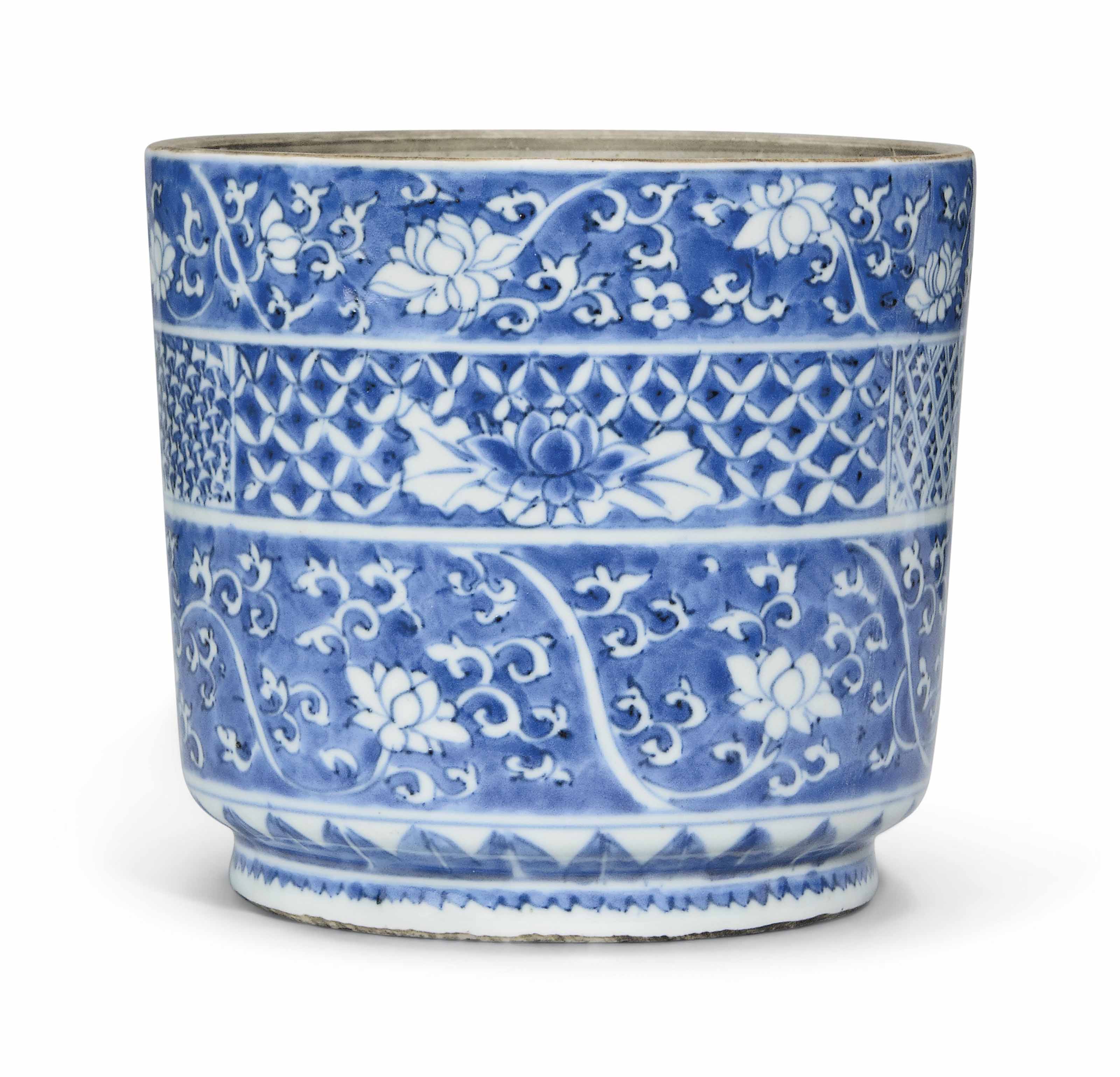
成交總額GBP 8,125
估價GBP 2,000 – GBP 3,000
A BLUE AND WHITE KO-SOMETSUKE JAR
17TH CENTURY
The cylindrical jar is painted to the exterior with two bands of scrolling lotus branches on a blue ground, surrounding a central band of peony, prunus and lotus blooms reserved on various diaper grounds.
6 ¼ in. (15.9 cm.) high
來源
Formerly in a private American collection
参考:The David Vases (Chinese porcelain)
These vases are among the most important examples of blue-and-white porcelain in existence, and are probably the best-known porcelain vases in the world.

They were made for the altar of a Daoist temple and their importance lies in the dated inscriptions on one side of their necks, above the bands of dragons. The long dedication is the earliest known on Chinese blue-and-white wares.
The dedication

The dedication records that in 1351 a man named Zhang Wenjin from Yushan county presented these two vases and an incense burner (the whereabouts of which is unknown), to a Daoist temple in Xingyuan (modern day Wuyuan county). Yushan county is in northeast Jiangxi, which lies 120 km to the southeast of Jingdezhen, where these vases were made. This inscription demonstrates that blue-and-white porcelain production was already well-established at Jingdezhen by 1351. Originally the vases, modeled after bronzes, had porcelain rings attached through the elephant head shaped handles.
These vases were owned by Sir Percival David (1892–1964), who built the most important private collection of Chinese ceramics in the world.
参考:纽约大都会博物馆 波斯 青花鹿纹碗 Bowl with Deer Motif, Stonepaste; underglaze painted (Sultanabad ware)
14th century
A spotted deer rests against a foliate background in this blue and turquoise underglazed bowl from Iran. The animal looks upward, perhaps in reference to the motif of a deer gazing at the moon. This design, borrowed from Chinese Buddhist symbolism, was called jairan and used in a variety of media during the Ilkhanid period. One of a group of works associated with Sultanabad, this bowl and others like it were more likely produced in Kashan. The white glaze that once covered the exterior of the bowl is now faded, revealing the pinkish body of the stonepaste below.




Object Details
Title:Bowl with Deer Motif
Date:14th century
Geography:Made in Iran, probably Kashan
Medium:Stonepaste; underglaze painted (Sultanabad ware)
Dimensions:H. 4 3/8 in. (11.1 cm)
Diam. 7 7/8 in. (20 cm)
Classification:Ceramics
Credit Line:H.O. Havemeyer Collection, Gift of Horace Havemeyer, 1941
Accession Number:41.165.43
Provenance
H. O. Havemeyer Collection, New York (by 1931–41; gifted to MMA)
Exhibition History
New York. The Metropolitan Museum of Art. “Ceramic Art of the Near East,” 1931.
New York. The Metropolitan Museum of Art. “Splendid Legacy: The Havemeyer Collection,” March 27, 1993–June 20, 1993, not in catalog.
References
Dimand, Maurice S. “The Metropolitan Museum of Art, New York, May 12–June 28, 1931.” In Loan Exhibition of Ceramic Art of the Near East. New York, 1931.
Timeline of Art History
Timelines
Iran, 1000-1400 A.D.
参考:纽约大都会博物馆 波斯 青花盘 Dish, Earthenware; white slip with monochrome slip decoration under transparent glaze
probably 14th century



Object Details
Title:Dish
Date:probably 14th century
Geography:Probably from Iran, Nishapur
Medium:Earthenware; white slip with monochrome slip decoration under transparent glaze
Dimensions:H. 3 1/4 (8.3 cm)
Diam. 15 3/4 in. (40 cm)
Classification:Ceramics
Credit Line:Rogers Fund, 1936
Accession Number:36.20.4
Provenance
1935, purchased in Nishapur, Iran by the Metropolitan Museum of Art’s expedition; 1936, accessioned by the Museum
Exhibition History
Chicago. Smart Museum of Art, University of Chicago. “Blue and White: Chinese Porcelain and Its Impact on the Western World,” October 3, 1985–December 1, 1985, no. 64.
References
Carswell, John. “Catalogue of an exhibition at David and Alfred Smart Gallery, University of Chicago.” In Blue and White: Chinese Porcelain and Its Impact on the Western World. University of Chicago: University of Chicago, 1985. no. 64, p. 123, ill. (b/w).
Golombek, Lisa, and Robert Barry Mason. Tamerlane’s Tableware : A New Approach to the Chinoiserie Ceramics of Fifteenth and Sixteenth Century Iran. Toronto, Canada: Lisa Golombek, 1994. pp. 203, 247, ill. pl. VII (color), pl. 44 NM7 (b/w).
Timeline of Art History
Timelines
Iran, 1000-1400 A.D.
参考:纽约大都会博物馆 青花折枝花碗 Bowl, Earthenware; glazed
17th century



Object Details
Title:Bowl
Date:17th century
Geography:Attributed to Iran
Medium:Earthenware; glazed
Dimensions:H. 3 5/8 in. (9.2 cm)
D. 7 1/4 in. (18.4 cm)
Classification:Ceramics
Credit Line:Harris Brisbane Dick Fund 1966
Accession Number:66.107.4
Signatures, Inscriptions, and Markings
Marking: underside of base in blue: pseudo Chinese
Provenance
Private collection, Switzerland (until 1966); [ Klaus Hönisch, Munich, 1966; sold to MMA]
Timeline of Art History
Timelines
Iran, 1600-1800 A.D.
参考:纽约大都会博物馆 青花 鹿风纹碗 Bowl with Deer and Phoenix Motifs, Stonepaste; blue and black painted under transparent glaze (Sultanabad ware)



first half 14th century
This bowl is a fine example of the so-called ‘Sultanabad’ wares which were produced during the Ilkhanid period. This type is characterized by a distinctive glaze, incorporating fine underdrawing in black or grey-green, often combined with cobalt and turquoise accents.
On view at The Met Fifth Avenue in Gallery 455
Object Details
Title:Bowl with Deer and Phoenix Motifs
Date:first half 14th century
Geography:Attributed to Iran, probably Kashan
Medium:Stonepaste; blue and black painted under transparent glaze (Sultanabad ware)
Dimensions:Diam. 6 5/8 in. (16.8 cm)
H. 2 3/4 in. (7 cm)
Classification:Ceramics
Credit Line:Rogers Fund, 1970
Accession Number:1970.27
Catalogue Entry
Bowl
This bowl is illustrative of one of the three types of Sultanabad ware so called after the modern city of the same name in the region where most of this ware was found. The painting on this type of Sultanabad pottery is done directly on the white body, and the decoration is characterized by an interior design (here of a recling quadruped and three birds in flight) totally outlined in greenish black with its background completely filled in with cobalt blue.
The oversized foliage consisting mainly of trefoil-shaped leaves, which shield an occasional Chinese lotus flower seen on both the interior and exterior, and the long-tailed Chinese phoenix, are all typical features of this ware.
Marilyn Jenkins in {Berlin 1981]
Provenance
Textile Museum, Washington (until 1970; sold to MMA)
Exhibition History
Berlin. Museum für Islamische Kunst, Pergamonmuseum, Staatliche Museen zu Berlin. “The Arts of Islam. Masterpieces from the M.M.A.,” June 15, 1981–August 8, 1981, no. 34.
References
“Masterpieces from The Metropolitan Museum of Art New York.” In The Arts of Islam. Berlin, 1981. no. 34, pp. 98–99, ill. p. 99 (b/w).
Timeline of Art History
Timelines
Iran, 1000-1400 A.D.
IMPORTANT CHINESE ART
11 SEPTEMBER 2019 | 10:30 AM EDT NEW YORK
704 IMPORTANT CHINESE ART, SOLD BY THE ART INSTITUTE OF CHICAGO
A PAINTED ‘CIZHOU’ JAR, SONG / JIN DYNASTY

30,000 — 50,000 USD
A PAINTED ‘CIZHOU’ JAR
SONG / JIN DYNASTY
well-potted, of slightly compressed globular form rising from a short spreading foot, the body deftly painted on the exterior with a wide, continuous band of interlaced ‘cash’ symbols in dark brown slip against an ivory-white ground, all beneath a lustrous transparent glaze stopping short of the base revealing the buff-colored stoneware body, the interior a plain creamy-white
Height 5 5/8 in., 14.3 cm
PROVENANCE
Collection of Mrs. Potter Palmer (1849-1918) and thence by descent.
Gifted to the Art Institute of Chicago, Chicago by Bertha Palmer Thorne (1911-1974) in 1973 (acc. no. 1973. 825).
LITERATURE
Freedom of Clay and Brush through Seven Centuries in Northern China: Tz’u-chou Type Wares, 960-1600 A.D., Indianapolis Museum of Art, Indianapolis, 1980, p. 152, fig. 173.
CATALOGUE NOTE
Usually painted with floral motifs, examples decorated with similar ‘cash’ patterns are exceptionally rare. An incised jar of the same form and decoration but with the design in white on a dark brown ground, from the Linyushanren Collection, is illustrated in several publications including Special Exhibition, Charm of Black & White Ware; Transition of Cizhou Type Wares, The Osaka Municipal Art Museum, Osaka, 2002, cat. no. 47, and was sold at Christie’s New York, 22nd March 2018, lot 508. For a vessel of the same form with dark brown painted floral decoration, see an example excavated at the Guantai kiln, Hebei, illustrated in Guantai Cizhou yaozhi [The Cizhou Kiln Site at Guantai], Beijing, 1997, pl. XIV, no. 2.
参考:Sotheby’s IMPORTANT CHINESE ART
A LARGE BLUE AND WHITE ‘WINDSWEPT’ JAR
MING DYNASTY, MID-15TH CENTURY
明 青花 卷云开光神仙人物纹将军罐
13 SEPTEMBER 2017 | 10:00 AM EDT NEW YORK
PROPERTY FROM A PROMINENT PRIVATE COLLECTION

MING DYNASTY,

MING DYNASTY
40,000 — 60,000 USD
DETAILS & CATALOGUING
A LARGE BLUE AND WHITE ‘WINDSWEPT’ JAR
MING DYNASTY, MID-15TH CENTURY
sturdily potted, the baluster body rising from a slightly splayed foot to a short tapered neck and rolled rim, skilfully painted in deep tones of underglaze blue in the ‘windswept’ style with three groupings of figures, one depicting two scholars playing weiqi, observed by an Immortal, possibly Dong Wang Gong, bearing a ruyi scepter, another of Xi Wangmu, the Queen Mother of the West, wearing long flowing robes and holding a basket of peaches, flanked by female attendants, and a third of an immortal accompanied by two attendants, one bearing a wrapped qin, together with a spotted deer grasping a lingzhi sprig, each scene framed by wispy clouds, all set between a band of upright lappets and a broad register of alternating shaped cartouches enclosing floral sprays and florets reserved on a diaper ground at the shoulder, the neck painted with a diaper border
Height 15 1/8 in., 38.3 cm
PROVENANCE
Sotheby’s London, 14th November 2001, lot 99.
CATALOGUE NOTE
The present guan jar belongs to a group of large blue and white jars and meiping decorated in the painterly ‘windswept’ style with figures in landscape and garden setting after traditional literature and drama. The panoramic landscape is comparable to landscape paintings of the early Ming period, and the continuity of the scene is achieved by a line of curled clouds in the sky of the main register of decoration.
Compare two jars similarly painted with an Immortal observing a game of weiqi, but flanked by the Eight Daoist Immortals, the first in the Palace Museum, Beijing, illustrated in The Complete Collection of Treasures of the Palace Museum. Blue and White Porcelain with Underglaze Red (I), Hong Kong, 2000, pl. 183, and the second in the Idemitsu Museum of Arts, Tokyo, illustrated in Gen Min no tōji [Yuan and Ming ceramics], Idemitsu Art Gallery, Tokyo, 1977, cat. no. 43. Further guan painted with the same subject include one sold in our London rooms, 15th December 1981, lot 185; another sold at Christie’s New York, 24th March 2004, lot 175, and a third sold in our Hong Kong rooms, 8th April 2007, lot 845.
参考:Sotheby’s London 283 IMPORTANT CHINESE ART
PROPERTY FROM AN ASIAN PRIVATE COLLECTION
元 青花 凤穿花纹玉壶春瓶 A BLUE AND WHITE ‘PHOENIX’ VASE, YUHUCHUNPING
YUAN DYNASTY
此玉壶春瓶可见为景德镇元代青花的典型器,修长俊美,胎薄体轻。瓶通体内外满布八层青花纹饰,以凤穿花纹为主体,又自上而下辅以卷草纹、蕉叶纹、回纹、钱纹、莲瓣纹等元代流行纹样.主纹双凤穿于繁花之间,展翅腾飞,高贵典雅;辅助纹饰繁而不乱,层层呼应,相互益衬,既有承宋代隽秀素雅之风,又甚见元青花之异域色彩。
青花凤穿花纹者颇为鲜见,倍受藏家珍视。缠枝花卉纹以其连绵不断之形,寓有“生生不息”之意,故又称“万寿藤”,常与龙凤、鸟兽、人物等组合为装饰纹样,寓意吉祥。而缠枝花卉纹与凤纹相配,称为“凤穿花”。凤为百鸟之后,象征母仪天下,更有天下安宁祥和之意。飞凤以花相拥,寓意吉庆祥瑞。与设色高雅的青花相衬,更突显了一份娇艳柔美的气质,风华绝代,分外难得。
玉壶春瓶由宋人诗句中“玉壶先春”一词而得名,始见于宋代而一直延烧至今。许之衡《饮流斋说瓷》记:“玉壶春口颇侈,项短腹大,足稍肥,亦雅制也”,元代景德镇窑生产的玉壶春形制,相较于明清样式瓶颈细长,腹部较小。现藏于中国国家博物馆元青花凤穿花纹玉壶春瓶与此瓶近似,可资参阅。
参阅:
中国国家博物馆藏-元 青花凤穿花玉壶春瓶
参阅:
《陶磁大系41ー元の染付》平凡社,昭和49年12月20日62页、图版58
釉里红瓷器以其难得一见及巧夺天工而闻名于世,但除此之外尚有另一个原因。自古以来,中国人均视红色为吉祥喜庆的象征。据《大明会典》记载,洪武二年(公元1369年)皇上诏令,宫廷祭祀所用的金属器物概由瓷器代替。当时,每个祭坛皆有其特定的颜色,而代表朝日坛的正是赤色。话虽如此,由于釉里红瓷器制作困难,再者成品率低,因此其生产制造在中国的陶瓷手工业历史中曾数度中止。正是为此,传世的釉里红或白地描红瓷器益显珍贵。
明代是中国瓷器史上光辉灿烂的时代,尤其是集合一流能工巧匠与艺术家们所共同制作的官窑,其成就更是令人赞叹。通过明初洪武的坚实基础,到了永乐、宣德、成化等朝代形成了明代瓷器的鼎盛期,随着制瓷技术的演进与各朝皇帝的爱好,各种前代所未见到的瓷器被成功地烧制出来,譬如洪武釉里红、永乐甜白、宣德青花、成化斗彩、弘治娇黄、嘉万五彩代表了明代官窑瓷器的最高成就,其器形、纹饰、发色成为历代模仿的典范。但由于战乱、天灾及日常损耗,使得明代官窑瓷器甚为罕见,极具收藏价值。

A BLUE AND WHITE ‘PHOENIX’ VASE, YUHUCHUNPING
YUAN DYNASTY
20,000 — 30,000 GBP
LOT SOLD. 106,250 GBP
DETAILS & CATALOGUING
A BLUE AND WHITE ‘PHOENIX’ VASE, YUHUCHUNPING
YUAN DYNASTY
the pear-shaped body rising from a spreading foot to a slender waisted neck flaring at the rim, painted in vivid shades of cobalt-blue with a pair of phoenix in flight amidst meandering lotus scrolls between cash coin and diaper bands, all between broad lappet bands around the shoulder and foot, the neck encircled by upright plantain leaves above a keyfret band, the interior rim with a classic scroll
25.5cm., 10in.
PROVENANCE
Sotheby’s London, 14th November 2001, lot 95.
参考: EDEN Fine Antiques Galleries > DAY-1 2016 AUTUMN ASIAN & EUROPEAN ANTIQUES > Lot 50 元 青花 凤穿花纹玉壶春瓶 YUAN BLUE & WHITE PHOENIX PEAR VASE, YUHUCHUNPING
元 青花 凤纹玉壶春瓶

YUAN BLUE & WHITE PHOENIX PEAR VASE, YUHUCHUNPING

YUAN BLUE & WHITE PHOENIX PEAR VASE, YUHUCHUNPING

YUAN BLUE & WHITE PHOENIX PEAR VASE, YUHUCHUNPING

YUAN BLUE & WHITE PHOENIX PEAR VASE, YUHUCHUNPING
















Item Description
Yuan Dynasty, finely potted in Chinese traditional YuHuChun shape vessel, ‘the pear shaped’ bottle vase, a bottom-heavy body tapered gracefully to slender waisted neck flaring at the rim, supported on short spreading foot ring. Painted in various tones and shades of cobalt-blue with phoenix interspersed by scrolling leafy uptala, the night lotus blooms, all between broad lappet bands around the shoulder and foot, the neck encircled by upright plantain leaves above a key fret band, the interior rim with a classic scroll. The glaze stopping before the foot rim, revealed the pale-creme ground, with orange and grayish firing marks. The receded central under base remain white underglaze. The pear vase elegantly presented upon a carved hardwood stand.
Prob. from Yuan Dynasty Period.
Dimension: 10″ H x 5-1/2″ W ; (only Stand) 1-/12/” H
PROVENANCE: The items that we have the privilege of marketing for our consignor come with some history, These items are reported to have been purchased from The Revelations Antique shop operated by Kurt Kjellin for more than 40 years. The consignor on numerous business trips to New York would visit the East Village shop to find rare and unique items to add to his personal collection.
参考:雍正 青花团凤纹八棱菱口碗




本对碗为雍正官窑之旷世隽品,极负盛名。其形端庄秀雅,简洁清新,呈葵瓣花口八棱式,尽显曲线变化之佳妙。釉汁凝润泛青,胎骨坚致细薄,执之品鉴,纤巧怡人。该对碗自口、身、足皆为八棱,其胎质细白致密,釉面的质、色感为亮、白、硬、润。
装饰的团凤纹极为尊贵,只能御用和皇后之用。在同时期的其它御用器物皆须按照此既定的底本使用。整器胎骨轻薄坚致,釉水明丽温润,碗底青花双圈内书“大清雍正年制”六字双行楷体款识,中锋运笔,藏锋写出,于稚拙之中自见笔力雄劲。
碗心亦绘团凤一只,雄姿遒劲,气夺千里。外璧饰以八组青花无框团凤纹,方寸之际,威势凌人。绘画精到有神,青花一色苍妍舒雅,墨势浑然而庄重,随着颜色的不断加深而越来越丰富,泛出浓妍之锡光,构图简单舒展,充满了灵动隽秀,更具文人的清雅稚拙,诚为雍正官窑之妙品。
整器修胎极为规整考究,胎釉浑然一体,丽质非凡,荡漾出雍正御瓷独有的温婉之气。碗形艺术构思高妙,烧制工艺精美,体现了雍正官窑青花的烧造技艺。雍正朝以后的瓷器上经常可以看到这种由数枚团花自由组合而成的图案。
御窑厂良工以其炉火纯青的技艺,将纹饰描绘得灵动逼真,为清雍正朝官窑小件之精品。雍正朝瓷器为何如此般精美细腻,多源于胤禛具有近乎苛刻的审美性格,留心宫廷艺术品的制作,对瓷器纹饰讲究“文、雅、精、细”,设色搭配参考古画,得其精髓,故能运用自如。该碗流传至今且保存完整,更为难得。
Ref. 北京东正拍卖有限公司 > 2012秋季艺术品拍卖会 > 皇家长物—宫廷艺术专场 LOT号: 0227 明万历 官窑青花五彩瑞兽纹鼓式促织盖罐

拍品信息
作者 — 尺寸 高12cm
作品分类 陶瓷>明代彩瓷 创作年代 明万历
估价 RMB 5,000,000-6,000,000
成交价 RMB 8,395,000
HKD 10,351,418
USD 1,259,250
EUR 923,450
专场 皇家长物—宫廷艺术专场
拍卖时间 2012-10-31
拍卖公司 北京东正拍卖有限公司
拍卖会 2012秋季艺术品拍卖会
出版:《千禧年清翫雅集收藏展》鸿禧美术馆 2000年10月 P189
《香港苏富比三十周年》香港苏富比有限公司 2003年9月 P179
款识:大明万历年制
说明 来源:台湾“清翫雅集”藏家旧藏
记录:香港苏富比 1994年11月2日 Lot.54
说明:罐身似鼓,上配圆盖。此类盖罐可作棋盒或促织之戏,若器顶略凹,则作蟋蟀罐用。罐身及盖面均饰青花五彩麒麟瑞兽,四周点缀古松怪石祥花瑞草。五彩浓墨重彩,奔放明丽,极具万历风骨。此罐无论绘工色彩均达万历最高水准,且品相非常完整,同类器物存世极为稀少,该器原属于1867-88年间任中国海关的Iver Munthe DAAe之旧藏。
清宫旧藏盖盒,与本品相近者,现藏于北京故宫,见《故宫博物院藏文物珍品大系·青花釉里红(中)》,香港,2000年,图版181;东京出光美术馆藏品,也可资比较,见于《出光美术馆藏品图录—中国陶瓷》,东京,1987年,图版748;另有相类盖盒见于拍卖市场,惟设计与本品略有不同,售于香港苏富比2011年4月7日编号70。
参考:Sotheby’s 110 花賞瑶華:巴黎名藏中國藝術收藏 III
明萬曆 五彩瑞獸紋蓋罐 《大明萬曆年製》款

明萬曆 五彩瑞獸紋蓋罐 《大明萬曆年製》款

明萬曆 五彩瑞獸紋蓋罐 《大明萬曆年製》款

明萬曆 五彩瑞獸紋蓋罐 《大明萬曆年製》款

明萬曆 五彩瑞獸紋蓋罐 《大明萬曆年製》款

明萬曆 五彩瑞獸紋蓋罐 《大明萬曆年製》款

明萬曆 五彩瑞獸紋蓋罐 《大明萬曆年製》款
8,000,000 — 12,000,000 港幣
拍品已售 11,840,000 港幣 成交價 (含買家佣金)
拍品詳情
明萬曆 五彩瑞獸紋蓋罐
《大明萬曆年製》款
of barrel form, the exterior of the rounded sides boldly and freely decorated in the wucai palette with four mythical beasts, including two qilin, leaping through through a setting detailed with pine trees and jagged rockwork beneath cloud wisps, the mythical beasts vibrantly coloured and rendered with windswept manes and tails, all between bands of coin diaper and lotus scrolls encircling the rim and foot respectively, the unglazed base of the jar centred with a recessed glazed medallion enclosing an underglaze-blue six-character reign mark within a double-circle, the well-fitted cover with a raised border of multi-coloured scrolls, encircling the central medallion enclosing three further mythical beasts beneath a pine tree, the straight sides with a band of waves interrupted by florets
14.6 公分,5 3/4 英寸
相關資料
小罐怡情寓乾坤:萬曆款五彩蟋蟀罐及圍棋罐簡析
李寶平
明代瓷器中,鼓式蓋罐極罕。此萬曆款蓋罐,器形別緻悅目,以繽紛五彩,繪麒麟等瑞獸,姿態可愛之餘,矯健有勁。論紋飾,此器幾近與兩萬曆款五彩盒相同,惟比例有異,該二例均屬 1867-88年間任職中國海關之 Iver Munthe Daae 舊藏(圖一)。

明萬曆 五彩瑞獸紋鼓式蓋罐 《大明萬曆年製》款
Iver Munthe Daae 舊藏,香港蘇富比1994年11月1日,編號54
FIG. 1
明萬曆 五彩瑞獸紋鼓式蓋罐 《大明萬曆年製》款
Iver Munthe Daae 舊藏,香港蘇富比1994年11月1日,編號54
此類鼓式罐的具體用途尚有不同看法。有些可能是被萬曆帝用作蟋蟀罐,作為蟋蟀爭鋒鬥勇的天地,另有一些則可能作為御用圍棋罐,體驗黑白博弈之樂。流傳到日本後,此類鼓式罐以及相關蓋盒或罐更備受珍惜,不少用作茶道中盛水用的「水指」。在這惹人喜愛的瑞獸紋蓋盒以及相關器物中,寓藏有中國宮廷藝術、智謀戰略及怡情消遣等方方面面的豐富內涵,以及和日本文化交流的一面。
鬥蟋蟀在中國歷史久遠,後大盛於明朝,時人記述,嘗有一人,寵蟀死後,以「銀作棺葬之」,近似於佛教舍利葬具。瓷質鼓式蟋蟀罐,其蓋頂多略凹,始製於宣德年間,有關討論請見陸明華,《明宣德官窰蟋蟀罐》,台北, 1995年。萬曆年間,鬥蟋蟀極為風行,尤其是北京及南方一帶。萬曆帝憾以昏庸之名,永留青史,在位年間或曾沉迷此習。萬曆年間御製瓷質蟋蟀罐,有各式造型,詳見載於耿寶昌《明清瓷器鑑定》中之線描圖,香港,1993年,圖264。又可參考上海博物館藏盒,五彩繪爭珠雲龍,騰飛福山壽海之上,圖見陸明華,《上海博物館藏品研究大系.明代官窰瓷器》,上海,2007年,圖版3-104(圖二:)。
然此類鼓式蓋盒,常被定為圍棋罐,例如陸明華在其著作中指,前述上海博物館藏盒應為存棋之用,並引用《明神宗實錄》,記萬曆十二年(1584年)聖上「急缺上用各樣磁器」,包括圍棋、棋罐、筆管、各樣盒,出處同上,頁171。另一文獻《江西大志》則羅列萬曆十一年(1583年)所造各式御瓷,其中有「青花白地五彩雲龍棋盤」及「青花白地正面龍葵花梅花棋子」,詳見王光堯,《明代宮廷陶瓷史》,北京,2010年,頁93。上海藏五彩蓋罐,昔或如文獻所載,作棋罐之用,並與紋飾相配之棋盤、棋子成套。紐約大都會博物館藏一盒,與上海藏品類近,但蓋已佚失,或也為棋罐,圖見 Suzanne Valenstein,《The Herzman Collection of Chinese Ceramics》,紐約,1992年,圖版85。
練松柏藏萬曆款青花龍紋蓋盒,器形相類,曾展於《形秀色麗四代珍》,大維德基金會,倫敦,1992年,編號90,圖錄中指其乃棋罐。宋元年間,鼓式蓋盒確乃作棋罐之用。見兩出土御製青花龍紋盒例,相信乃元文宗在位年間(1328-32年)之物,展於《景德鎮出土元明官窰瓷器》,炎黃藝術館,北京,1999年,編號1-2(圖三),圖錄且載一陝西耀州窰發掘得之北宋青釉蓋盒,出土時內有棋子,同書頁13,圖9。明代魯荒王朱檀(1370-90年)墓出土帶蓋棋罐成對,內存黑白棋子,可供參考,收於展覽圖錄《明:盛世皇朝五十年》,大英博物館,倫敦,2014年,圖168。
對比前述例子及當今慣用棋罐,若用以儲棋,此品略嫌太大,或較宜於蟋蟀相鬥之用。文獻雖沒明確記載萬曆年間有否燒製蟋蟀罐以供御,但礙於鬥蟀之習,有違儒學,非為君之道,檔案中或以「各樣盒」概括之,也言之成理。
莫論用途,相類蓋罐也極罕。前述 Daae 舊藏二例,器略矮,其一現藏奧斯陸工藝博物館(Kunstindustrimuseet),刊於 Johanne Huitfeldt,《Porselenet fra Kina》,奧斯陸,1978年,頁80,另一器於香港蘇富比 1994年11月1/2日拍出,編號54,收錄於《香港蘇富比三十年》,香港,2003年,圖版176。另可參考與 Daae 舊藏例尺寸、比例相近之萬曆款五彩舞蹈人物蓋罐,據錄傳世僅止三例,極為珍罕,其中一器為靜觀堂舊藏,屬徐展堂故物,見同書圖版177,又收於《香港蘇富比二十年》,香港,1993年,圖版134,以及康蕊君,《玫茵堂中國陶瓷》,倫敦,1994-2010年,卷4,編號 1704,曾於倫敦佳士得2000年11月15日拍出,編號32,更二度售於香港蘇富比,分別為1990年11月13日,編號149,以及2011年4月7日,編號70(圖四)。

明萬曆 五彩雲龍紋蓋罐 《大明萬曆年製》款
玫茵堂收藏 香港蘇富比2011年4月7日,編號70
萬曆款蟋蟀罐,尚有其他器形,如清宮舊藏五彩龍紋六瓣花式盒,其蓋已佚,錄於《故宮博物院藏文物珍品全集.五彩.鬪彩》,香港,1999年,圖版32,又或扇形蓋盒,《機暇明道:懷海堂藏明代中晚期官窰瓷器》中便收錄了青花龍紋及青花五彩瑞獸紋例各一,可資參考,香港中文大學文物館,香港,2012年,編號102-103。
参考:美国纽约大都会博物馆所收藏的中国历代瓷器陈列在二楼亚洲馆 元青花鱼藻纹折沿瓷盘

直径45.7cm


大都会博物馆收藏的这件元代青花瓷盘,按陶瓷学者的定名习惯,应叫“元青花鱼藻纹折沿瓷盘”。盘体很大,盘壁缓弧,折沿圆口,形体优美,质地细腻,保存完好。盘内壁通体饰白地青花,内外共三层,盘腹两层,折沿一层,以弦纹间隔。盘中央主题纹样为鱼藻纹,浮萍之下水草中间,一条体态肥腴的鳜鱼(也称桂鱼)正在畅游,张口摆尾,背脊刺骨高耸,显示出这是一条健壮味美的南方名贵淡水鱼。这是元代文人绘画山水花草题材在瓷画上的反映,注重生态环境,强调生活情趣,讲究艺术意境,展示缤纷墨彩,鲜活可爱。鱼藻主题纹样外圈是缠枝莲花纹,六朵根盛叶茂的莲花围绕鱼藻纹展开,相互缠绕,同中有异,既有浓郁的装饰韵味,又深化突出了主题纹样,两者相得益彰,交相映辉,成为元代青花的经典纹样装饰。折沿部分为菱形辅助装饰纹带,空白菱形纹内以点青方法点出四瓣花朵,与内圈的白地青花形成鲜明的对比,富有变化,处处显示出元青花绘画艺术的娴熟。盘青花纹样主次分明,重点突出,主题鲜明,既有高超的绘画技艺,又有元代工艺美术的装饰技法,是画家与陶瓷艺术家的联袂杰作。
该盘是元青花瓷的典型品种之一,从尺寸上看,有大中小之分,从口沿上分有折沿、敛口、菱口之分。大盘多为折沿盘,口沿分菱花和圆口两类。大盘形体较大,一般口径都在40厘米以上,最大的近60厘米,以口径45厘米左右的盘比较多见。元代青花大盘国内收藏的比较少,仅见数件,地下出土的也不多见,而国外收藏反而多,总数超过百件。收藏元青花大盘的主要机构以土耳其托普卡比宫及伊朗阿迪比尔寺最为著名。除此之外,日本、英国、美国和法国等博物馆也有少量收藏。元青花大盘主要收藏于伊斯兰国家,这可能与十三、十四世纪中亚、西亚伊斯兰世界上流社会的日用高档瓷器大量需求与饮食习惯有关,大瓷盘可陈放大量食物,方便众人围座食用。这表明元青花大瓷盘可能更多的是外销。一些元青花大瓷盘绘有伊斯兰艺术风格纹样,应是来样加工的定烧外销瓷。而具有鱼藻纹、牡丹纹等中国元代绘画风格的元青花大盘,可能主要供元代皇室和蒙古贵族使用,元代汉族显贵较少使用大瓷盘,他们更青睐青花小盘、执壶、玉壶春瓶、梅瓶、罐等器皿,与汉人饮食方法、居住方式、家庭陈设及审美习惯有一定的关系。
参考:北京故宫博物院【釉里红拔白缠枝花卉纹碗】
撰稿人:黄卫文


釉里红拔白缠枝花卉纹碗,明洪武,高16.7厘米,口径42厘米,足径22.7厘米。
碗直口,深弧腹,圈足。内外均以釉里红为地作留白装饰,俗称“釉里红拔白”。内底一周回纹边饰内绘折枝牡丹纹,内壁绘缠枝莲纹。口沿内外绘卷草纹,外壁绘缠枝牡丹纹。近足处绘变形莲瓣含朵花纹。圈足外墙绘回纹。
此器造型硕大敦厚,纹饰画工精细,线条细腻流畅。此种釉里红拔白装饰技法与洪武时常见的白釉为地的釉里红器装饰方法正好相反,颇为少见。
撰稿人:黄卫文
关键词: 釉里红 缠枝 花卉 回纹 折枝 缠枝莲 卷草纹 卷草
釉里红拔白缠枝花卉纹碗,明洪武,高16.7cm,口径42cm,足径22.7cm。
碗直口,深弧腹,圈足。内外均以釉里红为地作留白装饰,俗称“釉里红拔白”。内底一周回纹边饰内绘折枝牡丹纹,内壁绘缠枝莲纹。口沿内外绘卷草纹,外壁绘缠枝牡丹纹。近足处绘变形莲瓣含朵花纹。圈足外墙绘回纹。
此器造型硕大敦厚,纹饰画工精细,线条细腻流畅。此种釉里红拔白装饰技法与洪武时常见的白釉为地的釉里红器装饰方法正好相反,颇为少见。
釉下彩品种之一,系以氧化铜为呈色剂在胎上彩绘,然后施釉,经高温一次烧成。因其在釉下彩绘,故称釉里红。釉里红的白地红花,色彩鲜艳,给人以热烈喜庆的感受,自元代创烧以来,一直受到人们的喜爱。由于铜对窑室内的气氛要求严格,高温下易挥发,因此烧成难度大。元与明初的制品有些呈色不稳定。明、清时烧制的釉里红色彩稳定,且更加艳丽,尤其是清雍正朝的釉里红,不仅色泽鲜红,而且成品率高。
中国传统装饰花纹之一。所绘花朵系以植物的枝干或蔓藤作骨架,枝叶相互缠绕,构成四方连续或二方连续的图案,统一中寓变化。有缠枝莲、缠枝菊、缠枝牡丹和缠枝宝相花等多种纹样。
古建筑彩画绘画的一种题材。清代中期之前多画绿叶子花卉,清代晚期画黑叶子花卉。家具上常用的纹饰之一,由陶器和青铜器上的雷纹衍化而来,寓意吉利深长,苏州民间称之为“富贵不断头”。在家具上,回纹主要作为边饰,用于边框、牙条、足端或束腰等处。家具上大量采用回纹见于清代。
花卉画的一种。画花卉不写全株,只画从树干上折下来的部分花枝,故名。有折枝梅、折枝莲、折枝牡丹、折枝果实等。
中国传统装饰花纹形式之一。其绘花朵上下周转,枝叶相互缠绕成图案形式,有缠枝莲、缠枝菊、缠枝牡丹等。以莲花为主题者,称缠枝莲。莲花是随佛教的传入而在中国的工艺品上流行开的。魏晋南北朝时佛教艺术在中国大为盛行,莲花便作为佛的象征而广泛出现在中国的工艺品上。南北朝时瓷器上的莲花瓣装饰十分普遍,成为这一时期瓷器装饰的标志性的纹样。此后,莲花就成为瓷器装饰中最普遍的纹样之一。
瓷器纹饰,又称卷叶纹或卷枝纹,宜于作各种器物的辅助纹饰。
17、18世纪传入中国的一种装饰花纹。俗称西蕃莲,如果没有花朵,则称为卷草。
关键词:釉里红
釉下彩品种之一,系以氧化铜为呈色剂在胎上彩绘,然后施釉,经高温一次烧成。因其在釉下彩绘,故称釉里红。釉里红的白地红花,色彩鲜艳,给人以热烈喜庆的感受,自元代创烧以来,一直受到人们的喜爱。由于铜对窑室内的气氛要求严格,高温下易挥发,因此烧成难度大。元与明初的制品有些呈色不稳定。明、清时烧制的釉里红色彩稳定,且更加艳丽,尤其是清雍正朝的釉里红,不仅色泽鲜红,而且成品率高。
缠枝
中国传统装饰花纹之一。所绘花朵系以植物的枝干或蔓藤作骨架,枝叶相互缠绕,构成四方连续或二方连续的图案,统一中寓变化。有缠枝莲、缠枝菊、缠枝牡丹和缠枝宝相花等多种纹样。
花卉
古建筑彩画绘画的一种题材。清代中期之前多画绿叶子花卉,清代晚期画黑叶子花卉。
回纹
家具上常用的纹饰之一,由陶器和青铜器上的雷纹衍化而来,寓意吉利深长,苏州民间称之为“富贵不断头”。在家具上,回纹主要作为边饰,用于边框、牙条、足端或束腰等处。家具上大量采用回纹见于清代。
折枝
花卉画的一种。画花卉不写全株,只画从树干上折下来的部分花枝,故名。有折枝梅、折枝莲、折枝牡丹、折枝果实等。
缠枝莲
中国传统装饰花纹形式之一。其绘花朵上下周转,枝叶相互缠绕成图案形式,有缠枝莲、缠枝菊、缠枝牡丹等。以莲花为主题者,称缠枝莲。莲花是随佛教的传入而在中国的工艺品上流行开的。魏晋南北朝时佛教艺术在中国大为盛行,莲花便作为佛的象征而广泛出现在中国的工艺品上。南北朝时瓷器上的莲花瓣装饰十分普遍,成为这一时期瓷器装饰的标志性的纹样。此后,莲花就成为瓷器装饰中最普遍的纹样之一。
卷草纹
瓷器纹饰,又称卷叶纹或卷枝纹,宜于作各种器物的辅助纹饰。
卷草
17、18世纪传入中国的一种装饰花纹。俗称西蕃莲,如果没有花朵,则称为卷草。
参考:藏品名称:明代洪武青花瓷缠枝牡丹纹大碗
博物馆名:台北故宫博物院藏品。









估价价格:馆藏珍品,无法估计价格。
藏品分类:
功能作用:盛装器
尺寸大小:高15.9厘米,口径41.3厘米,底径23厘米。
藏品年代:元
青花瓷 牡丹纹
鉴定鉴赏:本器呈直口,深弧壁,矮圈足。内外壁皆有纹饰,除碗心外,其馀部位的纹饰皆沿碗心呈连续性构图形成一圈,各圈纹饰以青线间隔。内壁近口沿处饰缠枝灵芝,中间主要纹饰区绘缠枝莲花纹八朵,其下为回纹,碗心画折枝牡丹花一枝呈三叉状,各带盛开的花朵与花苞。器外壁近口沿处饰波涛纹,中间主要纹饰区绘缠枝牡丹八朵,其下为花瓣内缀宝相莲花之莲瓣纹,圈足则饰回纹。其釉色,全器釉白部分略带灰色,青花釉色灰暗,多处有铁褐色斑点,为釉料含丰富铁质所致。器底与足底为砂底无釉,但有刷拭痕,呈火石红色。敞口,深弧壁,矮圈足。外壁口沿下方绘波涛纹,上下各饰两道青线。腹壁绘饰转枝四季花卉,腹底饰仰莲瓣纹,圈足外壁饰一圈回纹。器内壁碗心有一株牡丹花,周饰一圈回纹,腹壁饰缠枝番莲纹,口沿下方绘饰一圈转枝叶纹,上下各带两道青线。全器青花色泽黯淡。底部无釉,涂有红色厚汁。
參考: 洪武青花缠枝莲纹大碗

口径41厘米,底径22.7厘米,高16厘米
景德镇陶瓷考古研究所藏
直口,斜壁,矮圈足,火石红底。外壁绘缠枝莲纹。内壁饰缠枝菊纹。碗心一圈回纹内绘折枝莲与云肩纹各四朵,云肩内分别绘有折枝菊,中央绘莲瓣纹。青花浓艳,纹饰精美。作盛食器,如此大尺寸的碗是继承元代而来,可能是用于围桌共食的餐具。
參考:花口莲纹大碗
这是托普卡帕宫收藏的体形最大的一只青花碗,其尺寸是超群的,在全世界都极为罕见。这只碗的碗心绘有一朵翘枝莲花,四周环绕白云锦文、海浪等。外壁绘有翘枝莲花等精美纹饰,青花及留白交相辉映。
高清细节图再来一波
参考: 北京故宫博物院馆藏珍贵元青花图文赏鉴 元景德镇窑青花飞凤麒麟纹盘



青花飞凤麒麟纹盘,高7.9cm,口径46.1cm,足径26.1cm。
盘折沿,菱花式口,盘心坦平,圈足。通体施青白釉,底素胎无釉。盘内外绘青花纹饰多层。折沿上绘卷草纹,内壁青花网纹地上突出白色缠枝牡丹纹,盘心边缘环以卷草纹,中央青花地烘托麒麟、翔凤各一,空间衬以白色的莲花及朵云纹。盘外壁绘缠枝莲纹。
此器青花发色纯正,构图严谨。盘心纹饰寓意“威凤祥麟”以示天地祥和。元代青花瓷器装饰有两种形式:一种是以青花料直接在白色胎体上描绘纹饰。另一种是以青花为地,衬托白色花纹。这种装饰形式始于元代。留白纹饰都有凸起。此盘即为蓝地白花器之代表作。


参考:北京保利国际拍卖有限公司 > 2011年春季拍卖会 > 御制翡翠朝珠项链,宫廷艺术与重要瓷器工艺品
LOT号: 7279 明永乐 青花折枝寿桃花果大碗

拍品信息
作者 —
尺寸 直径34cm
作品分类 陶瓷>明代青花瓷器
创作年代 明永乐
估价 RMB 15,000,000-25,000,000
成交价 RMB 25,300,000 HKD 30,227,001USD 3,795,000EUR 2,783,000
专场 御制翡翠朝珠项链,宫廷艺术与重要瓷器工艺品
拍卖时间 2011-06-05
拍卖公司 北京保利国际拍卖有限公司
拍卖会 2011年春季拍卖会
说明 来源:海外资深藏家旧藏
参考:佳士得拍卖 11640 中国出口艺术品 纽约|2016年1月21日
拍品201|THE BETTY GERTZ ‘HATCHER CARGO’ COLLECTION
A LARGE DEEP ‘HATCHER CARGO’ BLUE AND WHITE BOWL
TRANSITIONAL, MID-17TH CENTURY
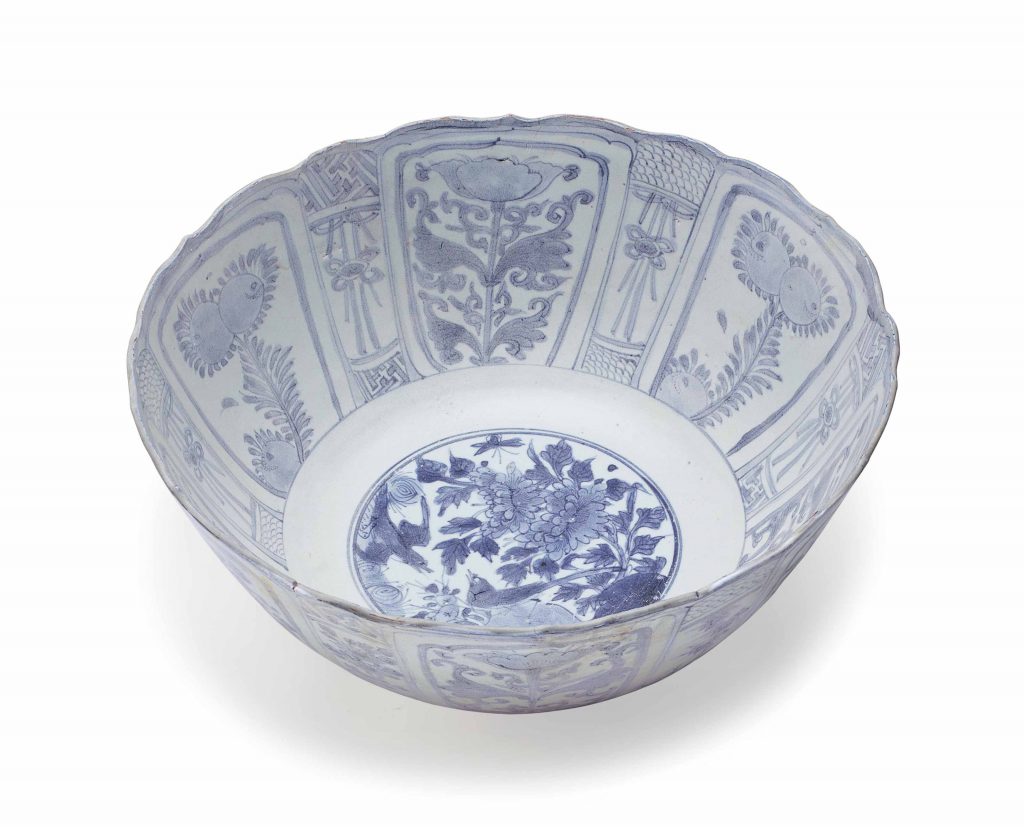
拍品201|THE BETTY GERTZ ‘HATCHER CARGO’ COLLECTION
A LARGE DEEP ‘HATCHER CARGO’ BLUE AND WHITE BOWL
TRANSITIONAL, MID-17TH CENTURY
成交总额 USD 5,250
估价 USD 1,500 – USD 2,500
A LARGE DEEP ‘HATCHER CARGO’ BLUE AND WHITE BOWL
TRANSITIONAL, MID-17TH CENTURY
The interior and exterior sides with radiating panels of flowers, fruit and emblems
14 in. (35.5 cm.) diameter
来源
The Property of Captain Michael Hatcher; Christie’s, Amsterdam, 14 March 1984, lot 18.
编制图录及详情
拍品前备注
THE BETTY GERTZ ‘HATCHER CARGO’ COLLECTION

![[临渊阁]天地一家春](https://www.antiquekeeper.ca/wp-content/uploads/2023/03/cropped-Asian-Art-Wallpaper-Painting3-6-1.jpg)

